
The Fenix 8 is here, bringing with it not just new hardware features, but also the end of the Garmin Epix lineup. Or, at least the end of it for now. Fear not though, that ending is merely in name only, as Garmin has consolidated the products under the Fenix branding instead. Still, the end result is effectively the same: There remains both MIP-based displays and AMOLED displays, albeit with substantially higher prices.
The Fenix 8 instead focuses on two key areas with its hardware improvements: The addition of a speaker & microphone for taking calls (with phone), a new offline voice assistance, and creating voice notes. Atop that, there’s the addition of a depth gauge and related scuba and free-diving functionality. The MIP-based Solar editions also see some solid battery gains with a new solar panel.
Whereas the majority of the changes on the Fenix 8 are focused on its significant user interface overhaul, essentially merging aspects of the Forerunner 965 interface with that of the Epix Pro, while concurrently revamping core widgets, settings, and workout/navigation areas to make it easier to understand, especially for new-to-Garmin users. Albeit as you’ll see, in my opinion, to mixed success.
As always, I’ve been putting all these units to the test with crazy long mountain hikes, runs, rides, swims, dives, and more. Finally, note that Garmin sent over media loaner units to test out. As usual, this review is not sponsored (nor does any company get to preview anything I review), and I don’t take any advertiser money from any companies I review. Once this unit goes back, I’ll go out and buy my own for any future testing needs. If you found this review useful, you can use the links at the bottom, or consider becoming a DCR Supporter, which makes the site ad-free. And, of course, it makes you awesome.
What’s New:
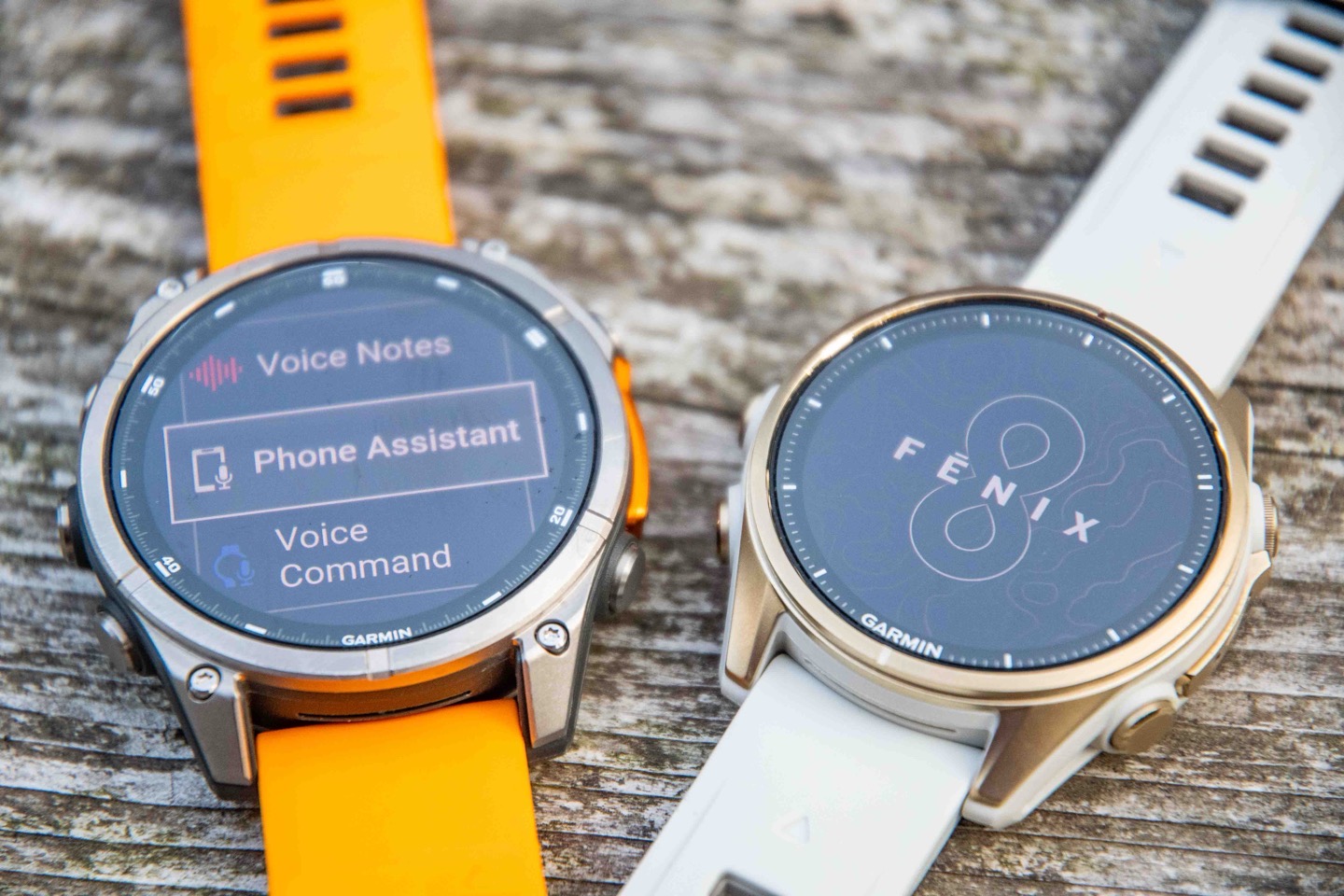
This Fenix release is a bit unusual in that the ‘What’s New’ section isn’t all that extensive. At least in terms of key features. Of course, the first bit isn’t hardware/features at all, but rather the same brand naming re-arranging, specifically:
– Fenix series (MIP-based displays) becomes known as ‘Fenix 8 Solar’
– Epix series (AMOLED displays) becomes simply ‘Fenix 8’ (and the Epix branding goes away)
At the end of the day, they’ve simply consolidated what are two identical watches in terms of software/features (with just different displays) into one brand name. Easy, right? Enduro remains Enduro and a MIP-based display, as the new Enduro 3 (review coming up in the next hours/days). Here’s the solar version:
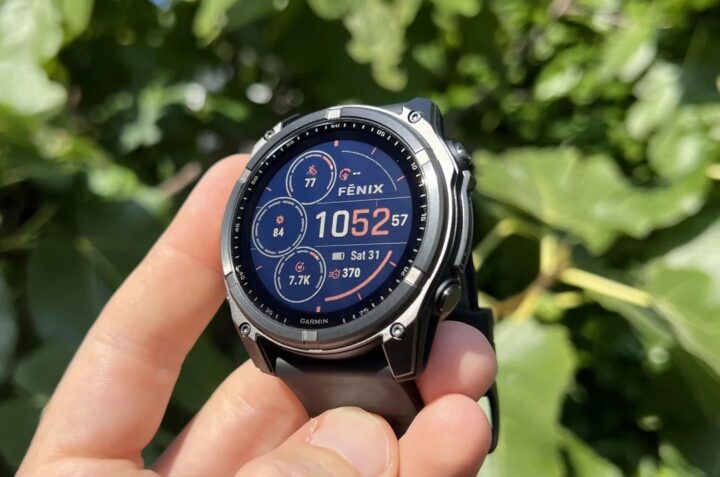
So then we get to the changes on the Fenix 8 front, and at a very distilled level, there are basically 4.5 changes:
– Adds microphone/speaker for calls/personal assistants
– Adds depth gauge and diving-related functions
– Increase display sizes for smallest watches (from 1.2” to 1.3, and 1.3” to 1.4”)
– [Solar edition only] Revamped solar panel to increase clarity and substantial increase solar-assisted battery life
– [Solar edition only] Killed off the smaller 42mm variant (Fenix S variants)
That’s kinda it. There are a slate of software updates below, but the vast majority of them are very minor UI updates. In total, it’s an appealing set of updates, but many of these updates would seemingly have been normal quarterly firmware tweaks. In fact, we’ve seen bigger Fenix quarterly updates from Garmin than the Fenix 8 updates, at least in terms of features or sports/fitness features.
Nonetheless, here’s the long list of little things that have changed (some tied to the hardware changes above are bigger, obviously):
– Hardware: AMOLED comes in three sizes: 43/47/51mm
– Hardware: Solar comes in two sizes: 47/51mm
– Hardware: [Solar edition only] New edge ring solar panel is far more efficient, and no longer covers display, improving clarity
– Hardware: New sensor guard protects microphone and barometer (between buttons)
– Hardware: New leak-proof button design using inductive buttons, so no actual hole in the case
– Added recreational scuba diving/apnea features, down to 40M with EN13319 certification
– Added diving no-fly and surface time features (widgets/data pages, etc…)
– Added access to phone assistant via microphone/speaker (with your smartphone)
– Added taking phone calls via microphone/speaker (with your smartphone)
– Added voice notes recorder (on watch)
– Added new offline voice assistant
– Added new maps radius zoom UI change
– Added new maps North Up quick toggle
– Added new maps layer selection quick access menu
– Added quick access touch unlock feature (temporarily unlocks touch, such as for a map during workout)
– Added new ‘Active Navigation’ menu system while navigating a course/waypoint/etc
– Added new consolidated ‘Saved’ feature, to find saved routes/waypoints/etc
– Added new dynamic round-trip routing, to auto—change route mid-way to achieve a specified distance if you go off-course (e.g. set for 5 miles)
– Added ‘Set a Target’ distance reminder, to remind you to turn around after the half-way point
– Added Ski difficulty tracking option
– Added strength training plans (4-6 weeks, via Garmin Connect)
– Added new watch face editor, and new watch faces
– Added new Countdown app to countdown to various dates/events
– Added new Focus Modes
– Added new online processing of troubled GPS tracks, using internal watch sensor data to correct them
– Major redesign of user interface, including widgets, settings, and activity/workout pages
– Revamped Notification Center to include Garmin-based notifications (e.g., Morning Report or Daily Summary)
It’s kinda hard to capture the ‘major redesign of user interface’ into a bunch of bullets, as most of it is just moving the cheese around to different places. As you can see, most of the above (like a north-up maps quick toggle) are very minor. Inversely, some like the dive sport profile is sprawling and quite extensive, very similar to their Descent MK3 (more on that in the dive section).
From a Solar-unit standpoint, here’s how the new solar panel impacts battery life when compared to the same sizes of the Fenix 7 Pro Solar editions:
GPS Only:
47mm: From 73 hours to 92 hours
51mm: From 122 hours to 149 hoursAll Systems GPS:
47mm: From 48 hours to 59 hours
51mm: From 77 hours to 92 hoursAll System + Multiband:
47mm: From 26 hours to 43 hours
51mm: From 41 hours to 65 hours
Remember, the solar panel is only paired/offered with the Fenix 8 Solar MIP-based units, not the AMOLED units. Here’s the full listing of battery specs:
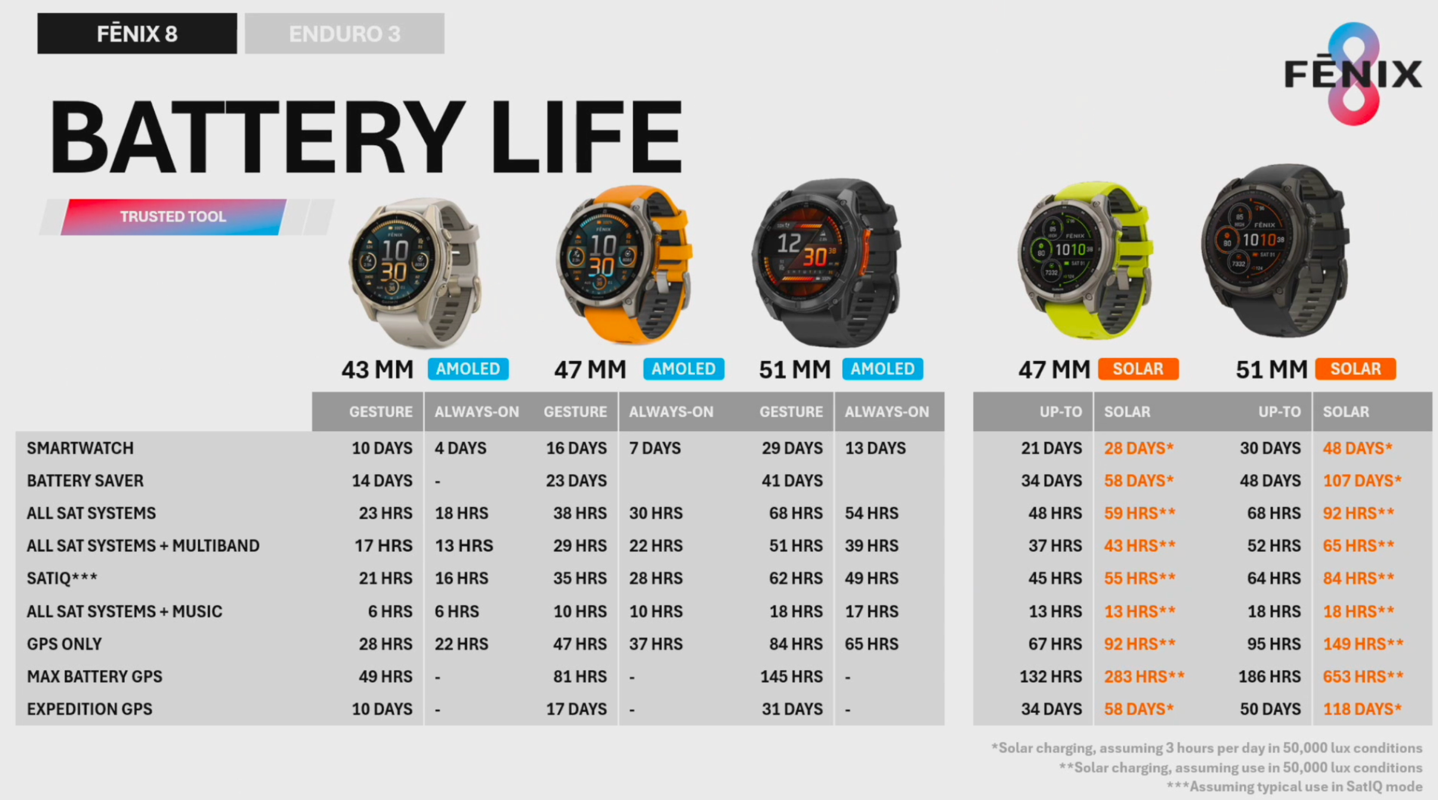
Moving on, we’ve got the big ticket item here in price increases. The cheapest Fenix offering is $999. The cheapest MIP-based offering went from $799 (Fenix 7S Pro Solar/7 Pro Solar) to $1,099 (Fenix 8 Solar) – a $300 price increase! The AMOLED went from $899 to $999 (again, comparing the least expensive offerings).
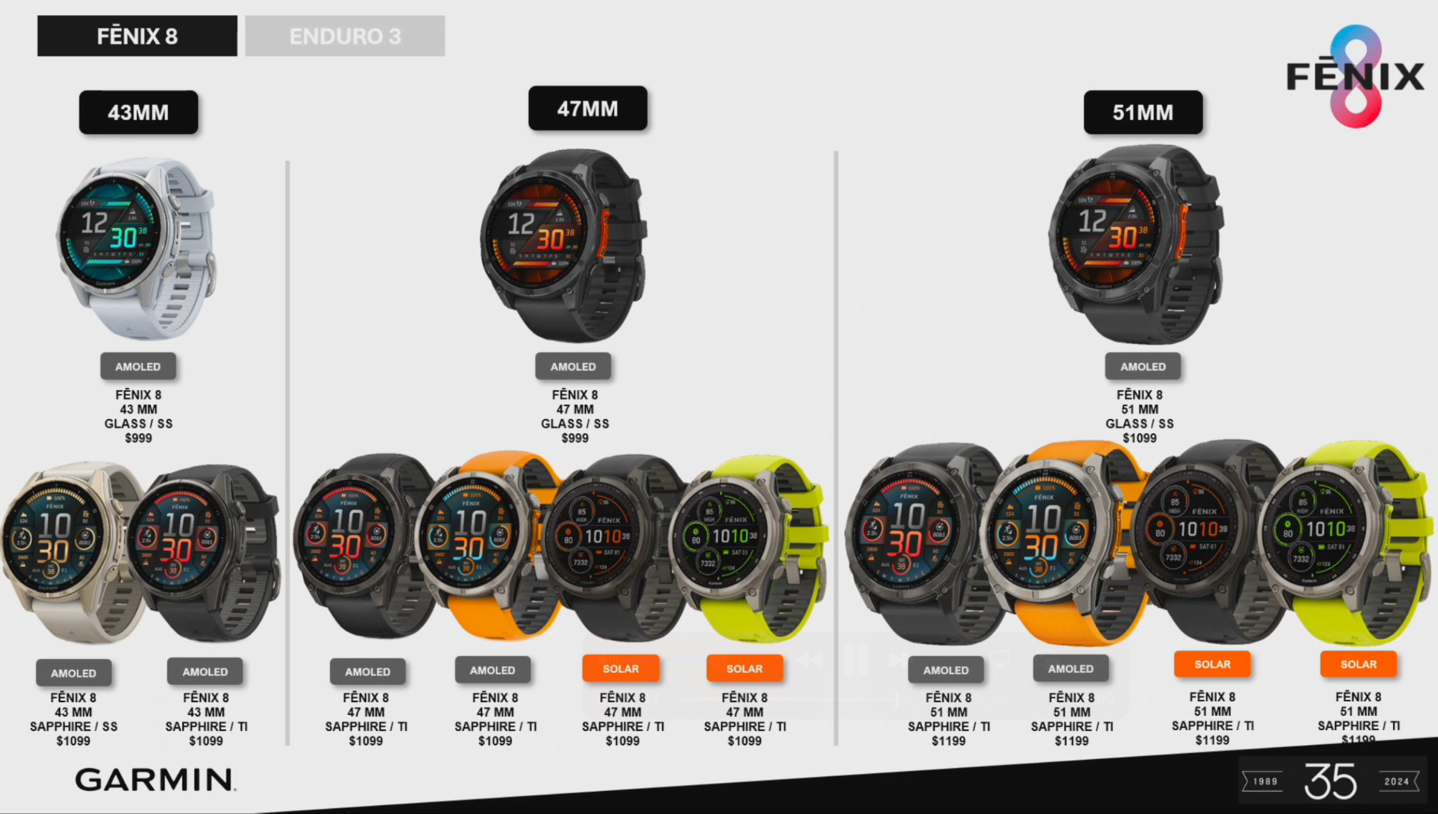
And here’s a different view looking at some of the core specs related to sizing:
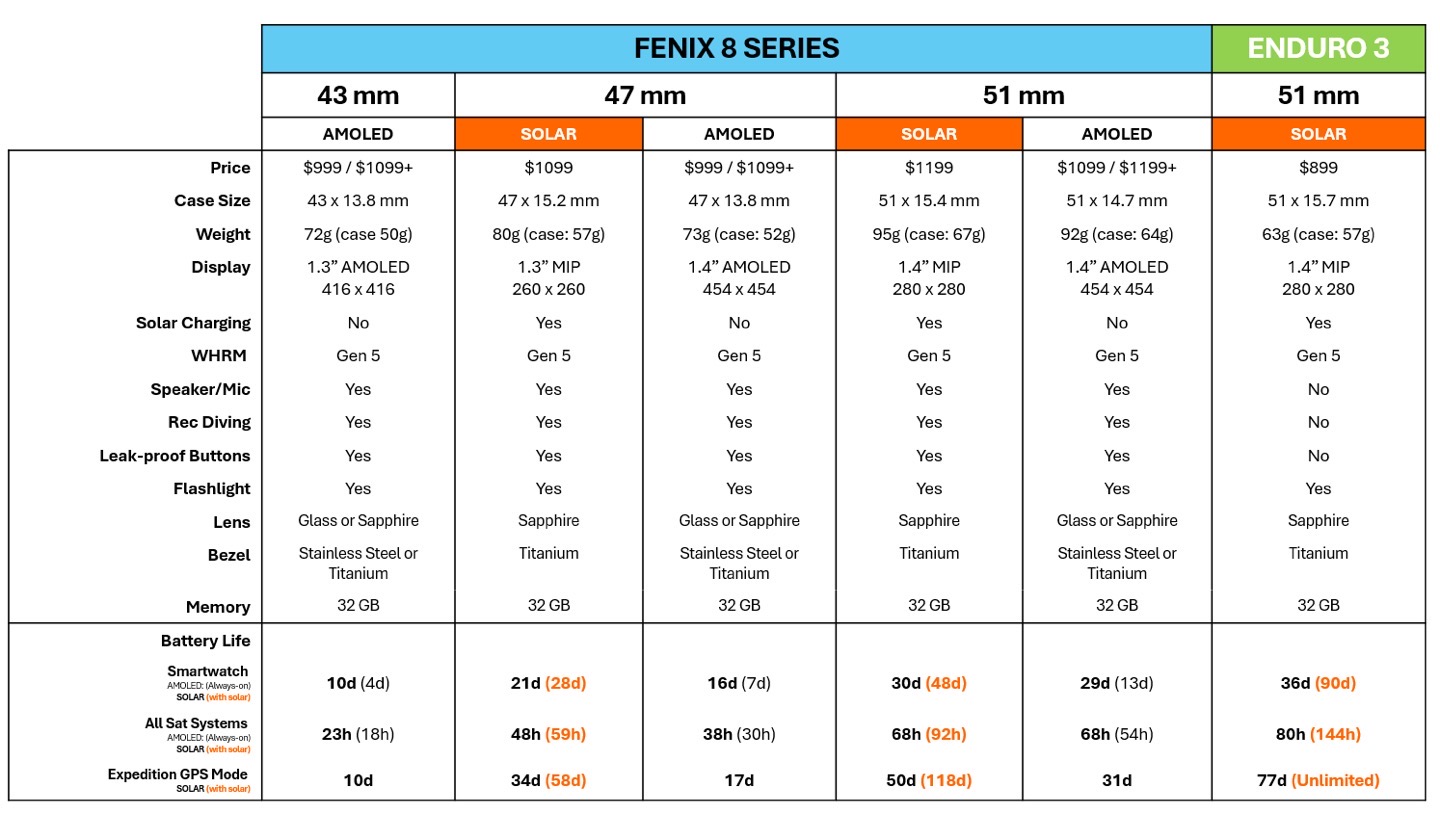
These price jumps should give many users pause. As I’ve said for 15 years in reviews: You can’t pretend to separate price from the equation. It’s an integral part of any product review, and how real-world consumers make decisions. Even more so when Garmin has had the Fenix 7 and Fenix 7 Pro on near-perpetual sales for the last 6-8 months. Had Garmin kept the prices the same here, and treated it as an annual incremental hardware upgrade (akin to what Apple does, and what Garmin has historically done), then the MIP-based units would have made much more sense.
The Basics:

In this section I’m going to cover some of the non-sports features. Things like daily activity/sleep tracking, updates to the user interface, as well as the new voice features. If you’re familiar with the Venu series, then the calling/voice features are largely the same as those watches. However, the Fenix 8 also introduces a new offline voice assistance and voice notes, which I’ll dive into in the following section.
First up though, is a quick reminder that Garmin’s Forerunner & Fenix watches all feature both 5 buttons as well as a touchscreen. This means that virtually every function/feature can be accessed by either control type. Meaning, if you like touch, you can do almost everything via touch. And if you hate touch, you can turn it off entirely. Your choice. You can even do it on a per sport profile basis.
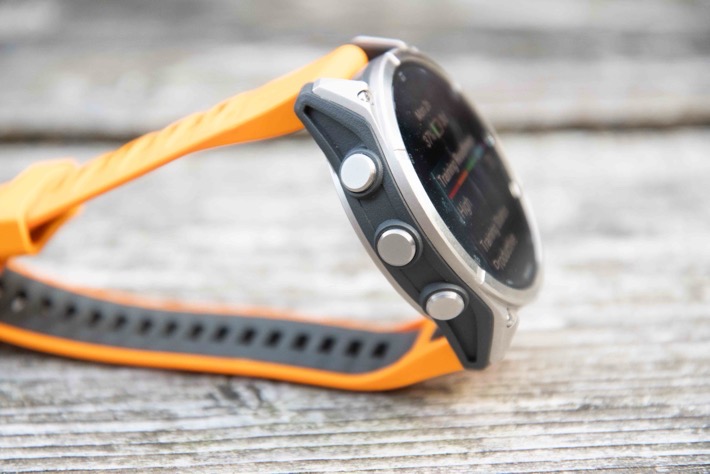

You’ll notice above, that orange strip between the two buttons on the right side. That hides/protects the speaker and barometer. The design element comes from the Descent, and is carried through here. Also carried over from the Descent diving watches are new “leak proof” buttons. While companies virtually never use “leak proof” in any wording, Garmin does here. And the reason makes sense.
Unlike past buttons which feature a hole in the internal case that the button pushes to activate (with seals/o-rings), there’s no hole here. Instead, it uses an inductive connection to detect the button push. This means there’s literally no hole in the internal case for the buttons. I had no problem with this design during my testing, though it does feel different. Thus, consider that for the first day or two of wearing it.
Moving back to the watch face, Garmin has launched new watch faces here, as well as redesigned how you configure the watch faces slightly. Ultimately, this seems like Garmin’s most customizable watch face to date. Now, I won’t lie: The first time I unboxed this unit, my initial thought was “Dear god, this default watch face is hideous.” But somehow, it’s grown on me, and I actually like it now. Go figure.
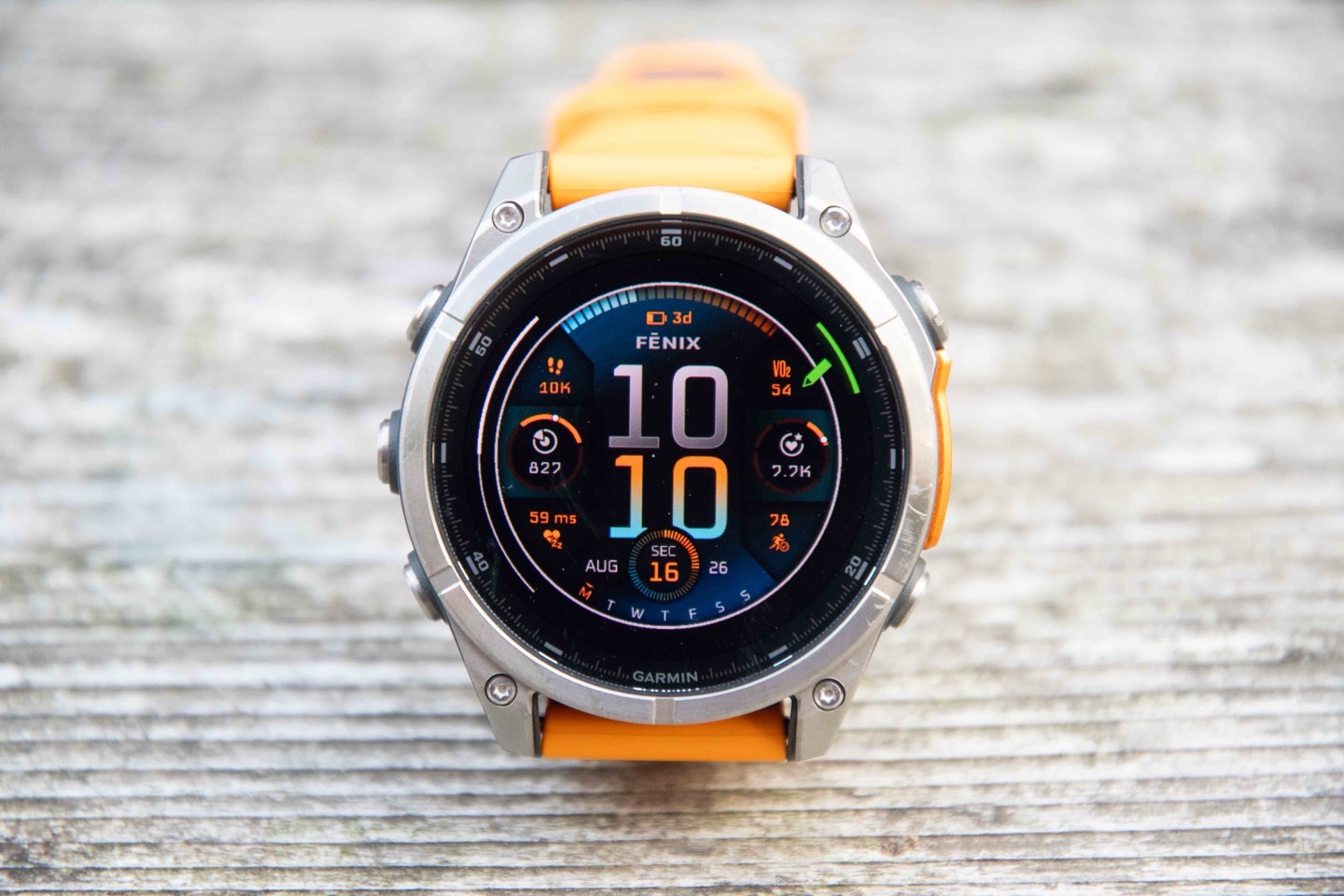
Of course, Garmin continues to have the deepest allowance of customization of any smartwatch out there, in terms of watch faces. You can make your own with the Garmin Connect IQ app, you can download thousands more, and even as of a few weeks ago, buy other watch faces too.
Once you get past the watch face, the first thing you’ll notice is the redesigned user interface. Garmin says they understand that having a new user interface for each and every watch isn’t ideal (something I’ve been harping on for years). This is their first go at consolidating these, going forward for new watches. Essentially it blends the Epix Pro & Forerunner 965 together, with touches of Venu 3. Said differently, it’s a threesome.
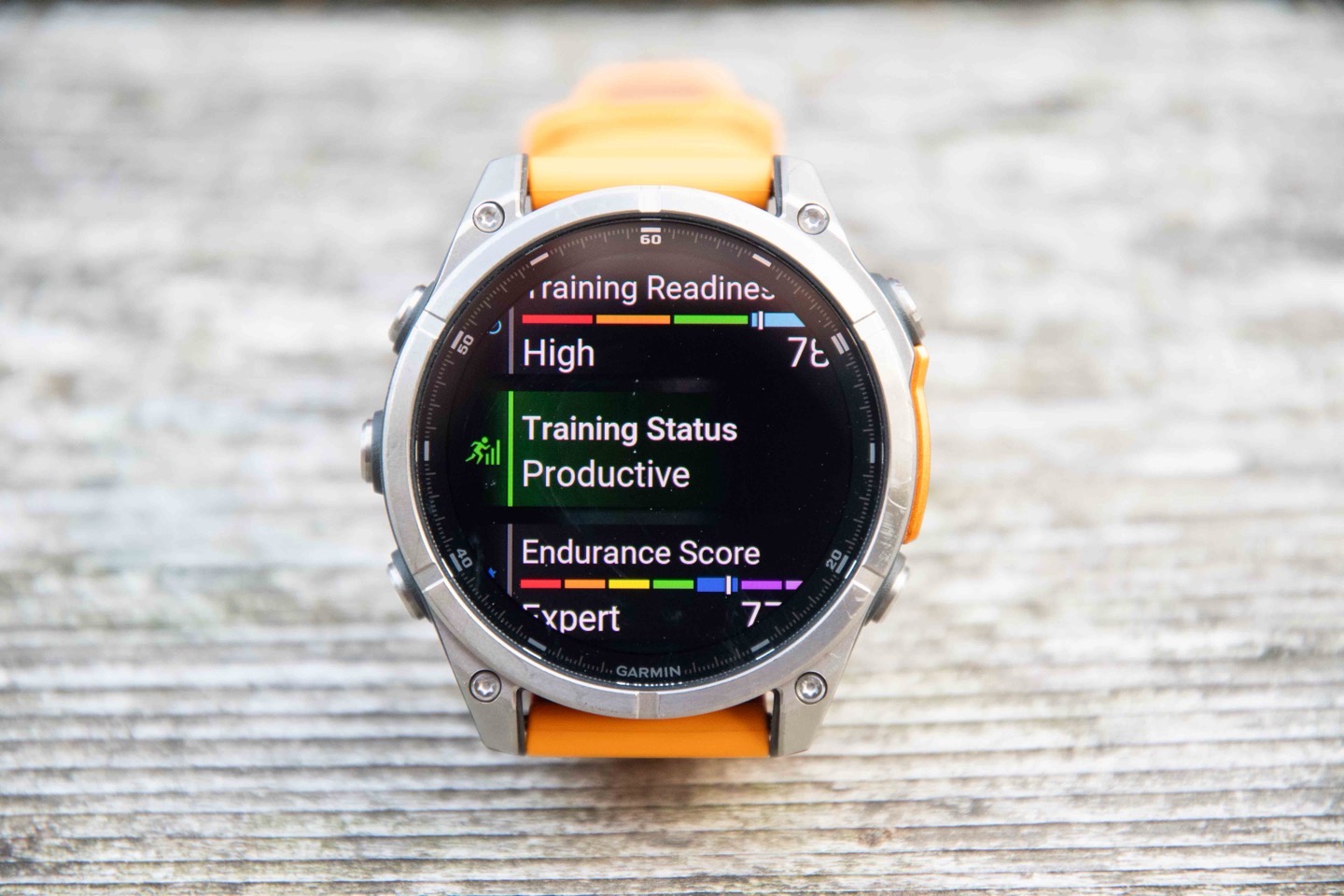
You’ll notice the first minor changes in the widgets/glances, such as for little charts and such. These are minor, but more polished touches than in the past. For those not familiar, the widget glances allow you to open up a given topic/data area, and then see more details. For example, if I were to tap on the ‘Steps’ one, I’ll see a few more full-screen pages about steps over the last 7 days:
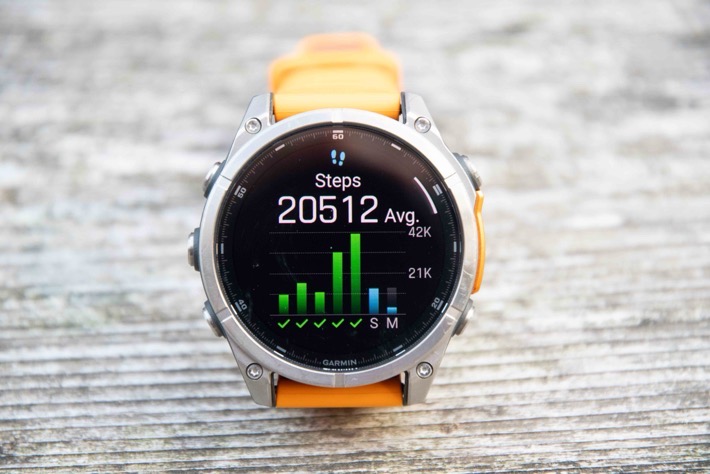
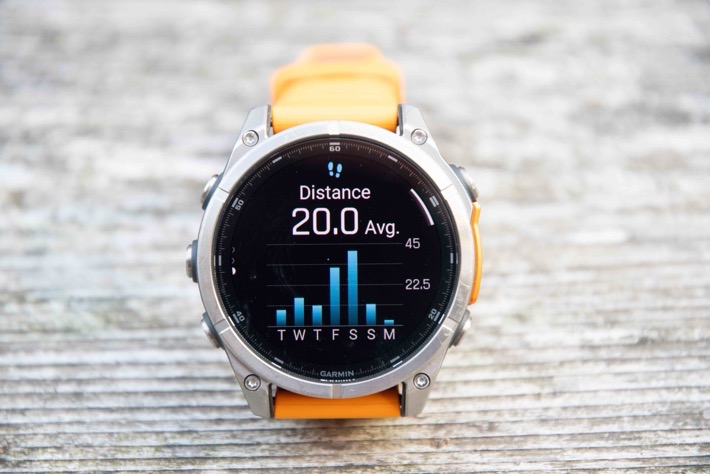
Likewise, the same is true for other watch glances. Here’s the sleep ones:

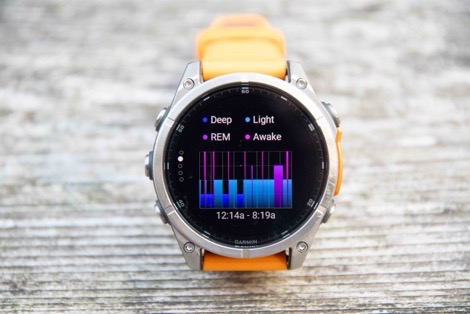
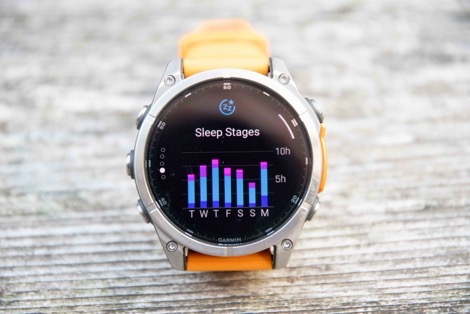
Speaking of sleep, and tracking, I saw no issues across all of my nights of sleep of correctly capturing the times I fell asleep and woke up. Garmin has continued to make really good strides here over the last few years in this area, specifically around how well it handles briefly waking up early in the morning if you’ve got kids or such (and then falling back asleep). It now handles that correctly each time.
As I note in my other reviews, when I look at sleep accuracy, I focus on the fall asleep/wake-up times. The reason I don’t rate sleep phases/stages, is that the technologies available to do so simply aren’t all that accurate. Comparing against even so-called ‘gold-standard’ options for sleep accuracy are only rated in the 80% range for accuracy. We’d never judge heart rate accuracy against something that was wrong 20% of the time (in a best-case scenario). Thus, it’s silly to do so here. Instead, I’m focused on whether it correctly marks the times I’m actually awake.
I do look at heart rate variability accuracy a bit more closely though, since we can compare that much more easily. The Fenix 8 captures your HRV data while you sleep, and trends it over time (you’ll need 19 nights of initial sleep data first though before it applies the colorful labels). And then from there it’ll give you trending data over time.
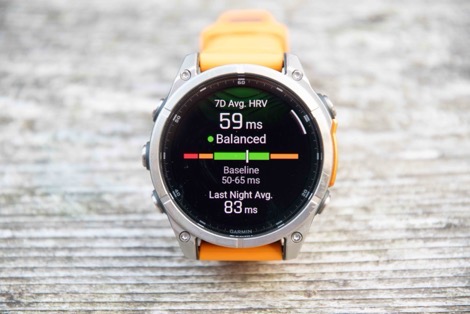
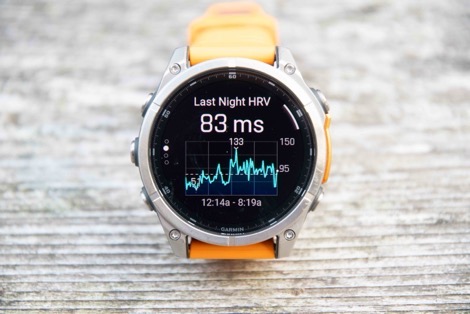
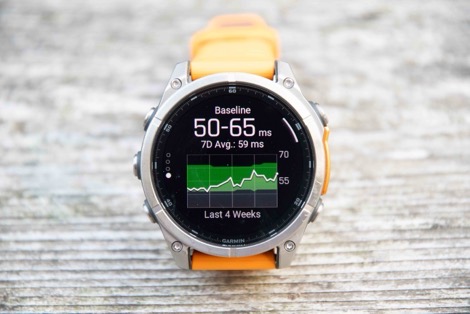
In fact, just this morning I looked at the above HRV data and did a solid double take. There was no way my average last night was 83ms, was there? For me, as you can see from my trending graphs, that’s actually absurdly high. Yet sure enough, it was within a few ms of Whoop 4 (91ms), and Oura (92ms).
All of this data, across every metric, is available in the Garmin Connect smartphone app as well, which you can customize and dig quite deep into whatever metrics you desire.
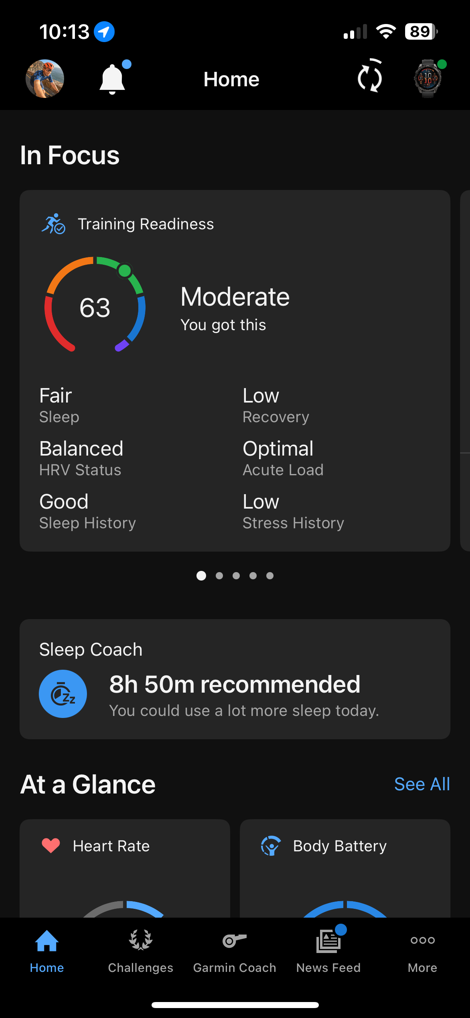
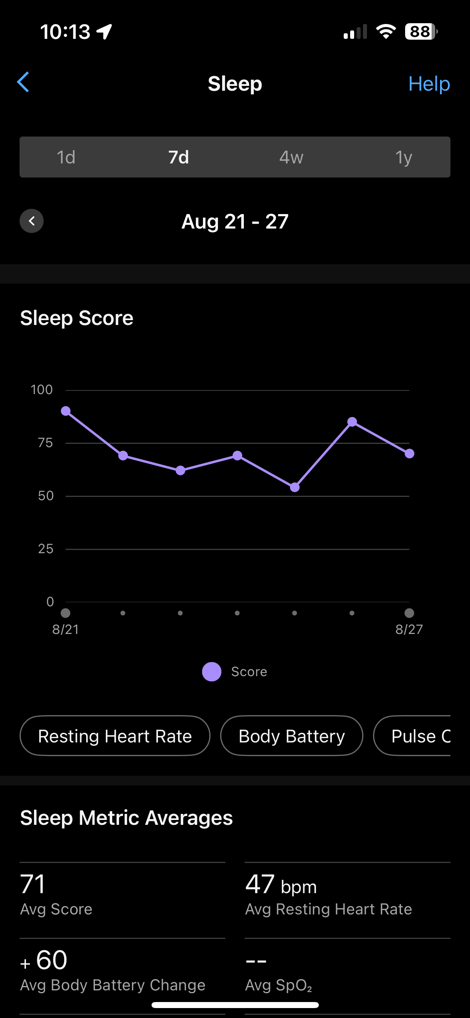
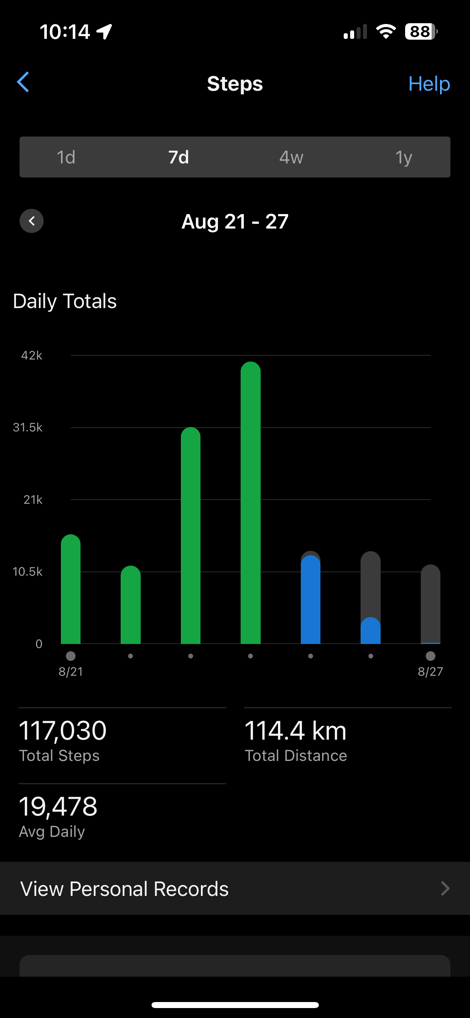
Now, heading back to the watch, one area that’s been significantly changed is the settings menu (as part of the overall redesign). Garmin has essentially re-ordered everything here to have the most frequently used features up top, and then re-grouped them into more logical groupings. This is really targeted at new Garmin users, but practically speaking, it works great for existing users. I’ve got no problems with the settings redesign.
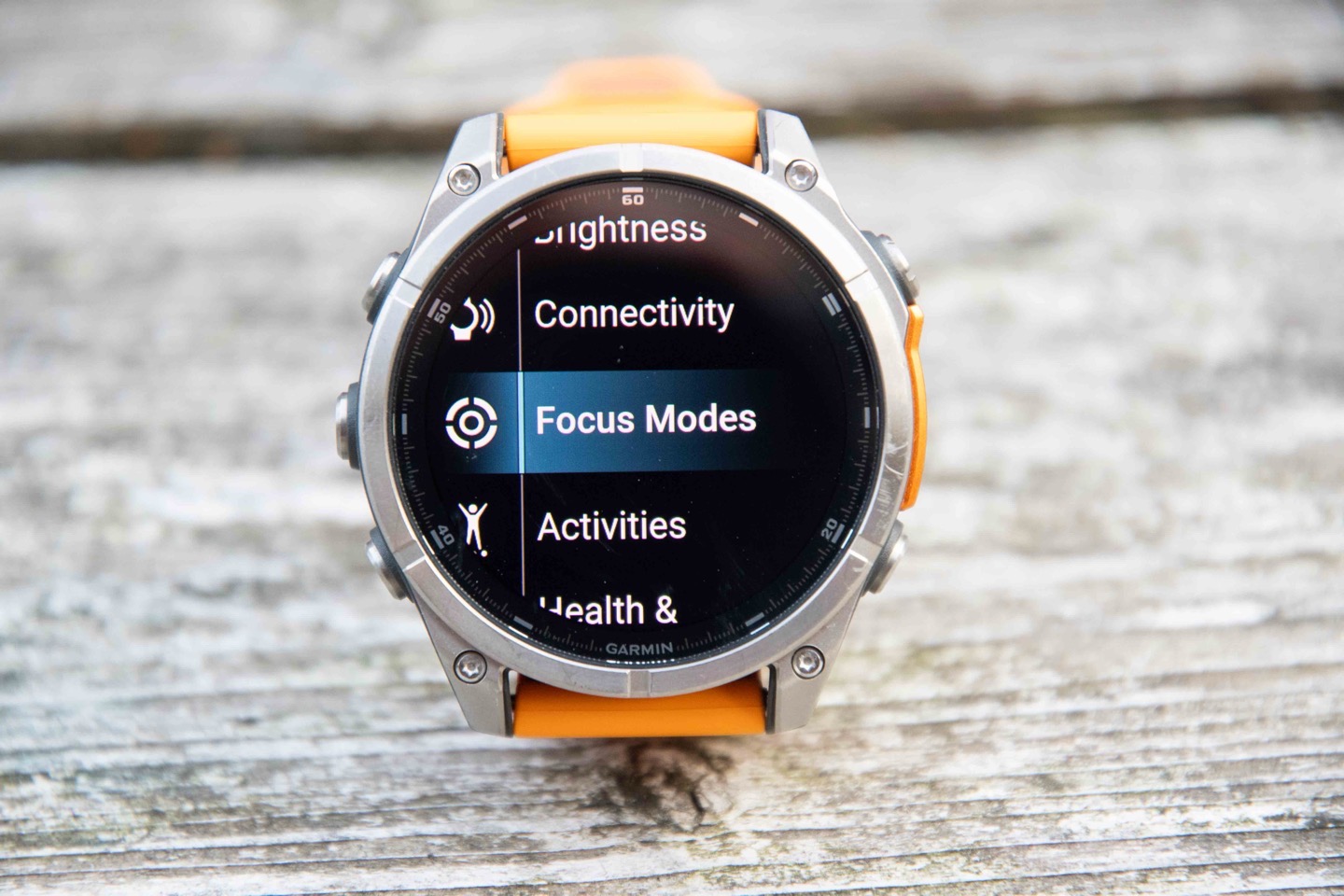
In fact, one of the things you’ll notice in that new settings area, is the new ‘Focus Modes’ feature. This takes loose inspiration from other companies’ ‘Focus Modes’ concept, in that it lets you customize a group of settings for different scenarios, such as Sleep and Activity. I say ‘such as’, but in reality, those are the only two at this point in time. However, Garmin says that they’ll soon expand that to creating your own custom focus modes, and tweaking more settings.
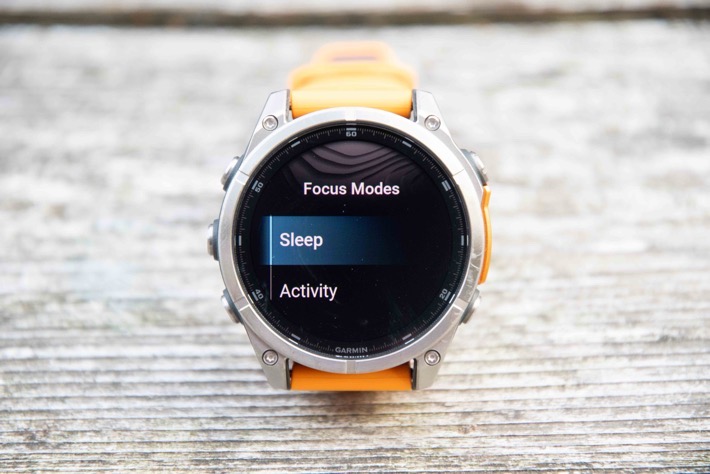
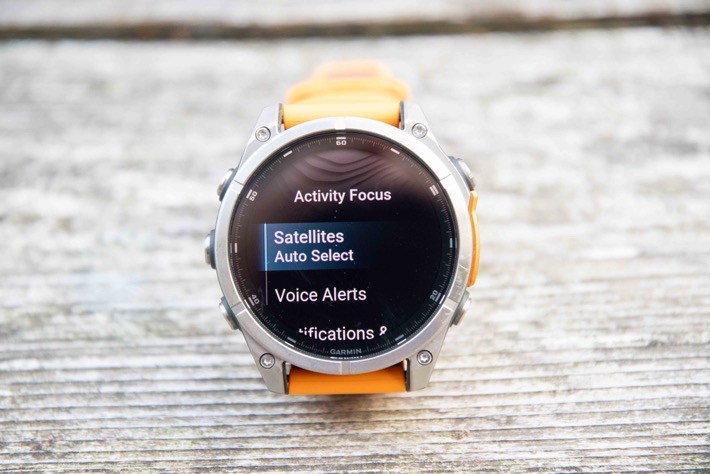
Until that happens, I honestly struggle with the value of this feature (said differently: It’s half-baked). But I can see how down the road you might create a ‘Race’ focus mode, or one for training, etc… But again, we’ll really have to see how things look once they get this all sorted.
Finally, two quick hit-list type items. First up, all the Fenix 8 editions have the flashlight, just like the Fenix 7 Pro and Epix Pro. The LED flashlight is on the front of the unit, and has three white brightness levels, and one red brightness level. I generally leave it on the red light, so at night it’s not blinding. Simply double-tap the upper left button, and the flashlight turns on, and you can then adjust the brightness by pressing up/down on the left side (you can see the red block on the controls in the middle photo below, on the left side of the watch face).
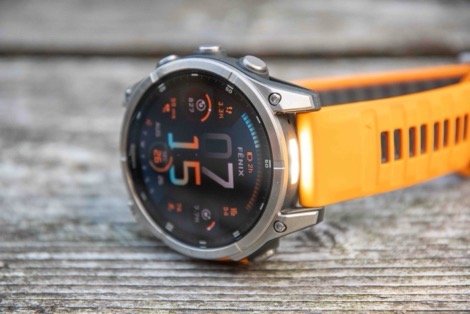
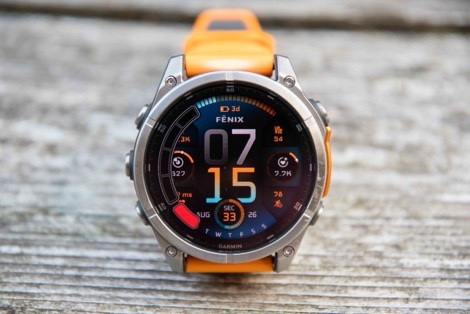

This continues to be one of my favorite features on the watch, as well as my wife’s favorite feature. She is very clear she won’t ever change to a watch that doesn’t have the flashlight (especially useful for checking on kids in the middle of the night).
And then lastly, the optical heart rate sensor in the Fenix 8 is the same as the Fenix 7 Pro and Epix Pro. This is an ECG-capable sensor, but at present ECG is only approved/authorized for people in the US (or those who travel at least once to the US).

With that, let’s get into the new features that depend on the microphone and speaker.
Voice & Speaker Features:
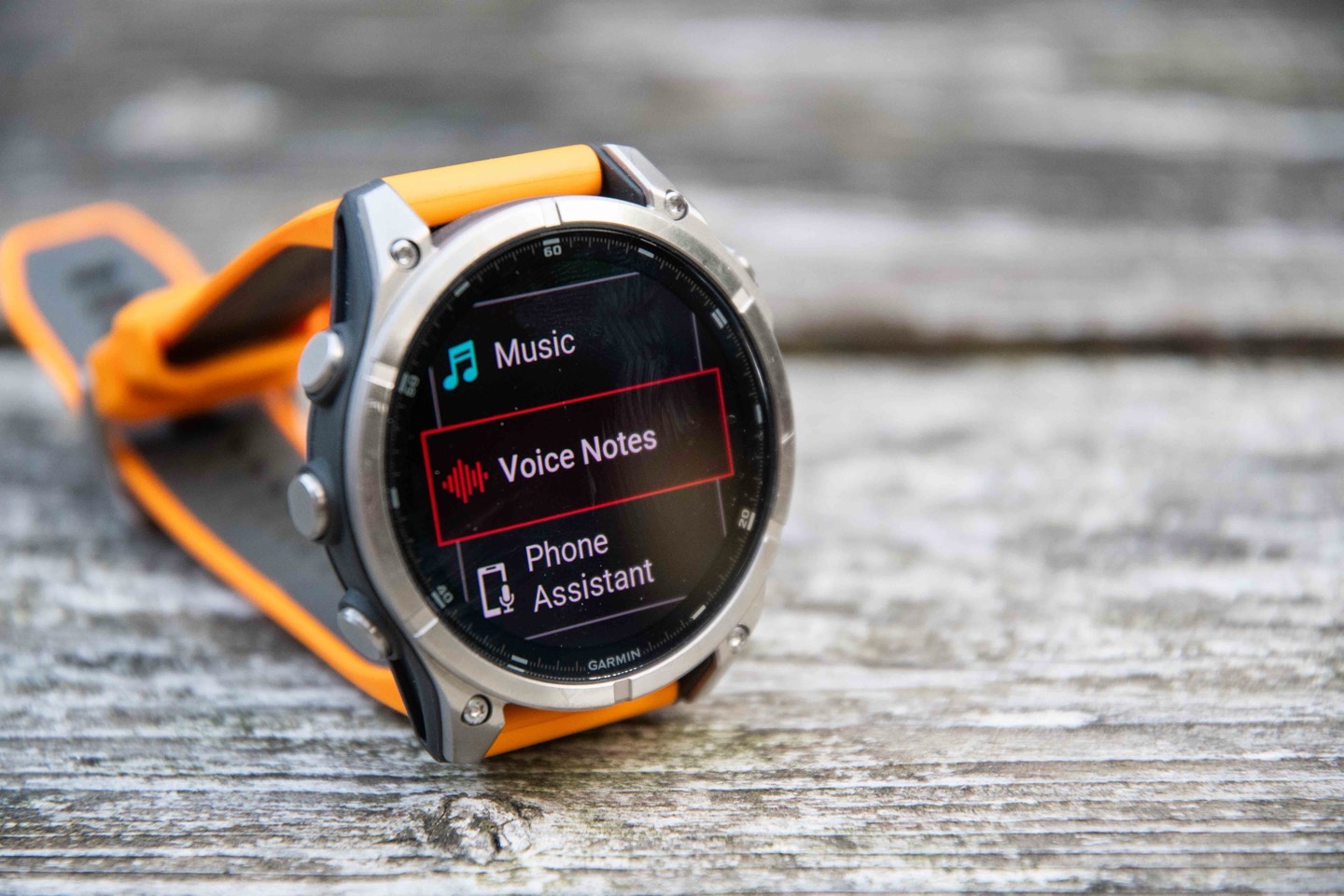
Depending on one’s perspective, this is either the biggest new feature, or second biggest (with ‘Dive’ being the other). Garmin has essentially taken all of the voice features found on their Venu series watches, and then added a few more. In short, these features are:
– Added hardware speaker/microphone (previously it just had a beeper)
– Added ability to take voice calls from your watch (requires your phone be nearby)
– Added ability to ask Siri/Google/Samsung voice assistants questions via watch microphone
– Added offline Garmin voice assistant (no cell phone required)
– Added ability to play music back via speaker on watch
– Added Voice Notes Recorder
So, let’s get right into it, starting with the new offline Garmin Voice assistant feature. This feature is *entirely* offline, and requires no connectivity to your phone or the internet. It’s designed to do basic tasks on the watch, via voice. To access it, you’ll simply long-hold down the upper right button, which then triggers the microphone listening:
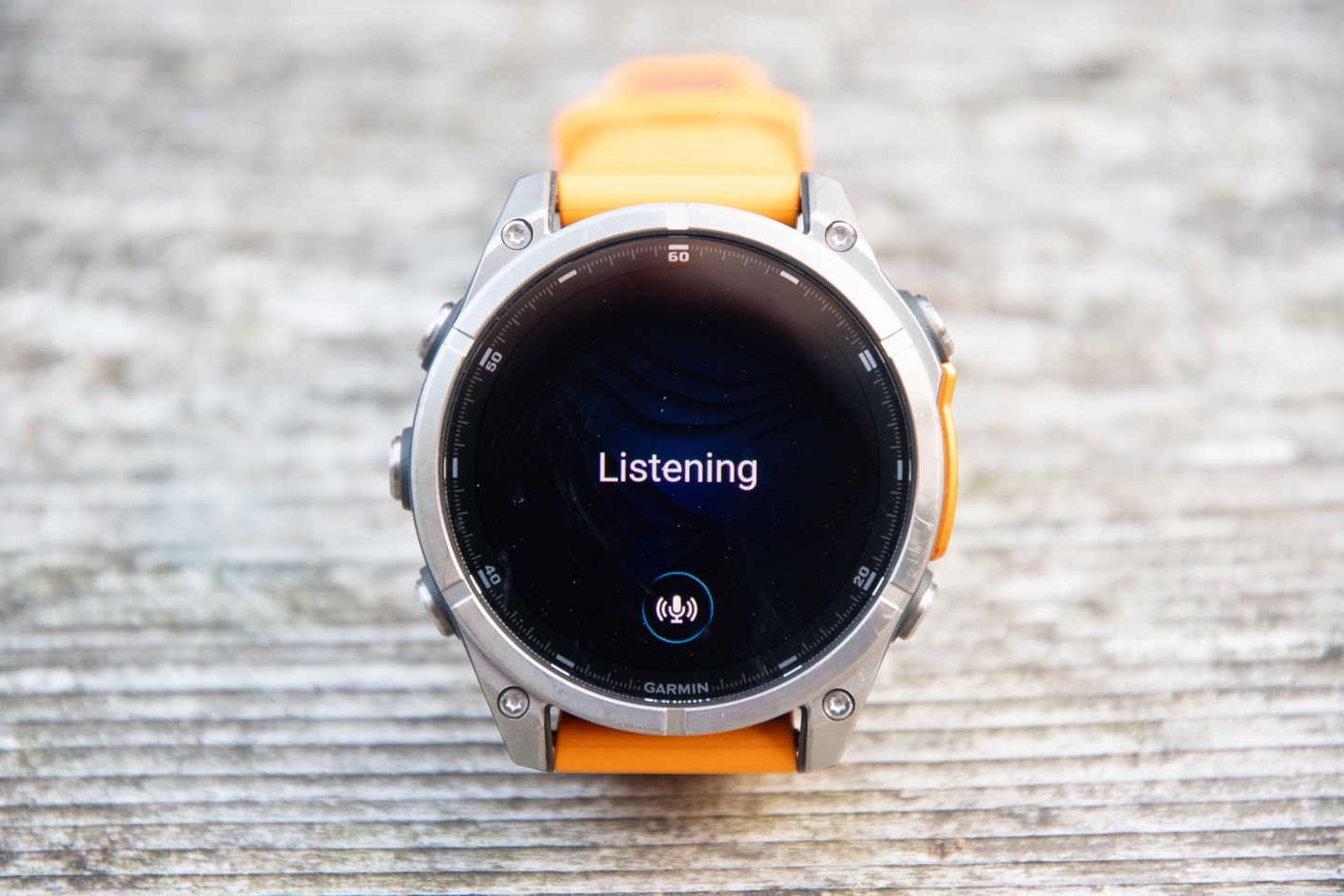
Examples of things you can ask are: “Start a run”, “Start a 10-minute timer”, “What’s my heart rate?”, “Save Location”, “Play Music”, “Show me the timer”, and so on. It’ll then listen to your voice, and a second or so later, show ‘Processing’:
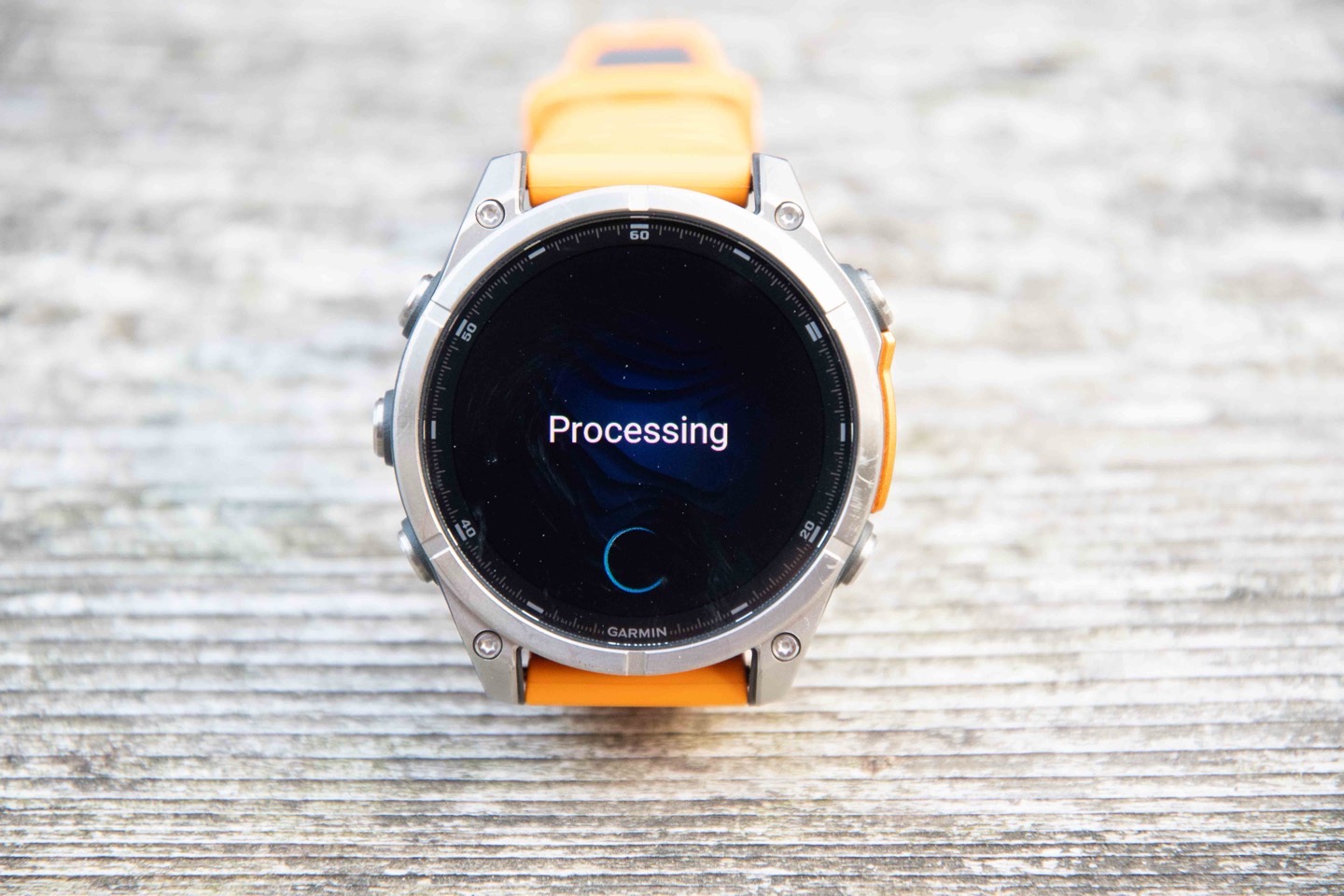
A moment after that, it’ll do whatever it is you used, such as setting this 10-minute timer:
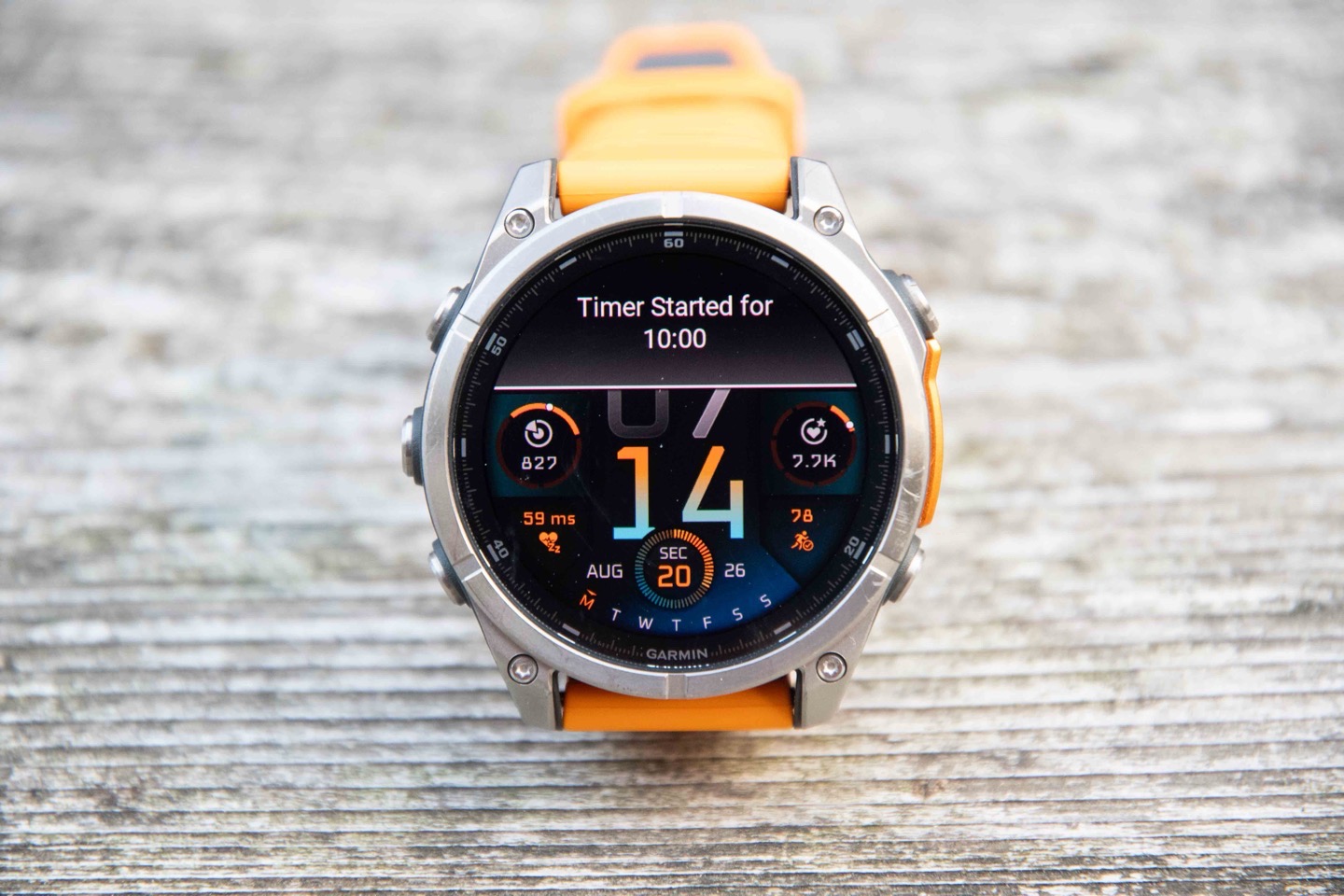
It actually works quite well most of the time, but whether or not it’s useful depends on which task you’re trying to do. That’s foiled further by the fact that you have to physically long-hold the button. Unlike Apple or Google’s voice assistants that are listening constantly, the act of holding the button takes longer than some tasks altogether. For example, in my video, I show ‘Start a run’, and side-by-side, I easily beat the Garmin assistant, in doing it manually.
Whereas for other tasks, like setting a 10-minute timer, the Garmin assistant will beat me, because that’s more cumbersome to do via buttons. However, when you ask to check the timer, you sometimes run into phrasing quirks. For example, I assumed I could say “How much time is left on the timer?” (and other variants). But nope. The correct phrasing is “Show me the timer”. However, these are things Garmin can easily expand over time.
The next assistants are those on your phone, driven by whatever phone voice assistant you have (Apple/Google/Samsung). These are obviously much smarter assistants, powered by the internet, but can’t control Garmin things, and of course, require your phone. To access these, you’ll go into the Apps menu, and then choose phone assistant, and simply speak your question:
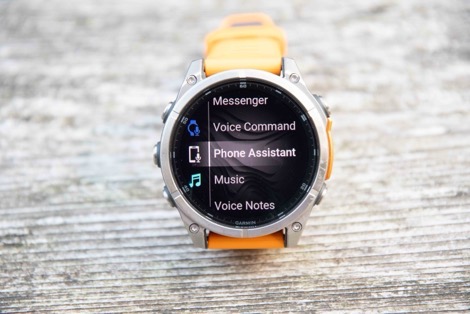
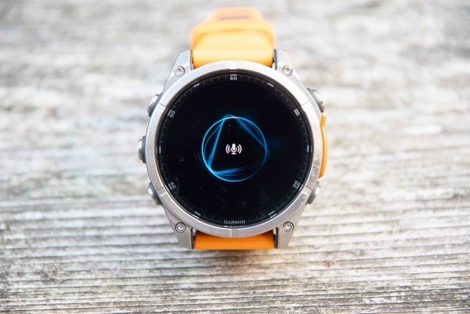
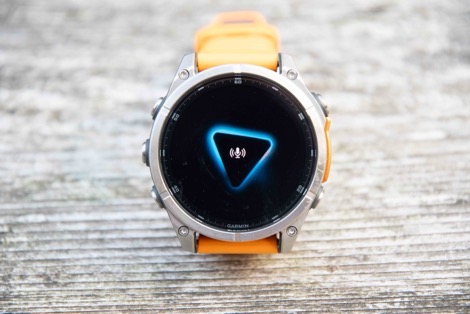
It’ll answer back on your phone, not on the watch. It’ll look identical to as if Siri/etc is answering a voice command on your phone, since it’s just leveraging the microphone on the watch, as if it were a headset or such.
Next, there’s voice calling. This will work almost identical to the above, in that it’s simply using your microphone/speaker as a Bluetooth audio device. Except that you can select contacts and dial phone numbers from the watch. You can also transfer the call back to your phone.
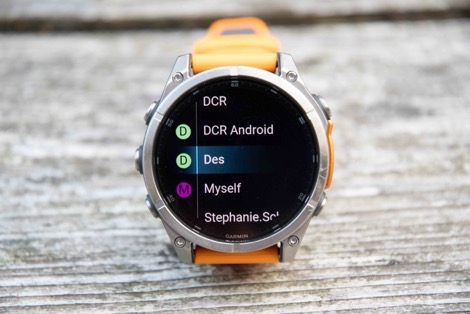
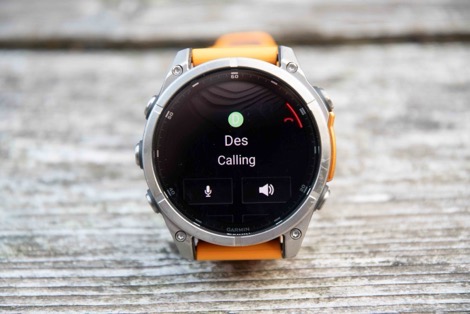
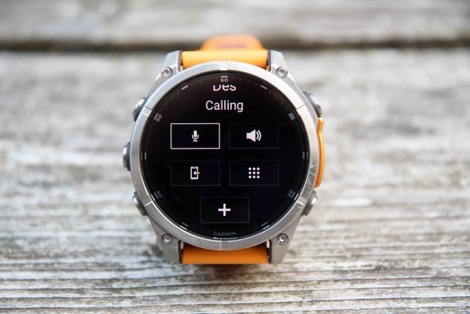
From a quality standpoint, this is basically the same as the Garmin Venu series, and is totally fine in a pinch. Just as with other watch-based microphones, it’s not ideal for a long call requiring very high quality, but if you need to make it work, you can. It’s not bad, but it’s not awesome as it’s just not all that loud, but sounds fairly quiet – especially in an outdoor environment.
Still, despite diving with the watch multiple times, the quality of the microphone/speaker is good (an obvious bar for success, but at least worth mentioning). Speaking of which, at the moment, Garmin’s doesn’t eject water from the speaker like Apple and others, but that too is on the way in an upcoming firmware update.
Next, there’s the Voice Notes/Recorder feature. This lets you take voice notes entirely offline. As with the Garmin assistant, this requires no connectivity to the internet. It’s fully internal. To access it, again, you’ll go into the apps menu and select the ‘Voice Notes’ feature, and then tap to record.
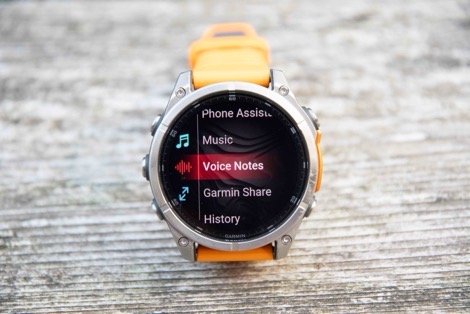
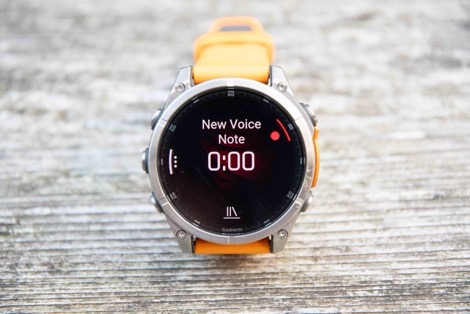
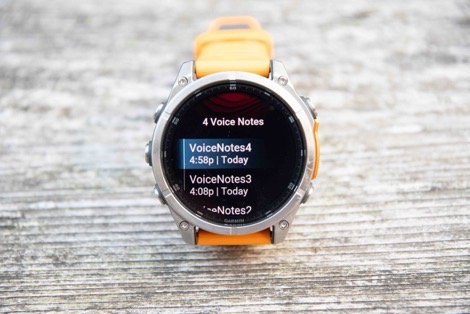
By default, it doesn’t geotag the voice notes, but you can toggle to enable that geotagging on a per-note basis. The notes are arranged in a library on the watch. Unfortunately, at the moment they don’t transfer to your phone, but Garmin says that’s coming. Once that happens, I can see this being much more useful. Still, if you’re out for a run and have a brilliant idea for a new thingy, this could be your quick and easy answer to recording said idea.
Lastly, the Fenix 8 supports offline music from Spotify, Amazon Music, and YouTube, as well as of course MP3 files. All of that works just as it has for the last few years, except now you can play that audio back on the speaker itself (rather than connected headphones). Again, I wouldn’t recommend this in a public gym setting, but if you’re in an area that doesn’t annoy others, then it works well in a pinch. It’ll simply ask you which audio device to use, and ‘Speaker’ is one of those.
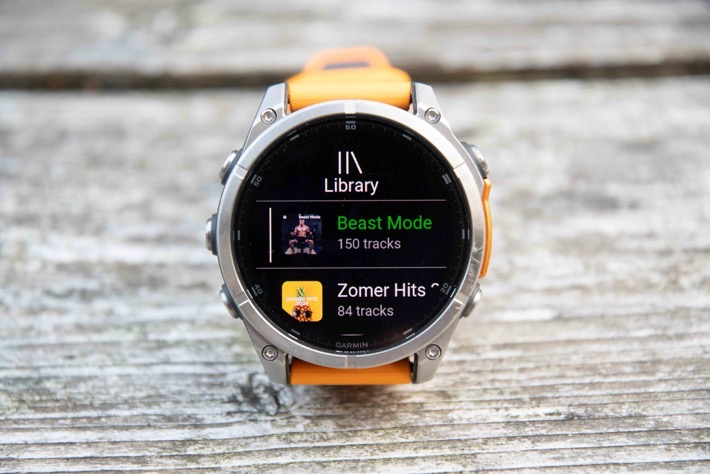
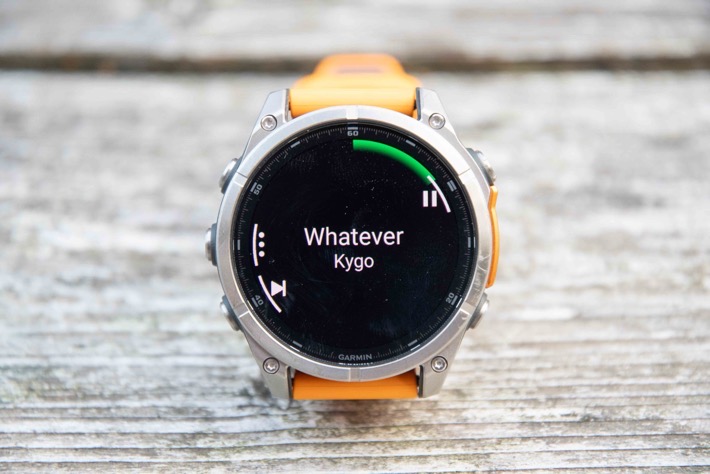
Ultimately, all of these features are aimed at increasing the ‘smarts’ on Garmin’s watch. Depending on one’s perspective on talking to your wrist, you’ll find these valuable or useless. I tend to fall more towards the useless camp, as I don’t tend to talk to my wrist. Instead, I was really hoping to see cellular connectivity, specifically aligned to how Garmin does it in the Forerunner 945 LTE and Garmin Bounce watches, where it’s primarily for tracking/safety features.
Getting full cellular connectivity for all integrated texting/calling/etc features under a single number is exceptionally challenging for Garmin, especially when looking at iPhone users, due to restrictions put in place by Apple that limit what Garmin can leverage when talking to an iPhone. For example, Garmin can’t reply back to text messages on an iPhone (from the watch), nor can they access photos in a text message on an iPhone. They can do this on Android, but I suspect there’s less desire to do so, given the majority of Garmin’s customers for this product category are on Apple phones.
Oh wait, one more thing I forgot! Ironically, the very first thing the watch will ask you when you set it up, is the font sizes. You can now adjust the font sizes across a wide range of different sizes, to meet your eyes’ needs:
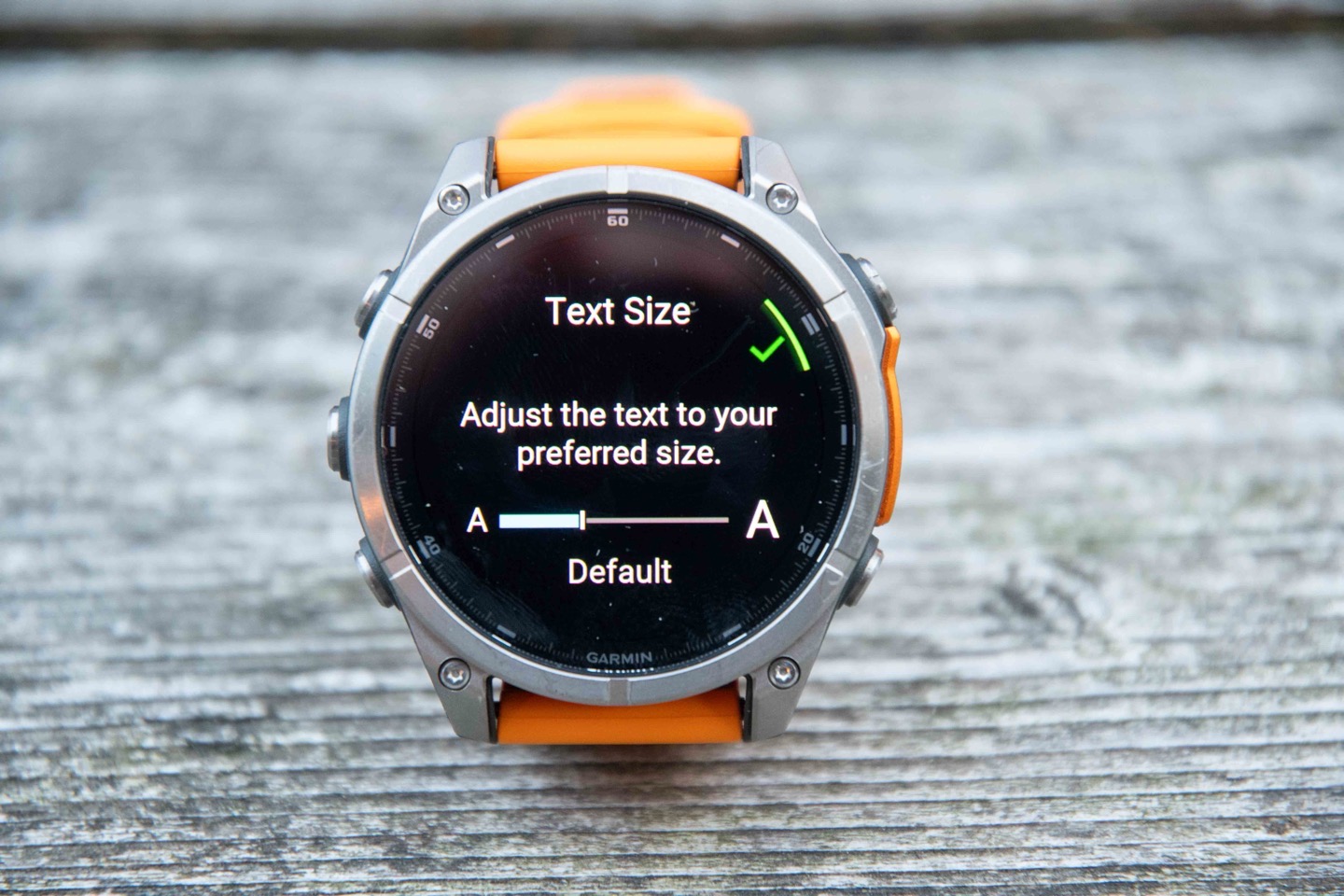
Everything in this review was just left at the default font sizes. With that, let’s get sweaty.
Sports & Navigation Changes:
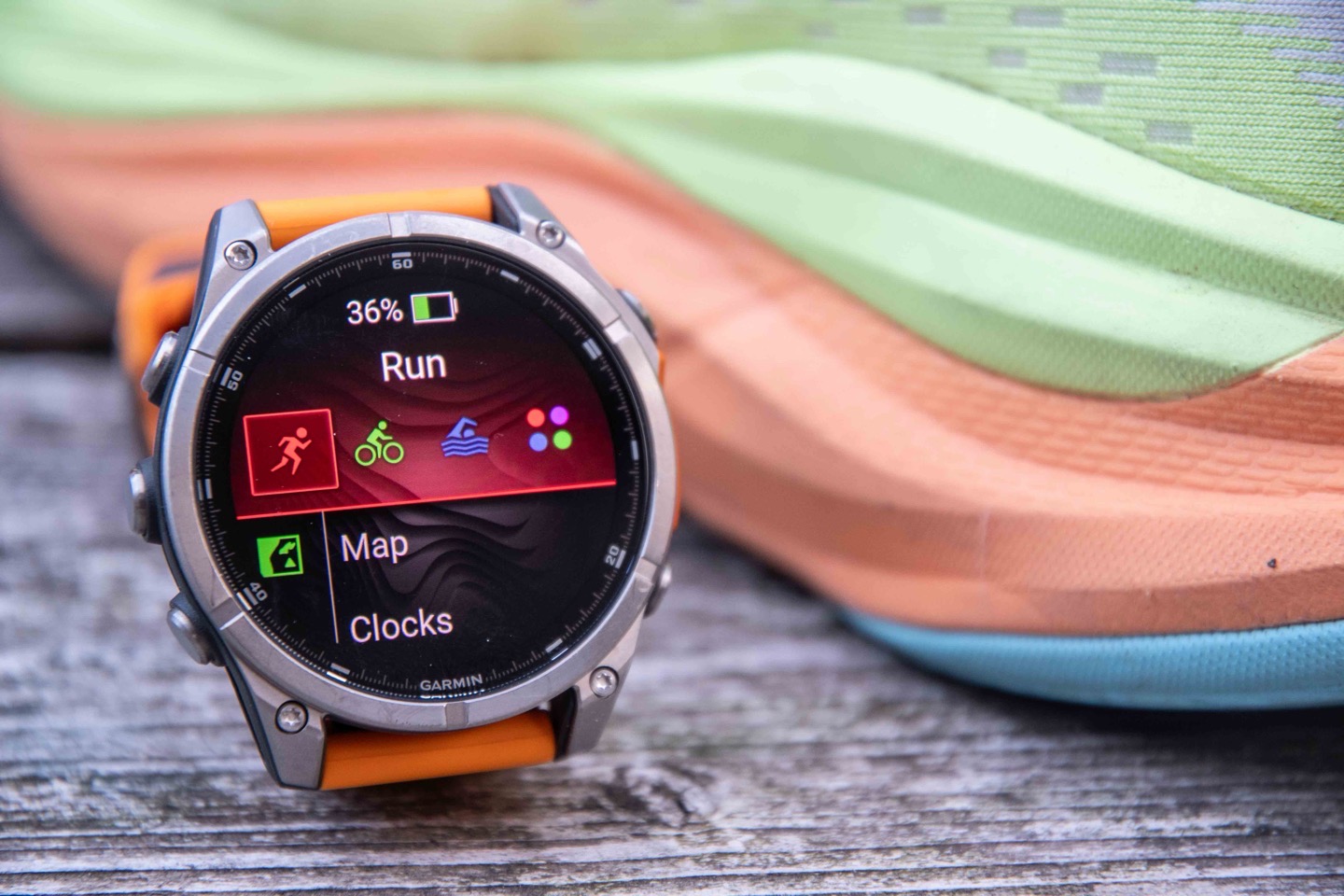
Next, let’s look at sports and activities. As there are some big changes here as well. At least in terms of looks and organization – the actual underlying features are almost all identical.
To access the sports modes, you’ll tap the upper right button, just as you always did. And at first glance, this will look similar, but in reality, it works quite differently (I show this in the video, walking through it all). The first thing you’ll see along the top is your top three pinned sports, and then down below are non-sport apps. So in this case, my top-three pinned sports are Running, Cycling, and Openwater Swimming.
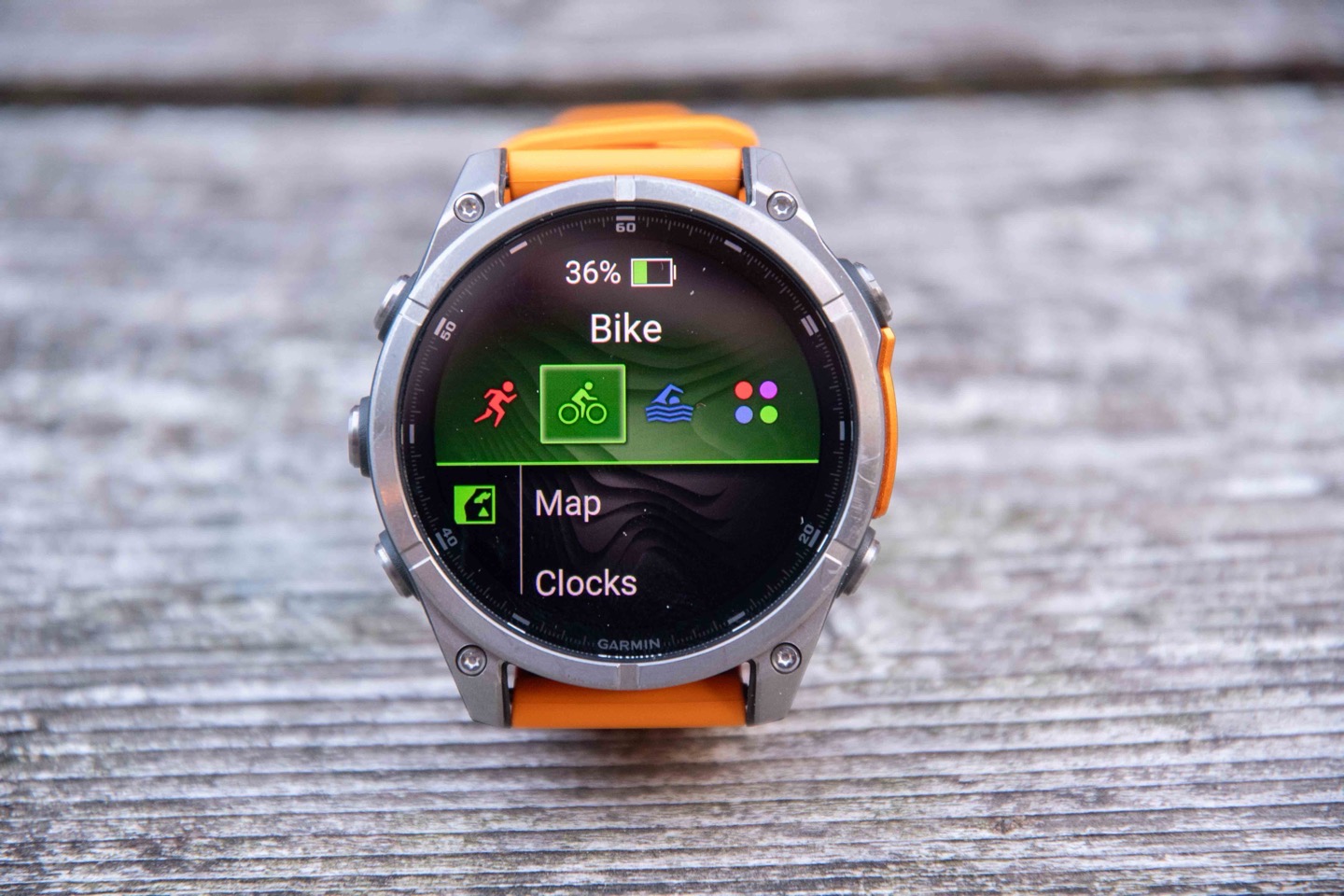
To access the rest of the sports, I move sideways to those four dots, which opens up the bigger list. Here’s where I can see all the other favorited sports that aren’t in the top three, as well as other ones I haven’t even used. This sounds like a minor gripe, but I don’t like having to go sideways, then confirm, then down, through the list. It just ends up being unnecessary.
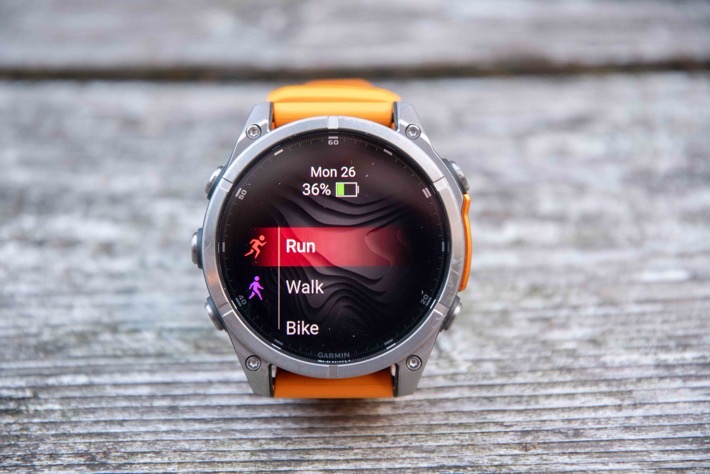
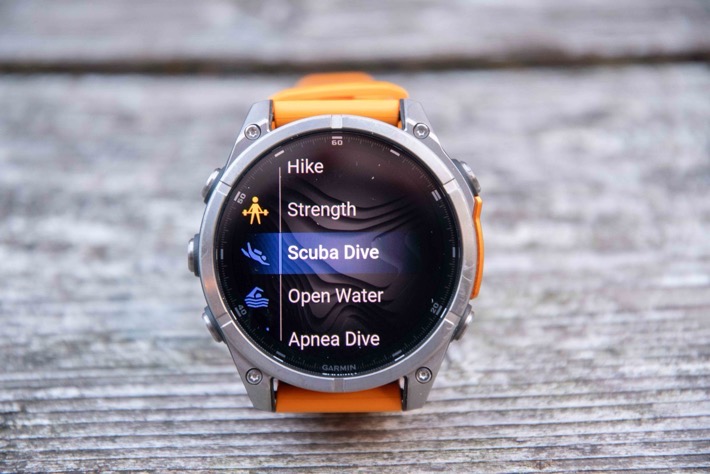
Meanwhile, if you didn’t go sideways, you’d get to the non-sports App list, which is where things like Voice Calling is, and other non-sporty features:
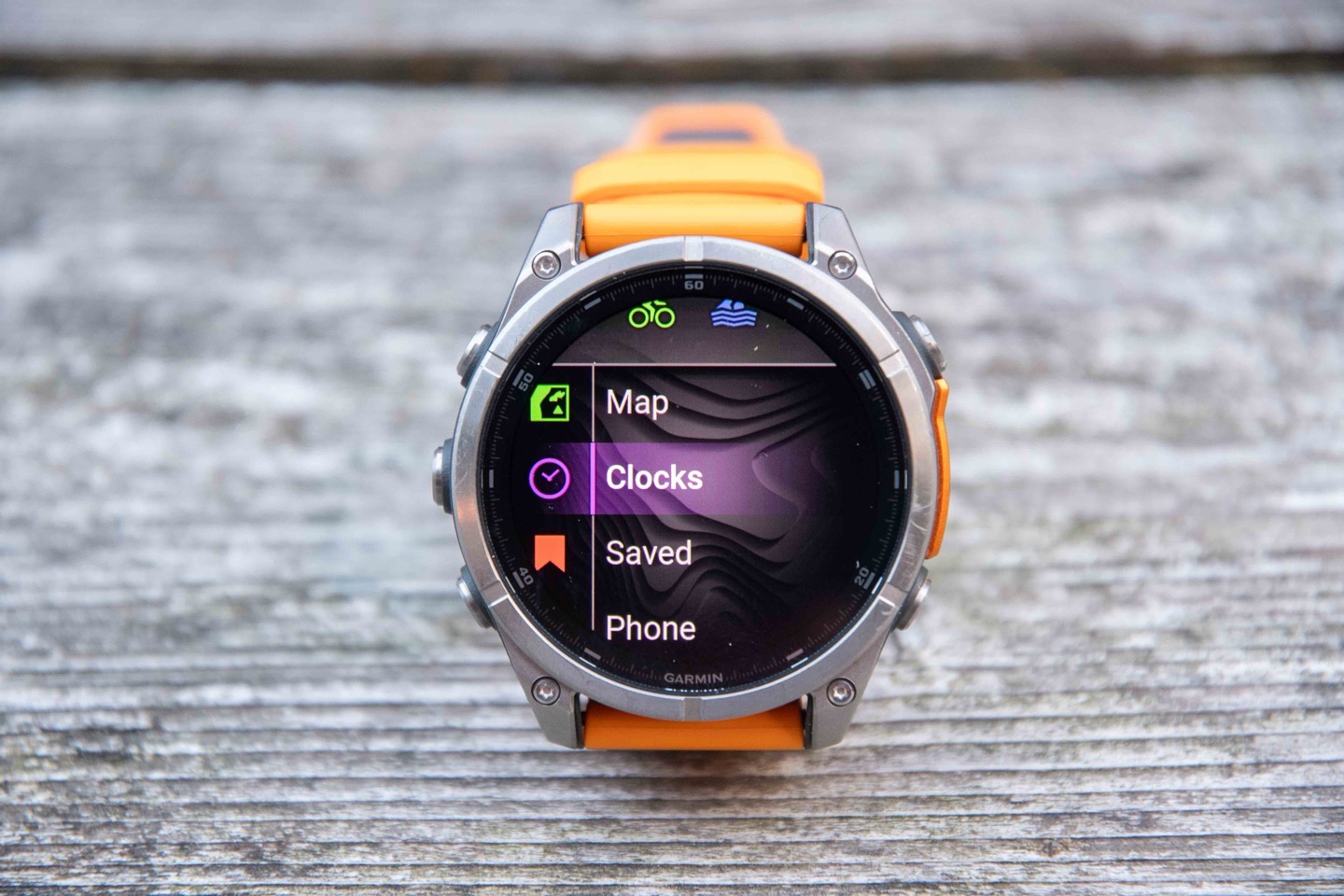
However, let’s assume you’ve selected a sport, running in my case. In this scenario, again, it’ll look similar at first glance. You’ve got your GPS status and HR status up top, and then the start button. However, the big change is that down below are all your settings. It’s one continuous settings arena now – virtually identical to what Suunto has had for a number of years. The idea here being it makes it obvious that Garmin has all these extra features (such as the Daily Suggested Workout listed):
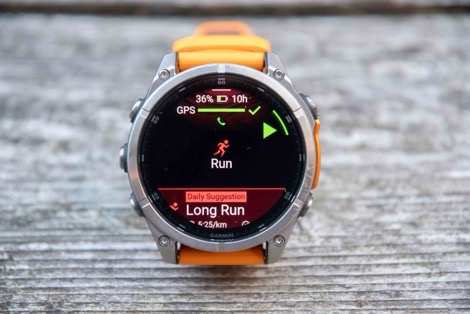
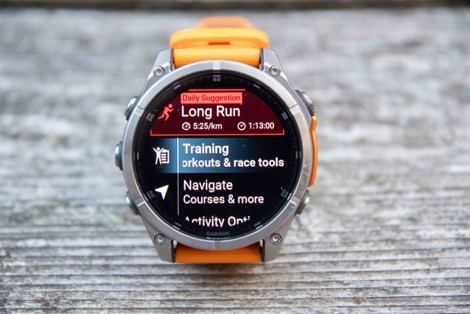
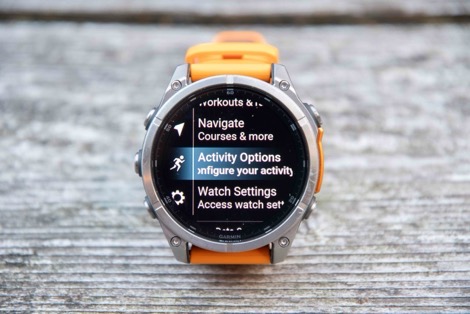
Garmin’s goal here is again, making it easier for new-to-Garmin users to see all these features, which were previously hidden deep in the menus. And I actually like this part of the UI redesign. It doesn’t really save you button presses, it just makes it more obvious these things exist. And it, of course, groups them together.
For example, let’s say we add a course to this. We now have a new ‘Saved’ section, which puts all the saved navigational bits into one bucket (courses, saved location, etc…).
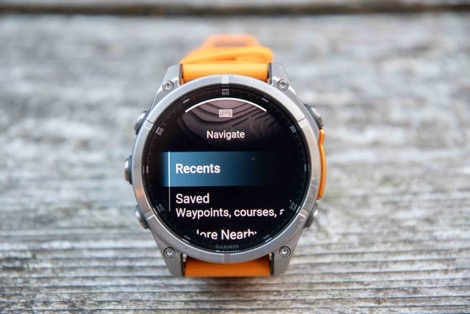
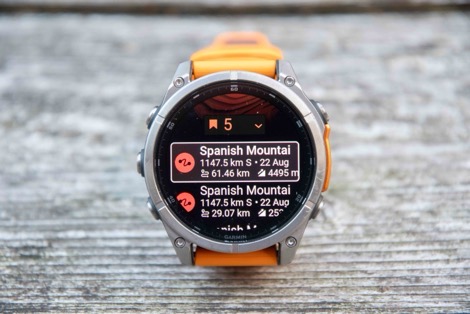
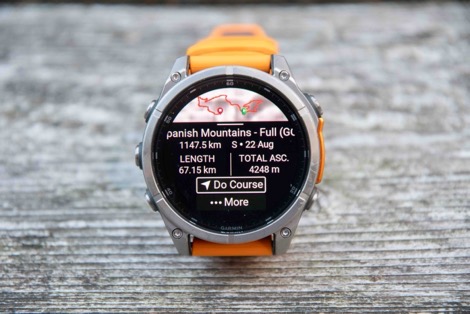
So loading up that course, you’ll see it added to the start screen before I press the start button. Think of this as ‘Lane 1’ (including the settings bits down below), and now you can swipe sideways through three distinct lanes: Navigation/Settings, Your Normal Data Fields, Music Controls. You can see the three icons for this at the very bottom.

Ok, so now we press the start button, and we get into our normal data pages. These are what we’ve always had since the beginning of time with Garmin watches, and you still have them too. Anything you’ve configured the way you want it, is here, in the middle lane (shown by the little hiker icon, since I’m in hiking). It just happened this was a bad still photo of the map loading mid-way, but, you get the point. The map was one of my data pages I had set up. I go up/down through the data pages like previously.
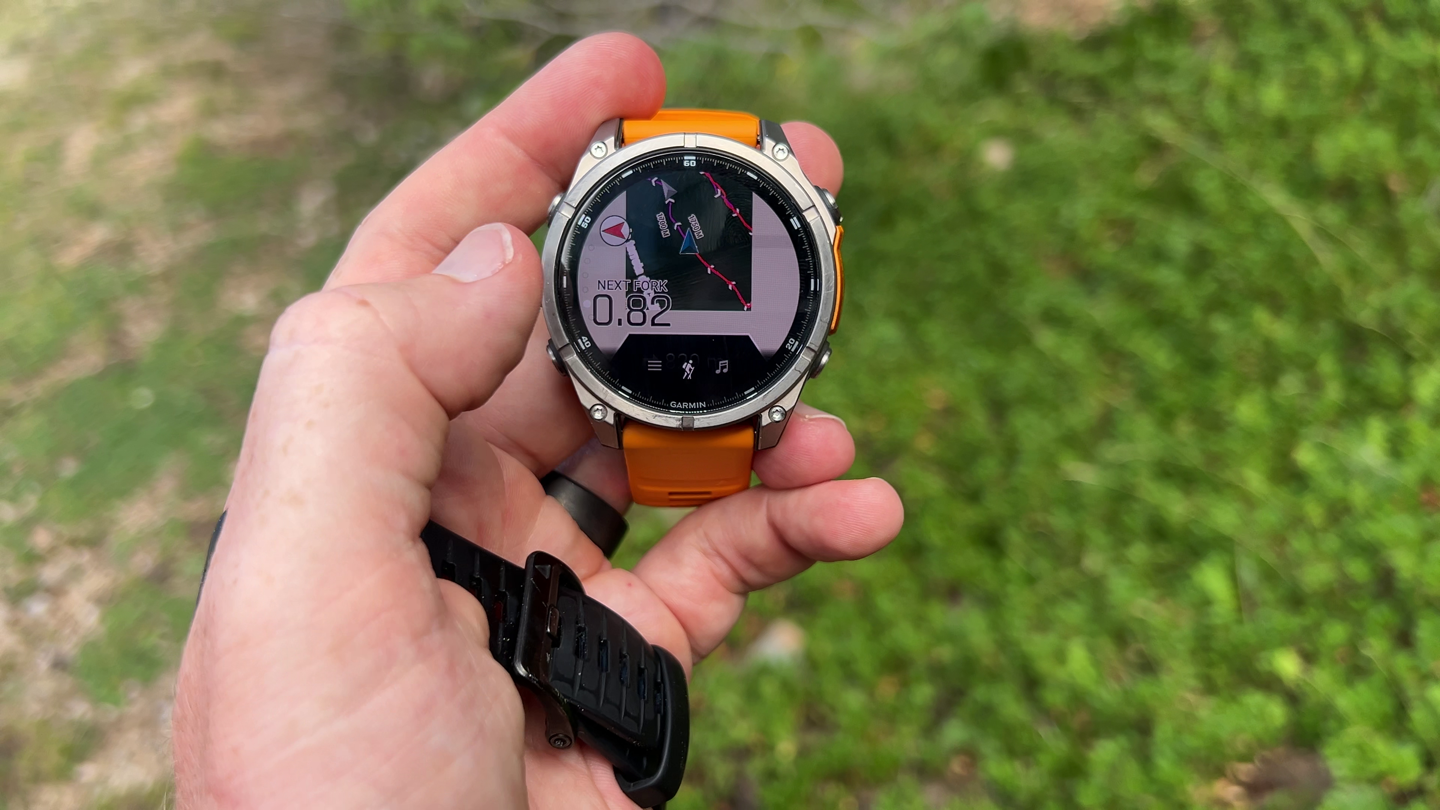
However, now there’s an additional page to the right, for music controls. Spotify, Amazon, etc…are all here. Unfortunately, you can’t get rid of this page at this time, though Garmin seems to indicate that’s coming.
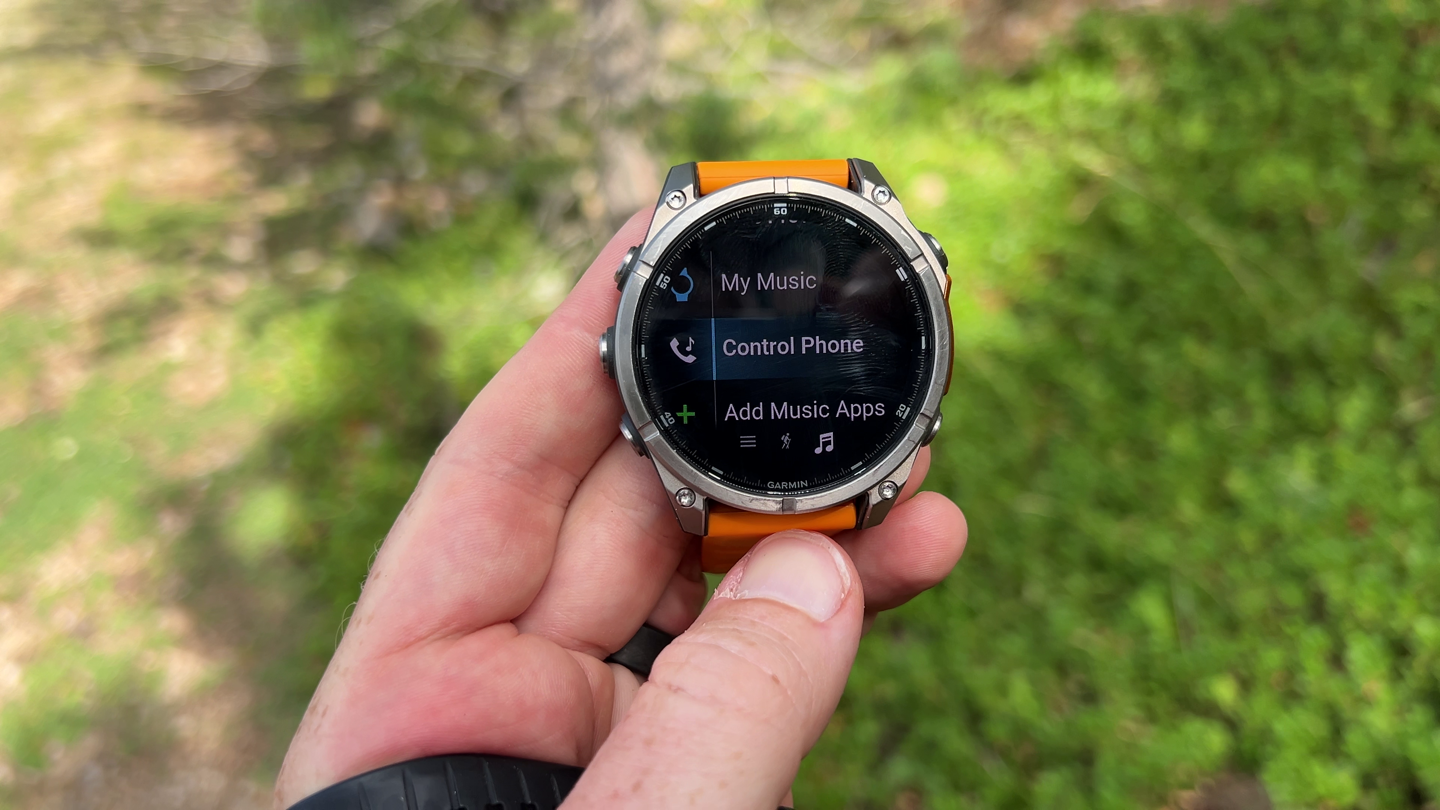
But the biggest change comes if you go to swipe back to the controls page (going left). Here, you’ve got controls, but you’ve also got a new dedicated navigation lane. It’s indicated by the blue rectangle around ‘Spanish Mountains’, the name of my course. In this case, it’s showing 5 hours till completion of the route, though oddly 828m till the next nearby waypoint. Why it splits the difference, I don’t know (nor do I like it).
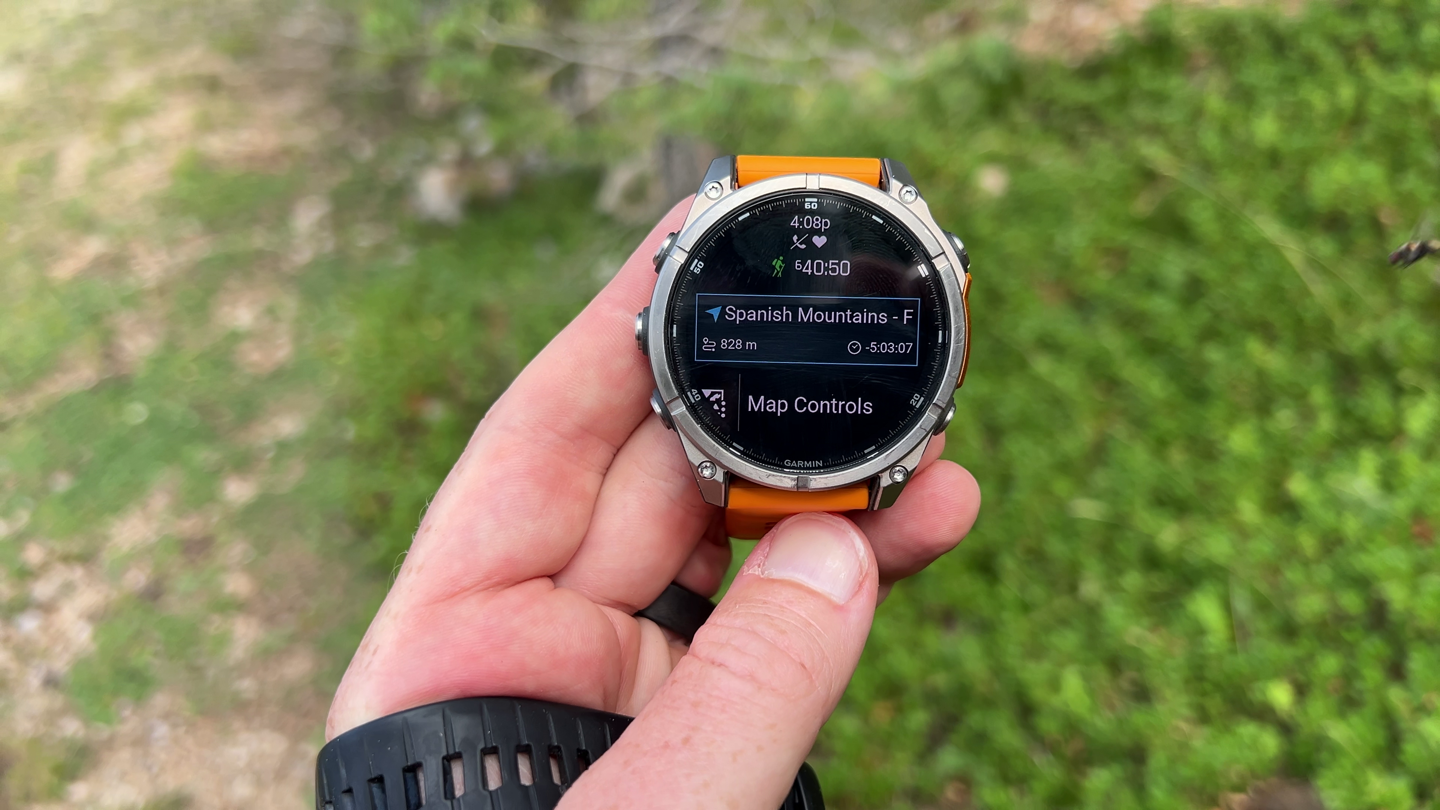
Where it gets kinda wonky though, is that you can then tap/select that to open up the full navigation set, which is another bundle of navigation-specific data pages. If you’ve been around the Garmin block though, these will likely be duplicates of your normal data pages. For example, this is in the navigation lane (Map page, ETA page, waypoints page):
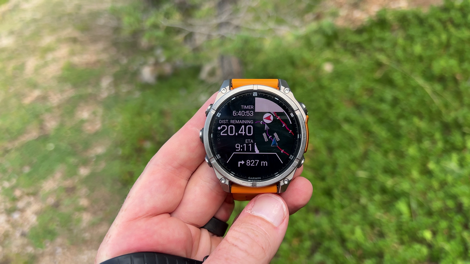
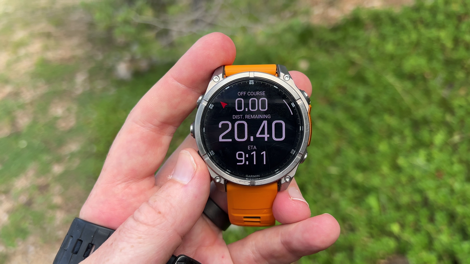
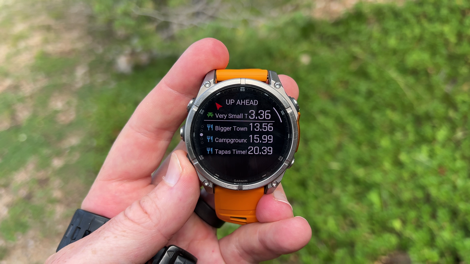
I like the concept as a concept, but not in execution. First off, I should be able to swipe left, straight into the navigation lane. I shouldn’t have to open it up again from that controls lane. And second, it just all ends up being duplicates of what I already have. And then that doesn’t cover the fact that on the navigation page, ClimbPro just defaults to showing the first climb on my route, rather than my current climb that it shows elsewhere (given I’m 7 hours into this day, I don’t much care about that climb 7 hours ago).
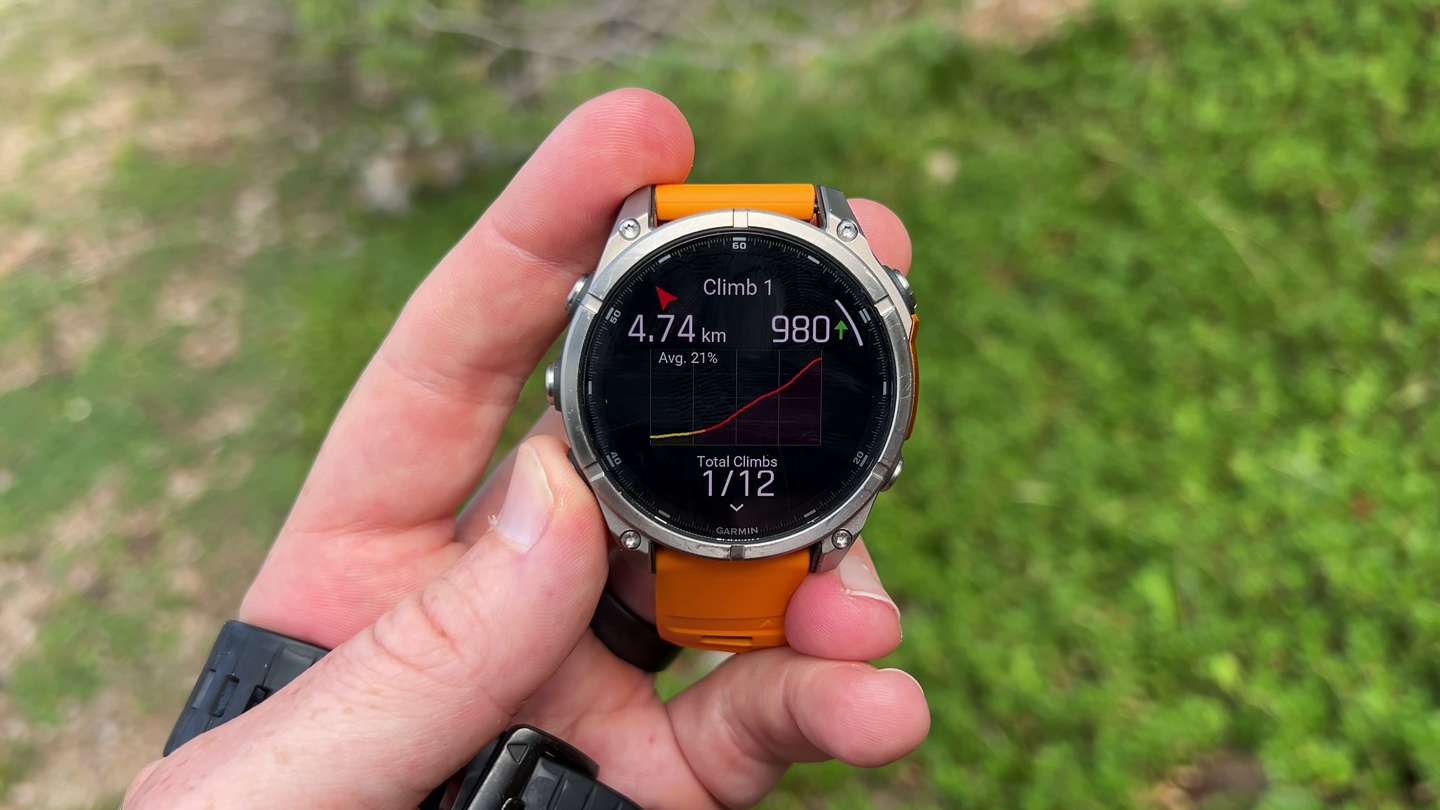
There are some other nice tweaks though; for example, you can tap and swipe a little icon to then unlock touch, otherwise, it remains locked. This makes it much easier to use the touch on a map page but otherwise have it disabled.
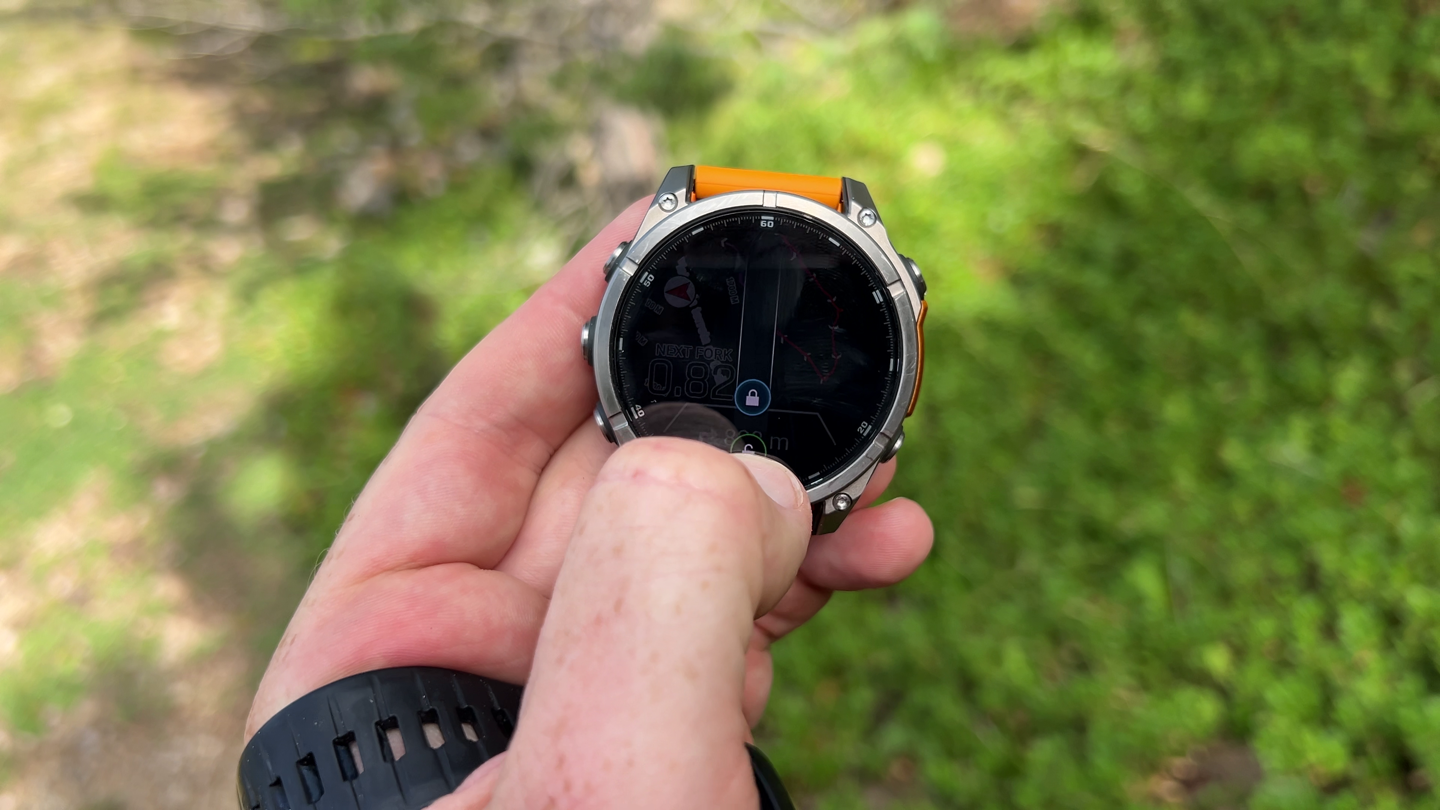
Further, on a map page, you can select the compass icon to change the orientation to North Up, or direction of travel. Again, tiny little things.
Likewise, there’s a new option to quickly select various map layers, and toggle them on and off, directly from the map page:
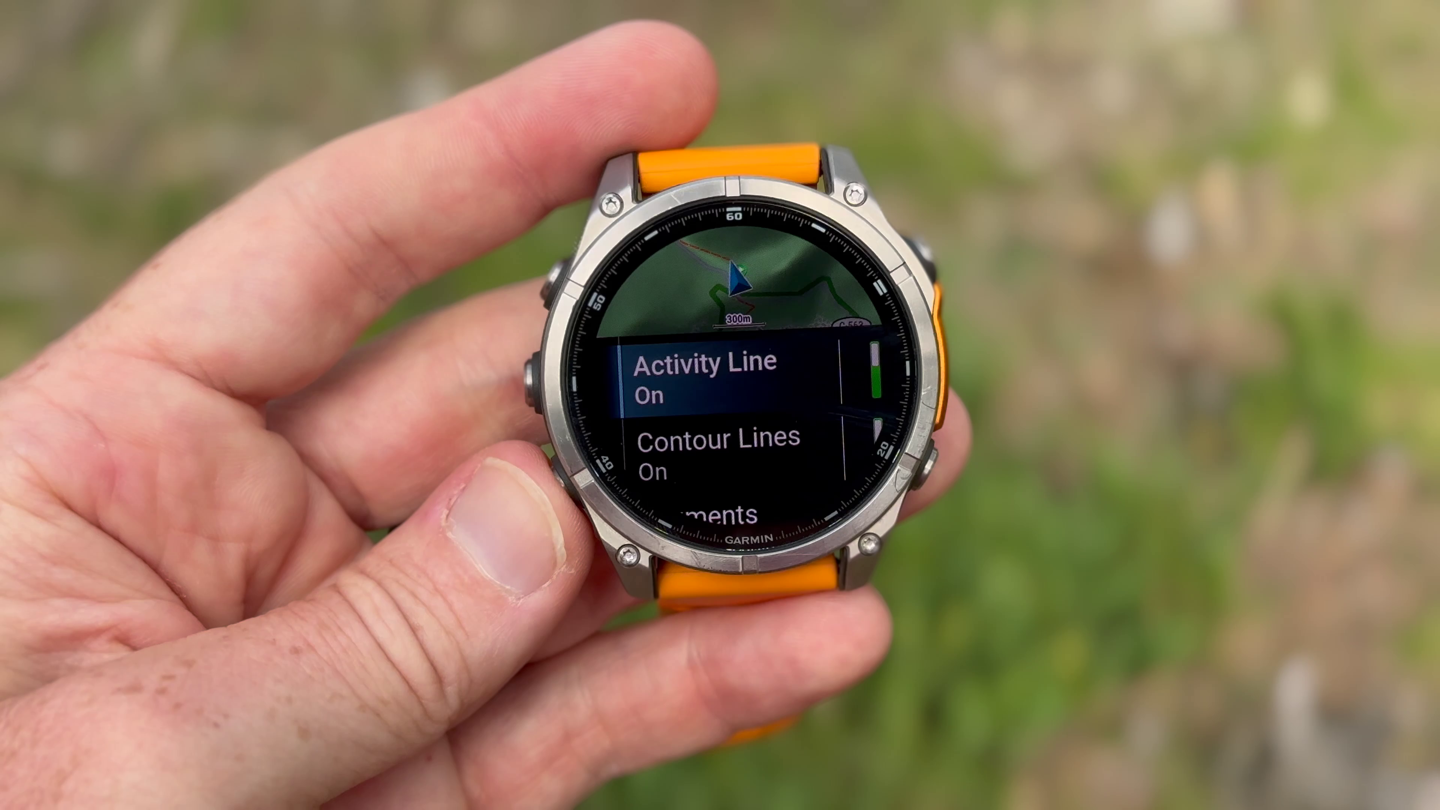
This is handy with the Outdoor+ maps (satellite imagery), where you want to quickly shift back and forth between the different map types, or even other map types as well.
And ultimately, setting aside my quibbles with how the navigation lane works, the underlying watch foundations worked well, as expected. There’s a bit more lag than I’d like in some cases for map tile enumeration, which didn’t seem to happen on the Epix Pro. But it seemed varied as to when it was slightly laggy, and when it was instant.
Further, the second day hike (this 38KM hike) was a great example of when a GPS device, with mapping (specifically topo maps) was absolutely crucial. There were key sections of the route that clearly hadn’t been used in a long long time, and required some moderate bushwhacking. Having the topography side of the maps made it easier to figure out where I could cut through, and where I couldn’t (due to cliffs).
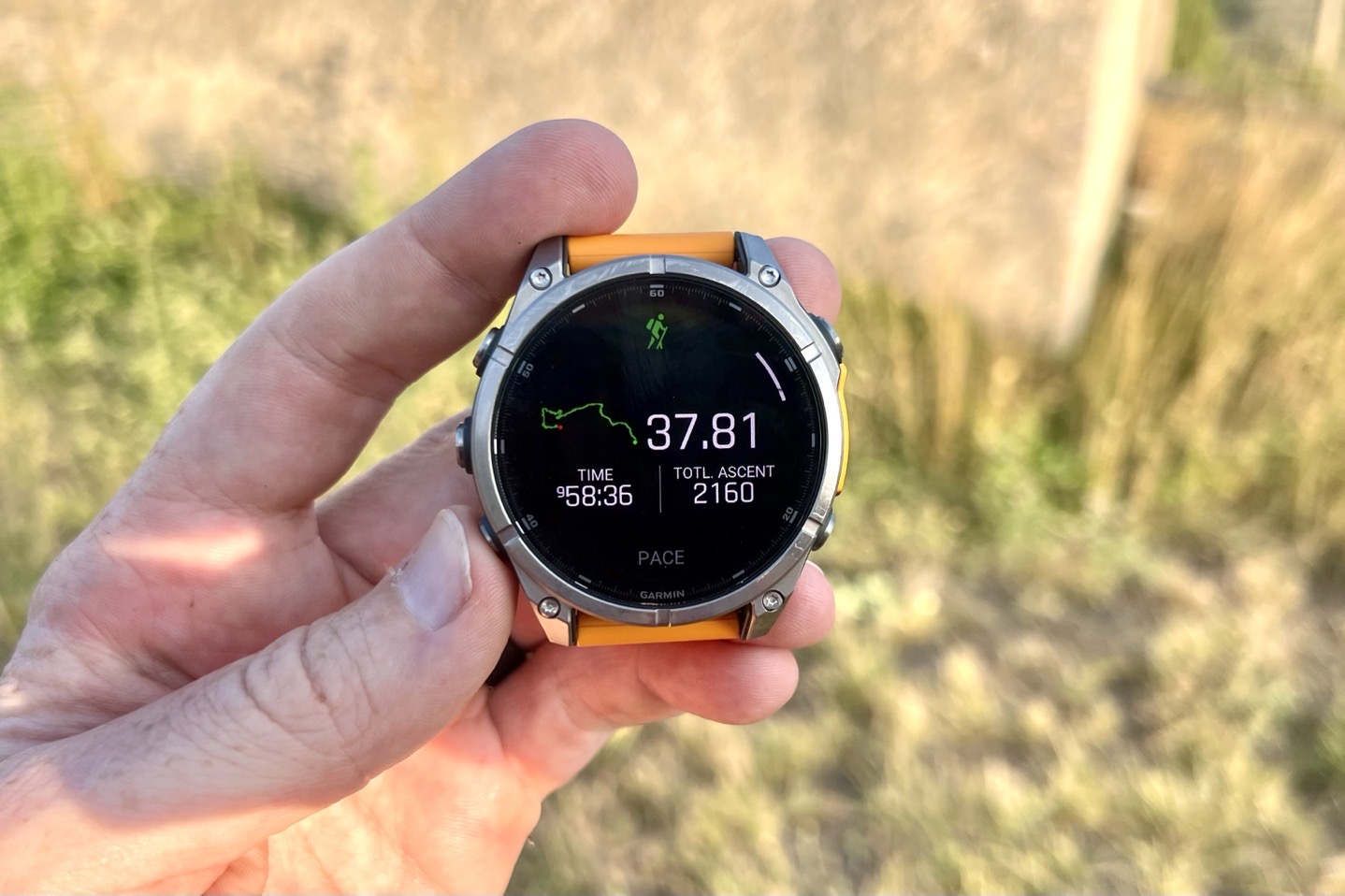
Beyond that though, there’s no changes to things like sensor pairings, data fields per page, training features, etc… All of that is identical. Thus, you can refer to my Fenix 7 Pro or Epix Pro reviews to see all those details, as they are exactly the same here.
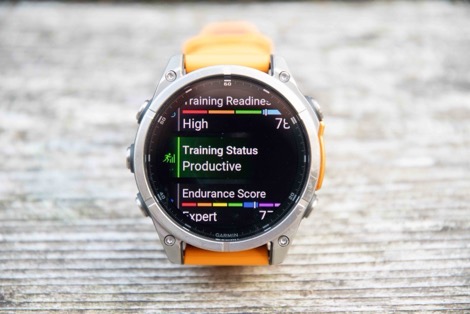
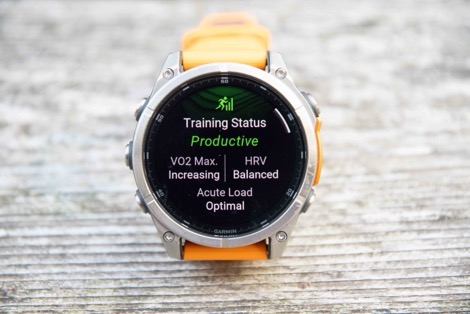
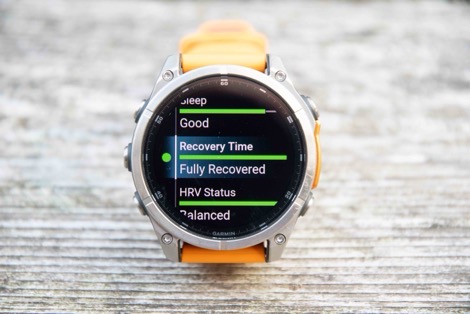
I’ll likely expand out this section with all the usual explainers of how to start/stop workouts and such, but everything there remains identical to the past. Thus, let’s focus on some of the other new areas instead.
Dive Functionality:
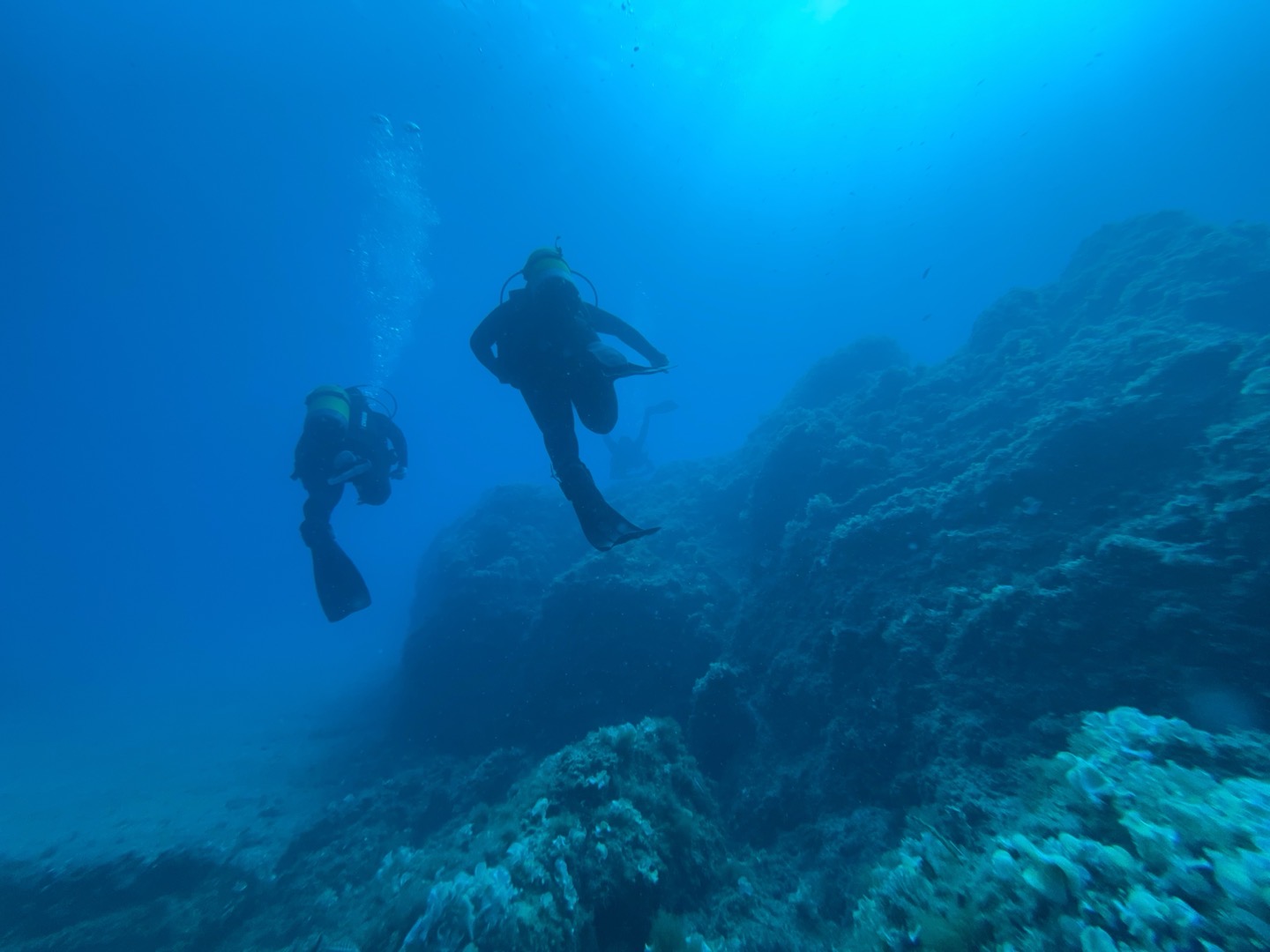
Of course, one of the two big-ticket features is the addition of dive functionality. That includes both a hardware element (depth gauge, and better sealed buttons), as well as a software element (all the dive computer pieces). Garmin has made dive computers for a number of years now (7 years, to be precise). And in that time, they’ve unquestionably changed the premium dive computer industry. They essentially took a Fenix unit, and made it a dive computer, under the Descent branding. Now, they’re pulling those features back into the Fenix lineup.
And to Garmin’s credit here, they seem to have struck a very strong balance in terms of which features to add from the much more expensive Garmin Descent MK3 lineup (the MK3 is $1,199 for the 43mm, but jumps to $1,599 for the 51mm with air integration).
This means, at a high level, you’ve got the following features:
– Supports scuba dive, apnea (free diving), and snorkel
– Supports both air and nitrox
– Supports basic dive planning
– Has all normal dive computer fields (depth/time/compass/water temp/max depth/etc)
– Supports compass lock heading option
– Records GPS entry/exit points
– Has all the normal ascent/NDL/etc alerts you’d expect.
– Has no-fly time, surface interval time
– Has full Garmin Dive app log integration
However, the handful of features not available on the Fenix 8 that are available on the MK3i are:
– No Wireless Air Integration (tank module support)
– No wireless dive network integration (called ’Sonar’, to communicate between divers)
– No Garmin Diver Readiness Score
– No Trimix support
– No Advanced Technical Diving Modes
There’s also some other minor user interface bits you’ll see different, though most of them are pretty minor and owed more to the Fenix 8’s updated UI than anything (for example, on the Fenix 8 they combine the tissue loading data pages together, whereas the Descent MK3i splits it into two data pages, yet the total content is identical).
Here’s the full chart, from Garmin, on the differences (having used the Apple Watch Ultra with Oceanic’s app, I don’t see any obvious errors in Garmin’s chart):
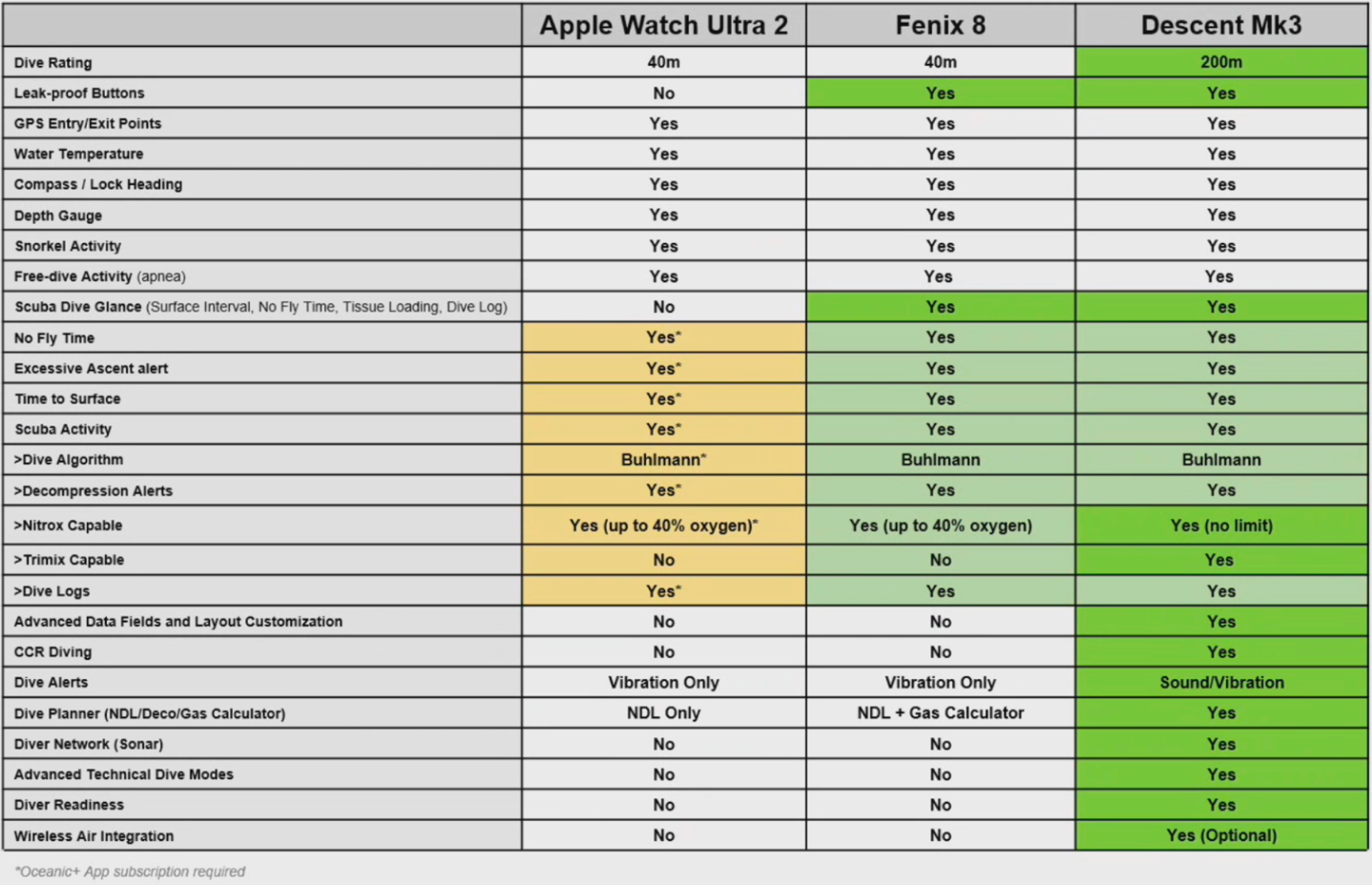
(I’ll aim to re-create this table in the coming day or so, and add in the Suunto Ocean)
Note that I’ll be spending a lot of time in a warmer water locale come September, thus, expect to see more diving-focused bouts, including directly comparing the Fenix 8, Descent MK3i (with tank module), Suunto Ocean (also with tank module/pod), and Apple Watch Ultra 2 (with Oceanic app):
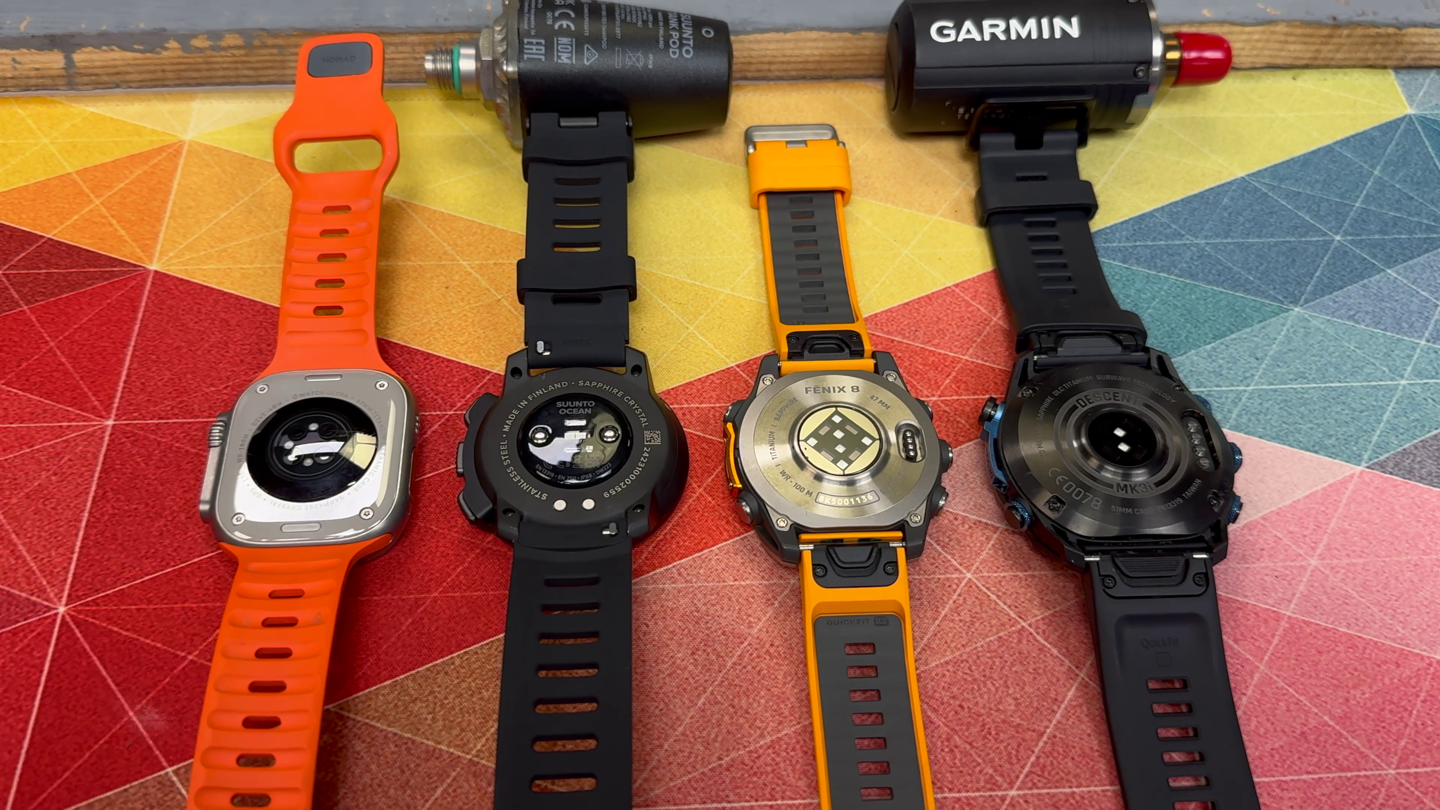
Ok, with that said, let’s talk about how the diving works. First up, you’ll want to add the Dive option to your sports favorite list. The reason is that by doing so, it’ll automatically trigger a dive when you descend below 4ft/1.6m (just like other companies do, per EN13319 regulations section 4.2.1). You can turn this off though, such as if you swim (e.g. training) regularly, so it doesn’t constantly turn on when you jump in the pool/water. Else, you can just manually open up the Scuba Dive sport profile:
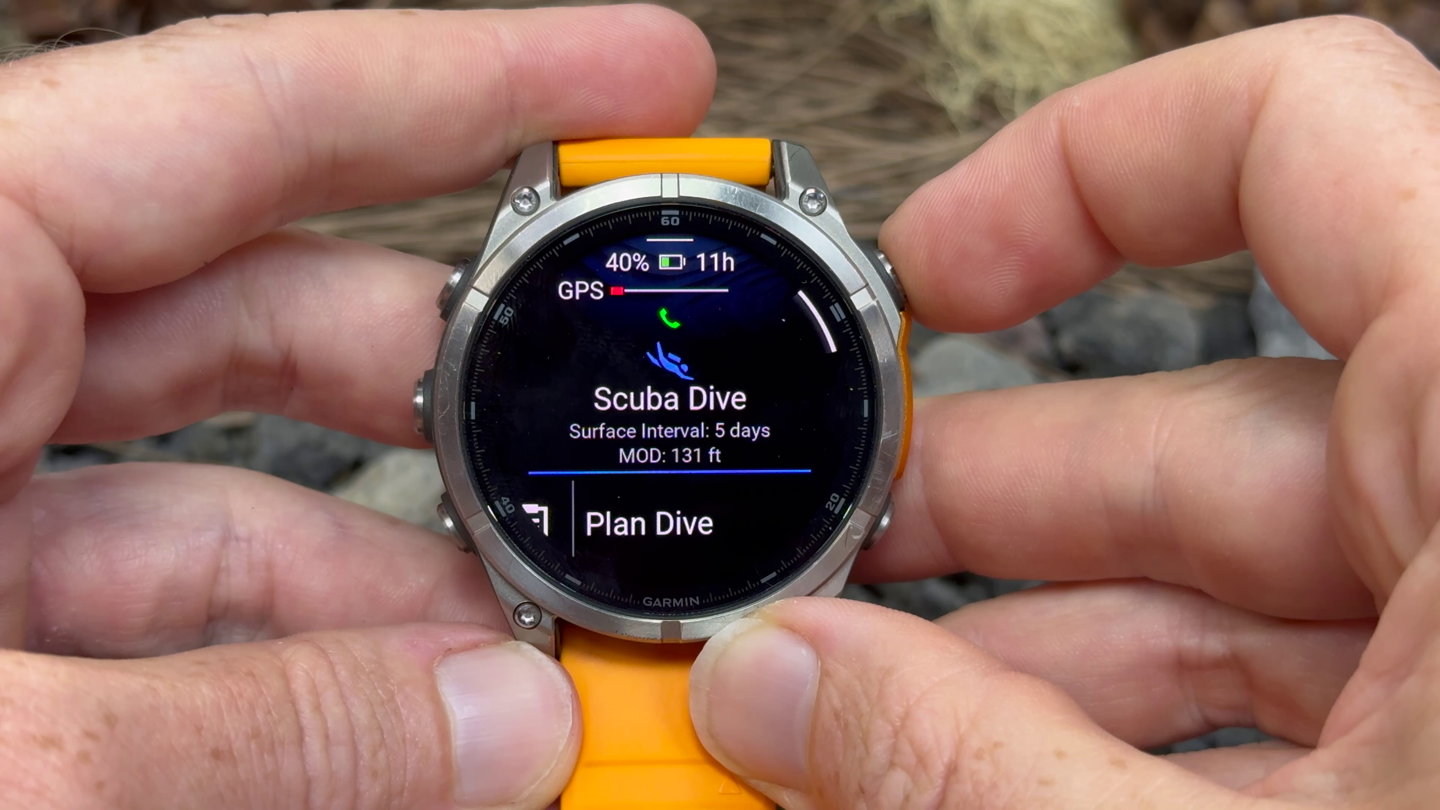
Once you do so, you’ll be hanging out on the Scuba Dive sports page (apnea works virtually identically). This is where you can use the dive planner functionality (to check NDL time for example), as well as configure your data pages/fields (the defaults cover most of what you’d probably want, to be honest).
With that, simply descend. As soon as you go beyond that 4ft marker, the watch will start recording the dive, and start showing you stats appropriately (note the upper portion of this page is different between the two, and of course, you can switch between meters and feet):
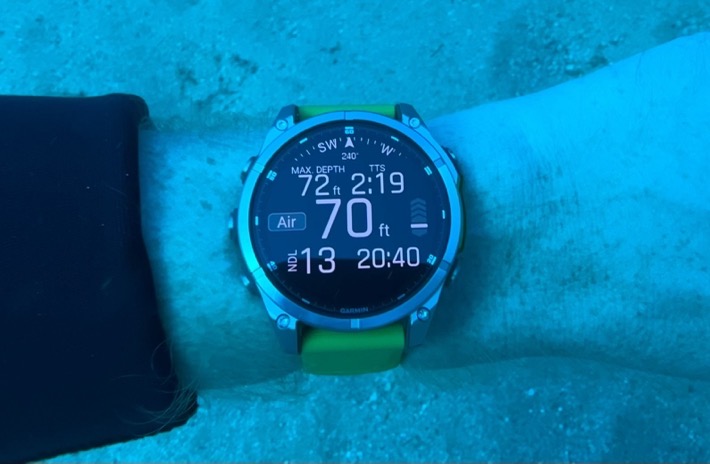
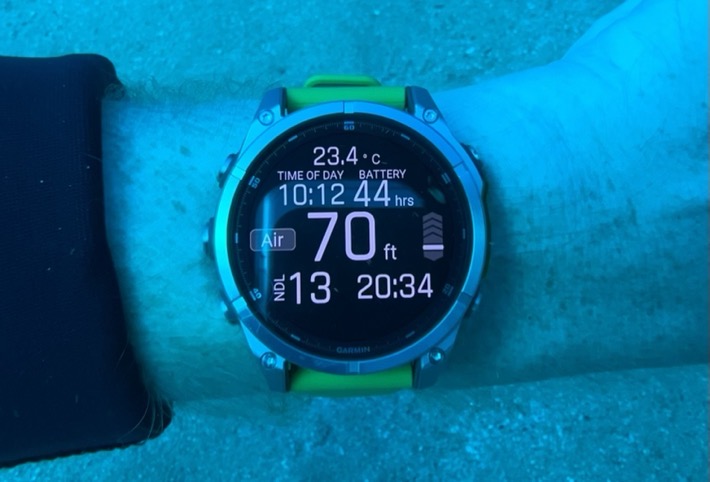
You can change data fields by simply pressing the buttons on the side, which iterate through the data pages, just like in any other sport mode. In the event you ascend too quickly, you’ll get alerts for that too:
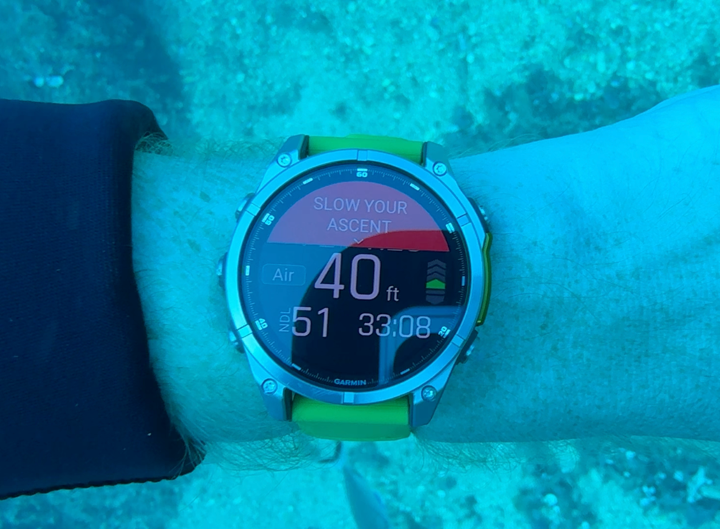
And same goes for reaching various thresholds around NDL (no decompression limit):
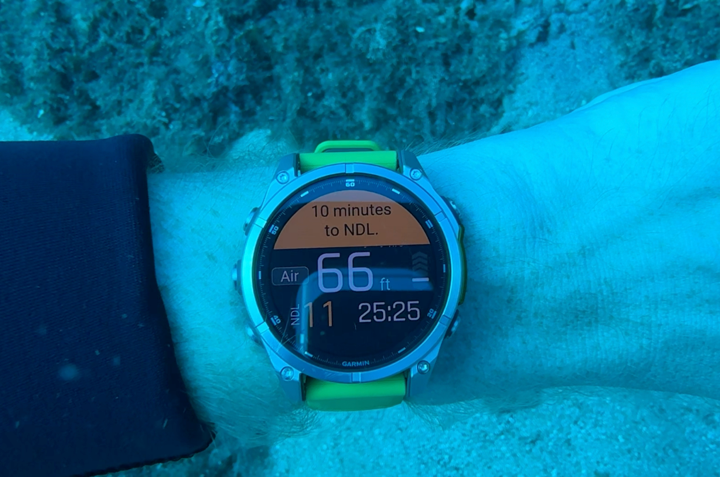
And you’ll also get safety stop notifications too:
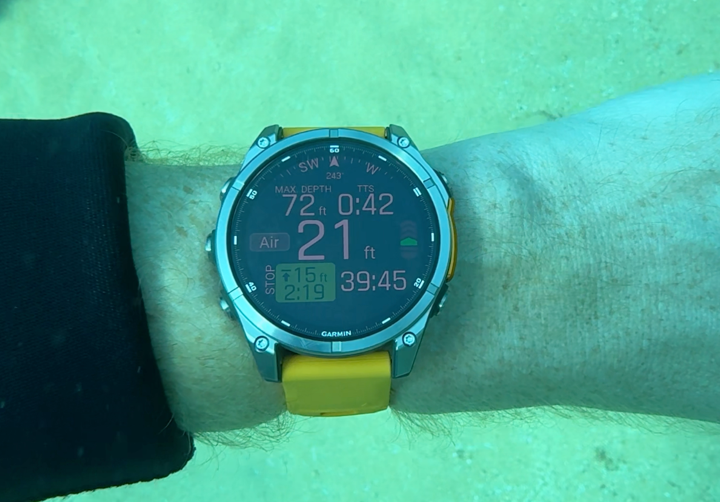
Once you reach the end of your dive, by surfacing, it’ll automatically end the dive within 5 minutes. You’ll see a countdown timer show up on the watch, indicating as such in blue:
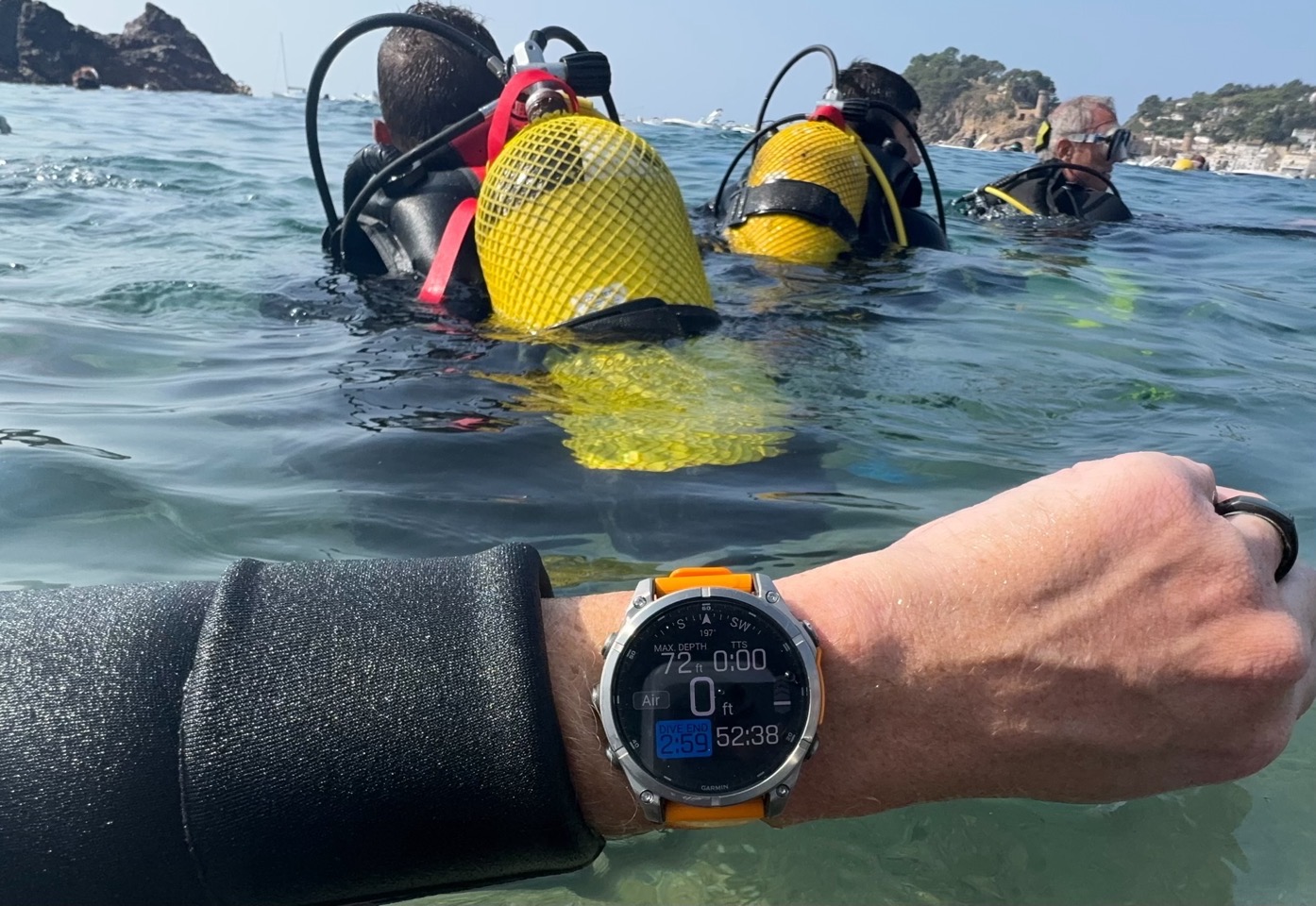
Then afterwards, all of this gets synced to Garmin Connect, and the Garmin Dive app, where you can see the details of your dives in the dive logbook:
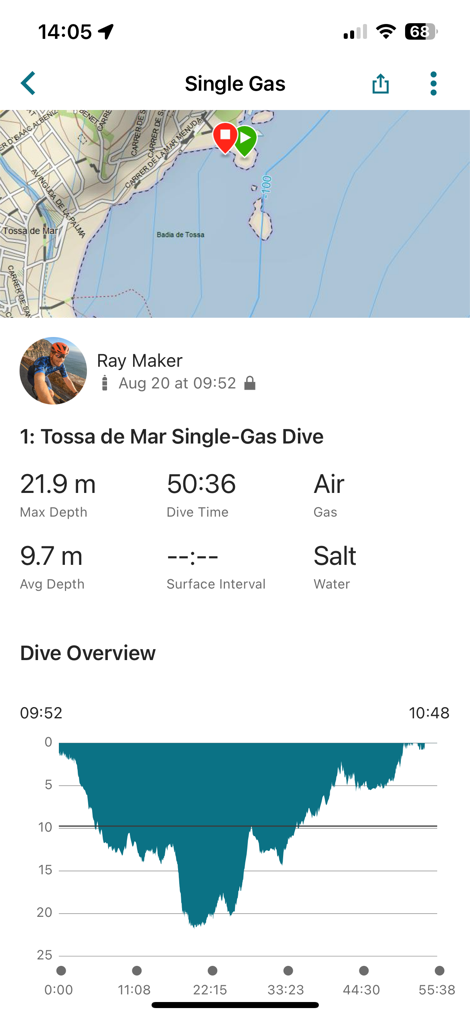
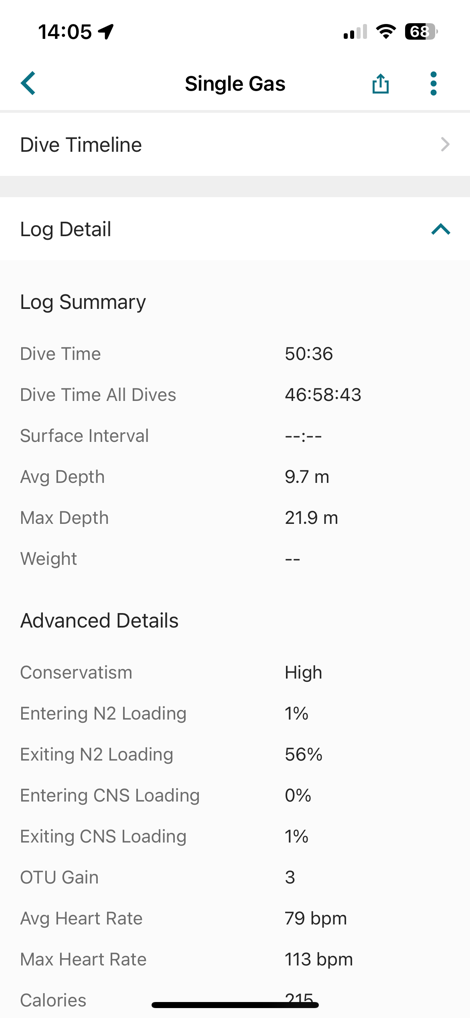
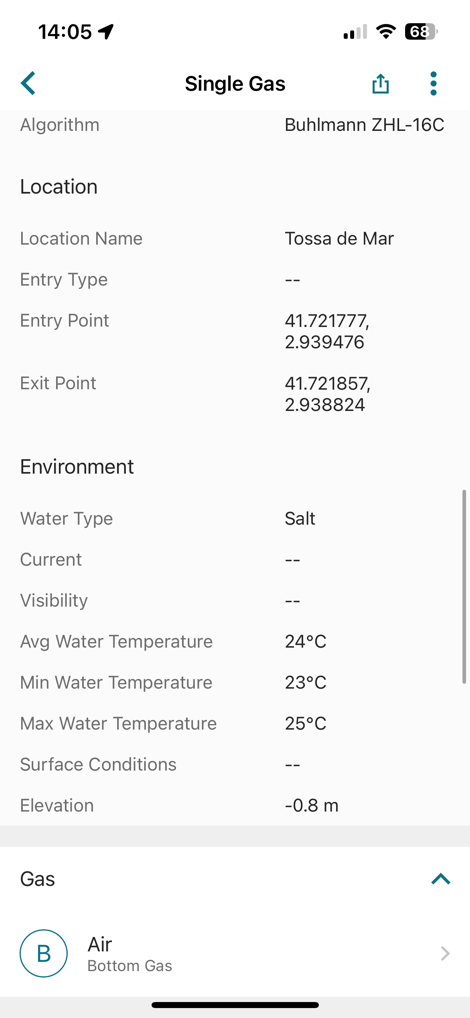
The Garmin Dive app also has the ability to explore various dive sites, and you can upload photos to it that others can see to build a collection around the dive sites. It’s kinda like Strava Maps/Routes for diving, except Garmin owners only. Given the critical mass of Garmin devices over the last 7 years, it covers a heck of a lot of sites.
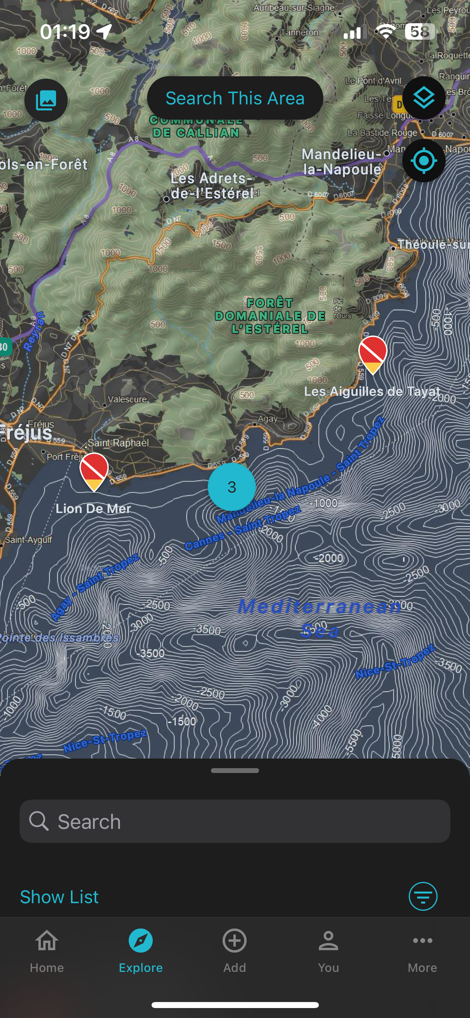
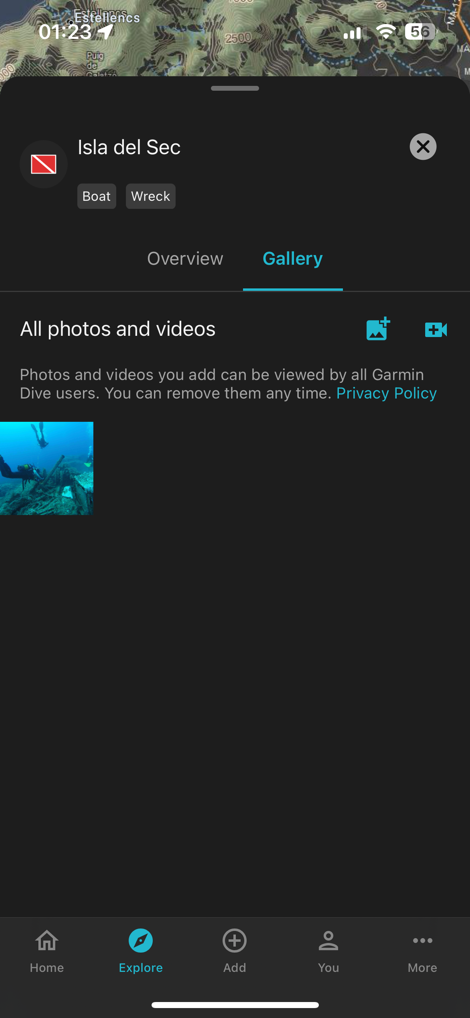
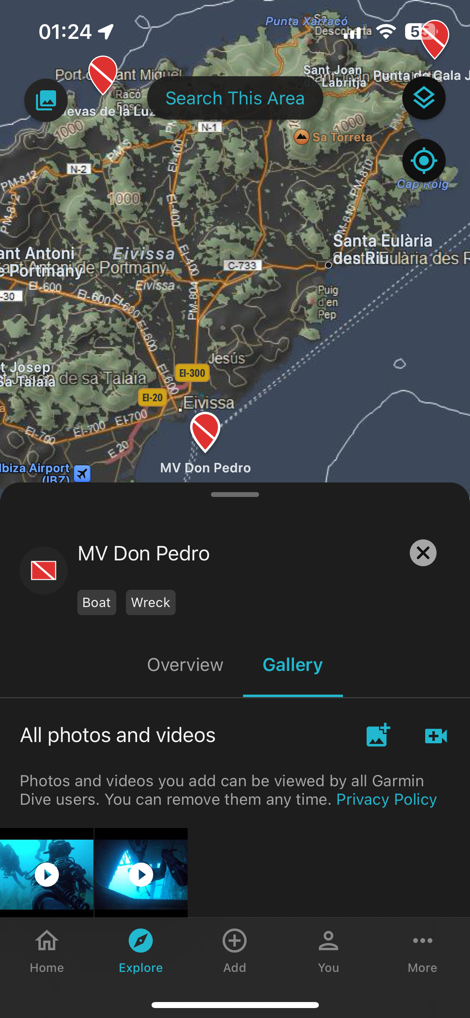
Finally, back on the watch you’ll see your no-fly time and surface interval, as well as tissue loading:

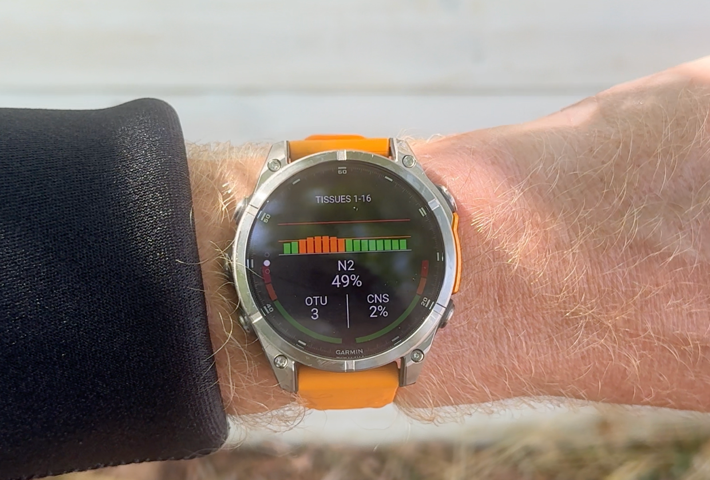
My only quibble here is that the surface interval time will reset for any water events that go below 4ft/1.6m. Meaning, if you jump off a boat/dock/plank into the water to cool-off, you’ll automatically reset the surface interval, and there’s nothing you can do about that (even discarding the auto-dive doesn’t work at present).
Setting that quibble aside, all of the dive features worked without issue for me on my dives. From a technical standpoint, it all worked well, but arguably one of the things I appreciated the most was the lack of subscription piece. Having used the Oceanic app a number of times diving on my Apple Watch Ultra units, I’ve occasionally had subscription-related issues when Internet connectivity was poor (specifically when out of cellular service, even this past week on Oceanic’s iPhone camera dive housing the issue cropped up again). This sidesteps all of that, because it’s just built-in.
Albeit, I did eventually troubleshoot enough of the case, that all of the underwater photos in this section where taken on an iPhone 15 Pro inside the Oceanic case.
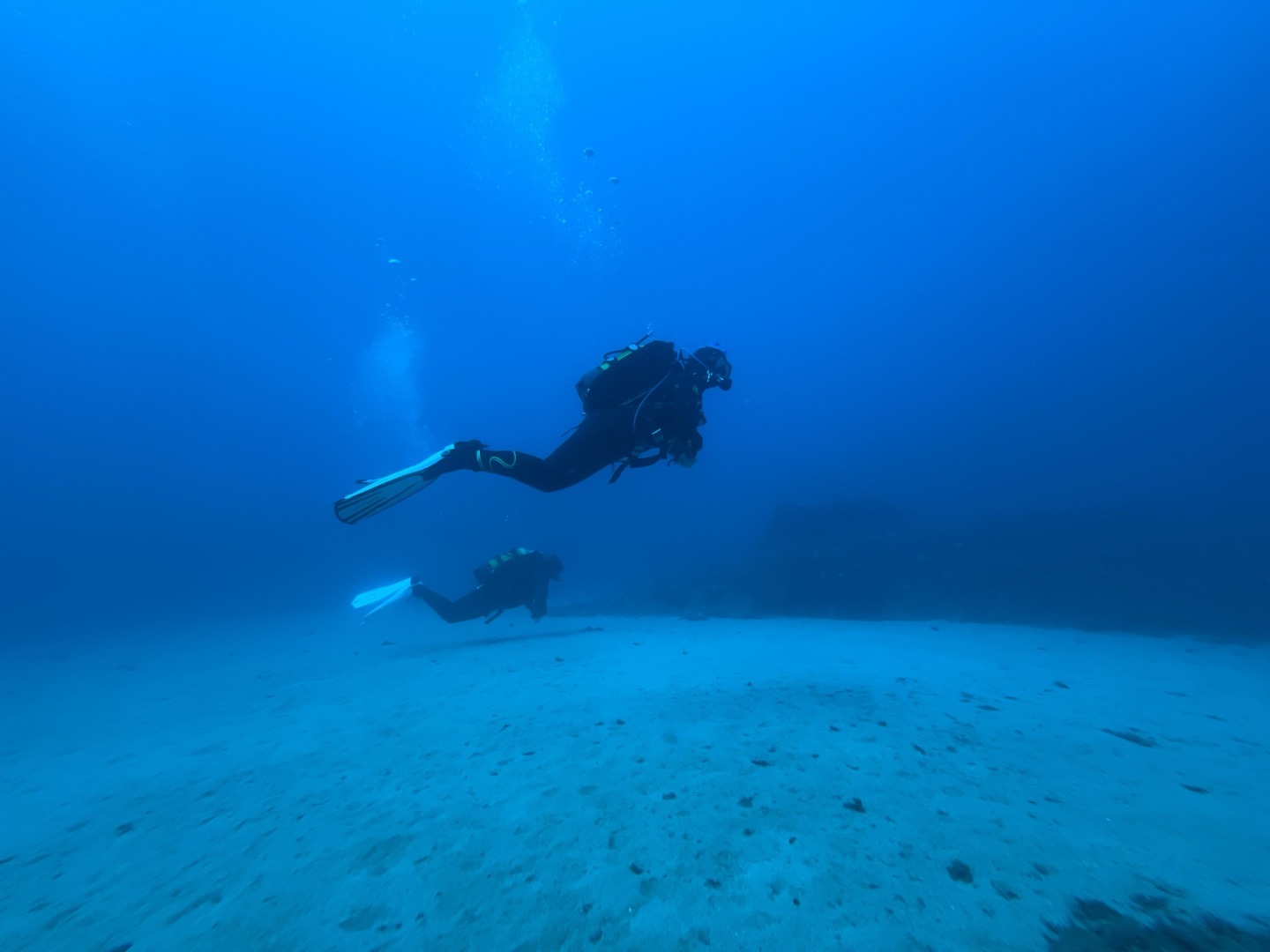
Finally, I want to briefly note about the dive standards used for the Garmin Fenix 8 and Descent MK3i (these standards are also what Apple follows for the Apple Watch Ultra). I do this because any time you talk about water and depth, there’s a weird cult of internet people who try and claim you need a 200m certified device to go snorkeling, let alone diving.
As one who actually owns a dive test chamber, for testing dive equipment, let’s have a fun diversion on exactly how equipment is certified per EN13319. Because yes, I spent €58.86 to purchase the EN13319 international specifications document. You’re welcome.
Within that lovely PDF document there’s a slew of tests that companies do. However, I’ve pulled out the key ones:
– Hammer test (not kidding, there’s an entire separate ISO document on how to do the hammer test)
– Static force test of 150n pressure while on a wrist fixture
– Pressure test to double the stated/claimed depth pressure
– Underwater pressure cycling 200 times to 110% of maximum depth of device claim
– Sea water resistance test for 24 hours
– Temperature tests cycling between above+below water temps at intervals from 20°C down to 2°C, and air temps up to 60°C
– Readability tests, timer accuracy tests, glove tests, responsiveness tests, etc…
But wait, it gets better, there’s actually a specific order of the testing. Failure at any point causes failure of the test. So basically, first you temperature cycle it a gazillion times, then you whack it with a hammer, then you leave it underwater for a day, then press hard on it, then you cycle it 200 times, and on, and on. Garmin has confirmed the Fenix 8 is EN13319 certified against a 40m specification, though contains a 100m water resistance rating (separate from the depth gauge components).
Again, this has to be done in this specific order:
1) Temperature cycling
2) Shock test (hammer)
3) Sea water resistance (24-hour test)
4) Static force wrist fixture test (150n)
5) Pressure cycling (200 times to 110% of maximum depth)
6) Water tightness test
7) Readability test
8) Accuracy test (inclusive of over-pressure test)
9) Dive timer test
10) Operability test (using gloves to push buttons at depth)
As a reminder again, failure at any point causes failure of the *entire* test. And I’m only covering just the durability aspect of this document, let alone all of the other specifications (from exactly when the timers must trigger, their variance allowances, the exact specifications to make artificial sea water, and so forth). I find that once I outline the above though, the ‘thou shalt not snorkel without a 200m certified device’ crowd, silently stops arguing. Point being, going for a 40m deep dive isn’t really a concern here, in terms of durability.
GPS & Heart Rate Accuracy:
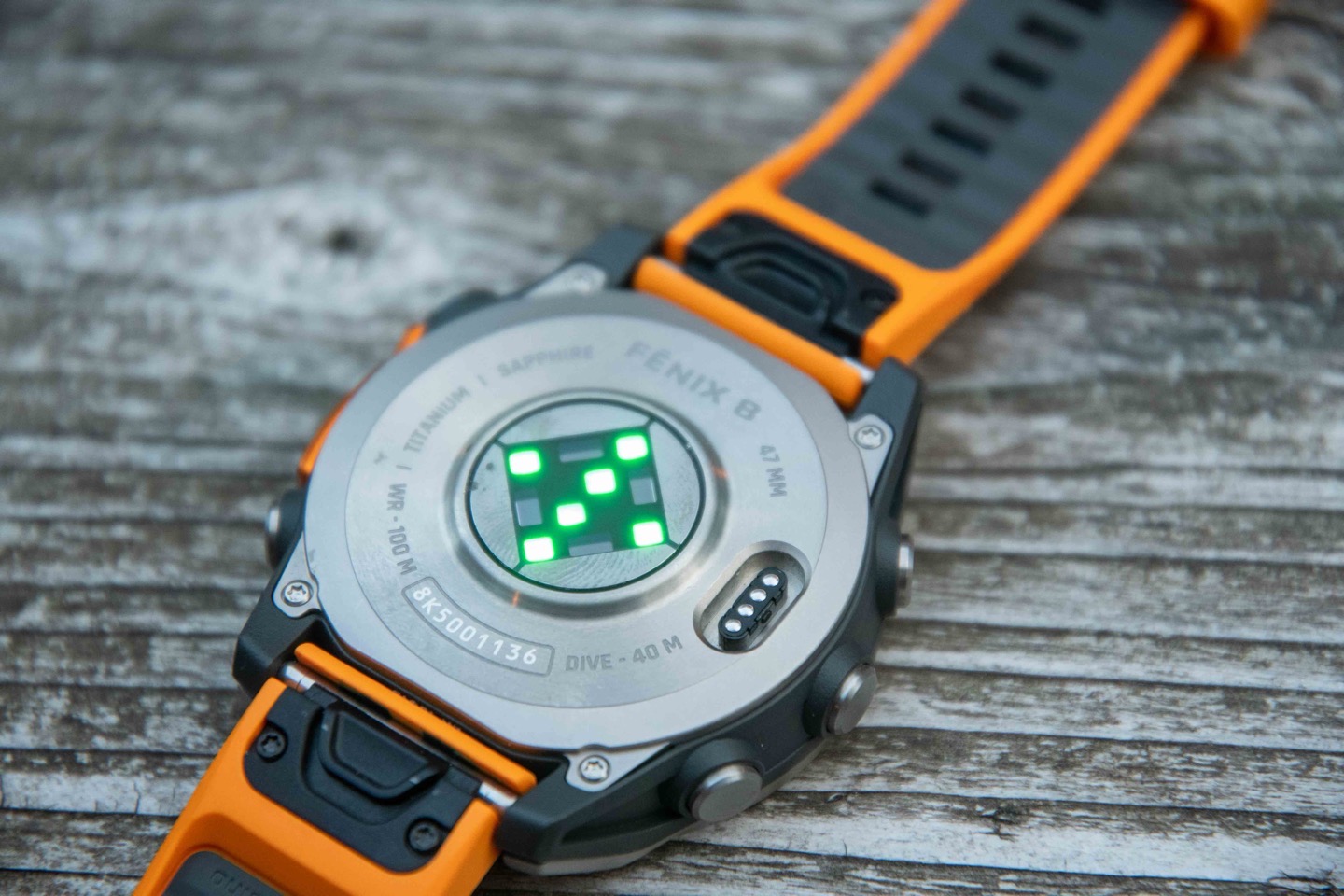
In the event you want to save some time, this section is ideal for saving time to skip. The Fenix 8 uses the same GPS components and multi-band/dual-frequency design as the Fenix 7 Pro & Epix Pro. Concurrently, it also uses the same new optical heart rate sensor as seen last year on those watches. And all of my testing shows it results in virtually identical results to those watches, which was quite good then, and continues to be good now.
In short, the Fenix 8 is still industry-leading when it comes to GPS accuracy across every sport I tested it on (openwater swim/bike/run/hike), including across both dense tall building city and very challenging mountainous terrain. This group of GPS leaders includes Garmin, Apple, and Suunto (latest variants specifically). While the optical heart rate sensor also continues to be in the group of industry-leading companies (including Apple).
Nonetheless, let’s take a quick look at some data sets for funsies. We’ll obviously get right into the challenging stuff, to save both you and I time. This is my downtown city test. It’s where I run up and down a tight corridor of buildings that are roughly 20-30 stories tall. And here’s how the Fenix 8 handled:
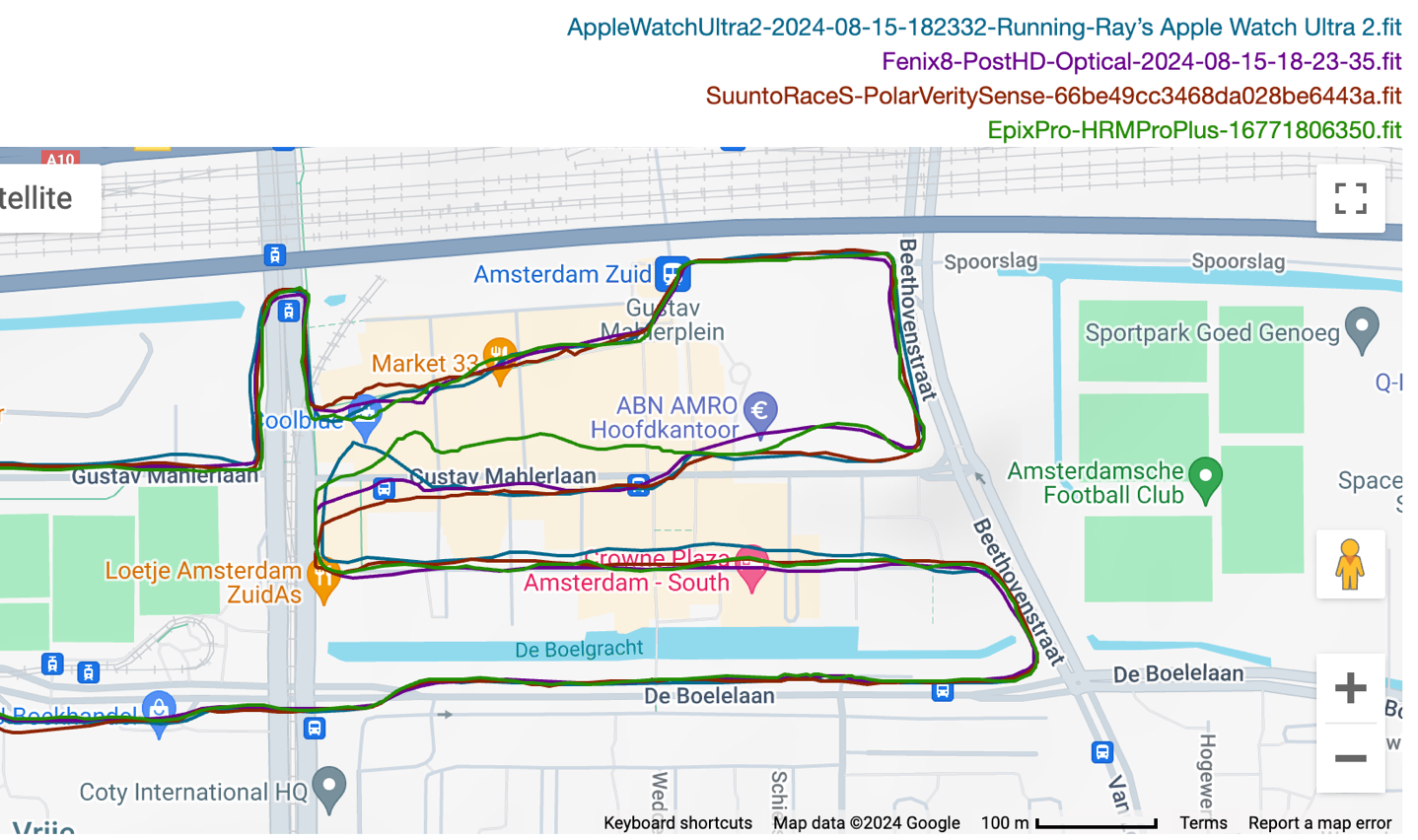
As you can see, there were no meaningful issues from a GPS standpoint – beating the Epix Pro and basically a wash with the Apple Watch Ultra 2 (they both made some errors on the middle turn). At the same time, I also did short and intense intervals to see how the optical heart rate sensor would react. That too, showed no problems:
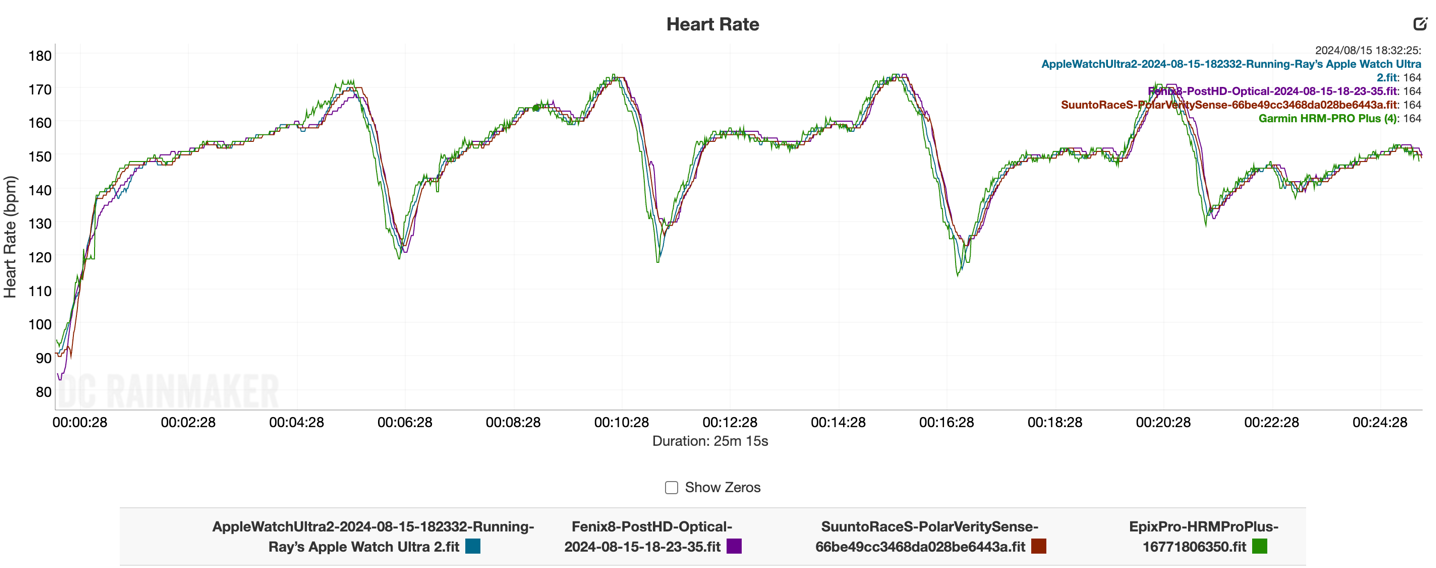
Next, here’s a city+mountain+castle run. The castle adds no difficulty for the watch, except the suffering for me to get up to the top of it. This too, showed good accuracy, even as I swept back and forth on the tiny streets of this seaside town (which was packed with tall apartments/hotels lining said streets):

Here’s that result:

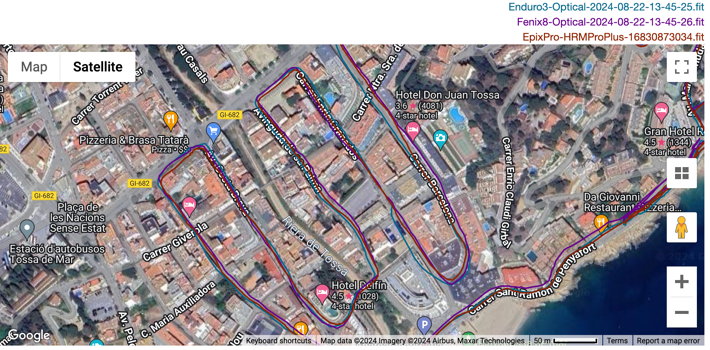
Again, I did some intervals here, just for fun:
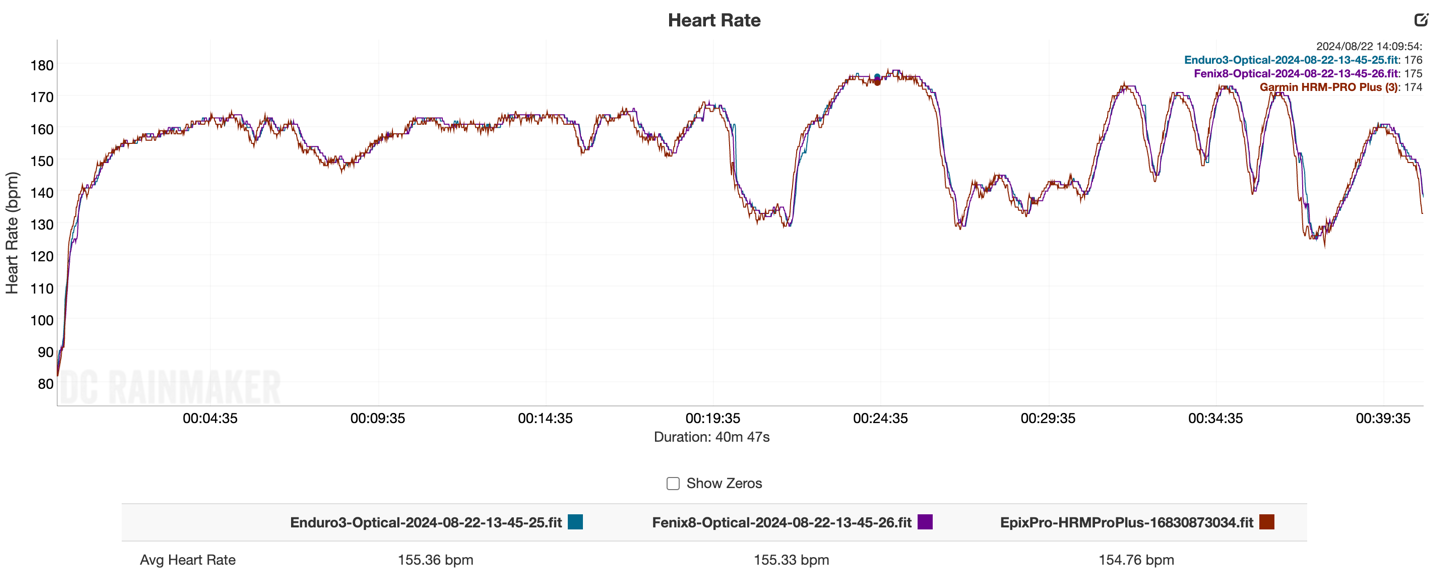
And again, no problems.
So, switching over to cycling, this time along a coastal road-riding route that was anything but easy GPS. We were constantly up against sharp cliffs, steep turns, and tunnels. Still, no problems:
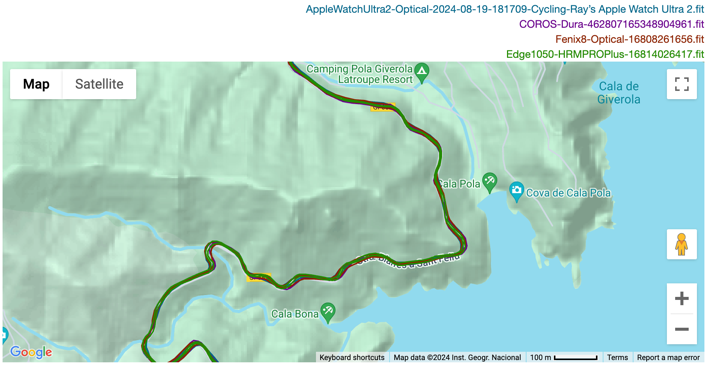
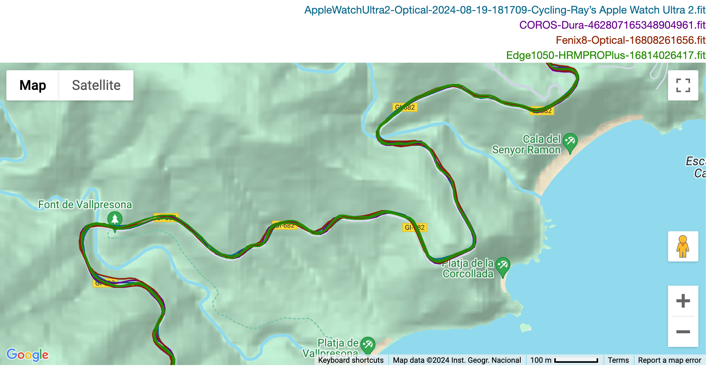
And meanwhile, on the heart rate side, surprisingly good actually, save perhaps 3 moments where it lost the plot. As always, outdoor cycling is hard for most companies, but we do see Apple beat Garmin in a few cases on this ride, in terms of matching the chest strap.
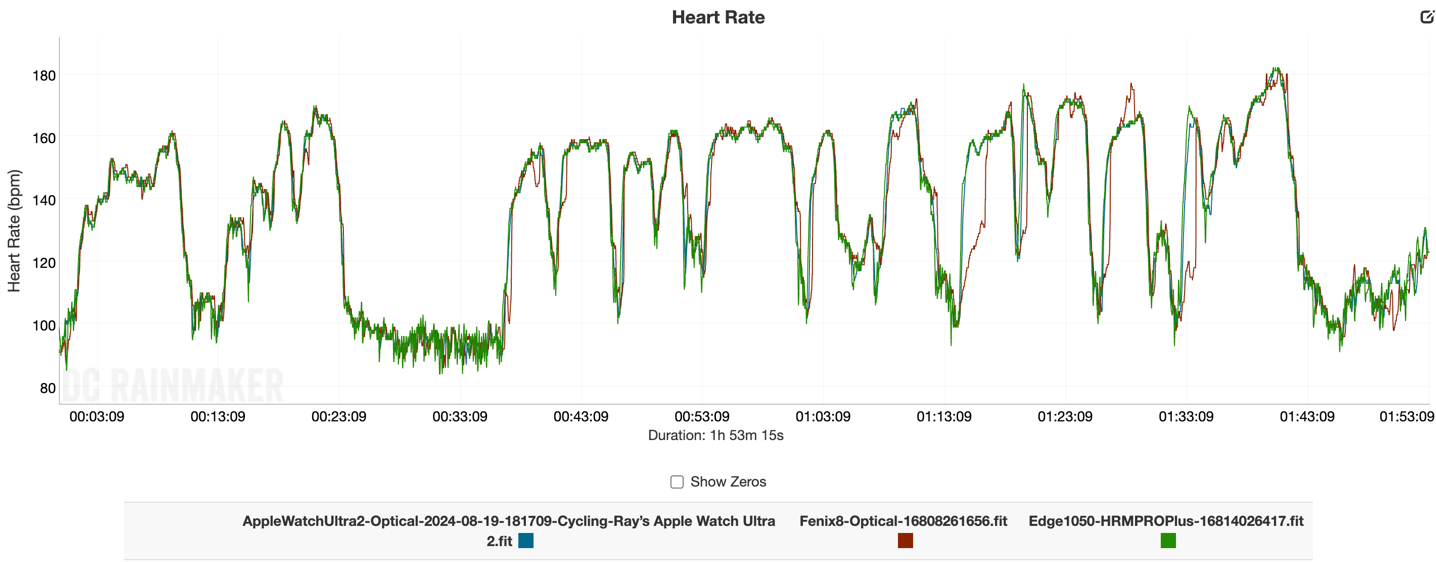
Same goes for this gravel ride, this time under quite a bit of tree cover at times. Of course, once you add vibrations to a wrist-based optical sensor inside a watch, you start to see accuracy issues. And that applied here as well, with some variations that are normal to see. Still, this time it was Apple’s turn to have more failures than Garmin. As you can see, sometimes it’s just variable who the winner is.
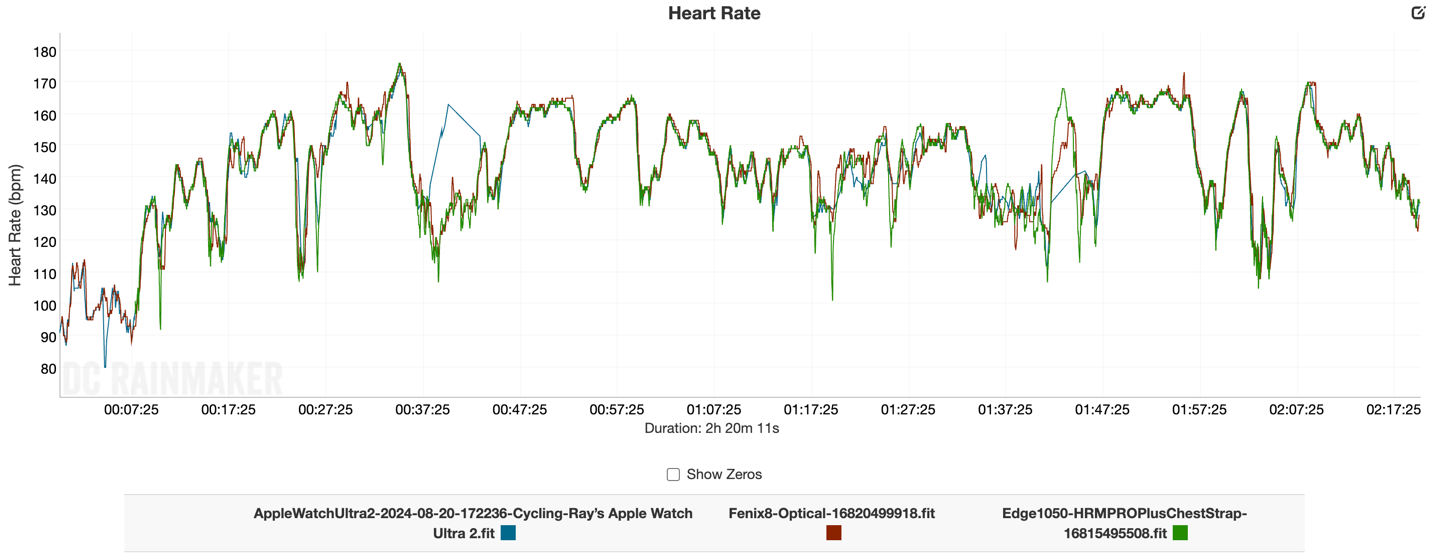
Next, heading up into the Pyrenees mountains for testing, focused here mainly on GPS accuracy. That’s because while heart rate data is interesting, it’s kinda messy to try and deal with 9-10-hour activities where the heart rate is often considerably lower, and you’re also using things like hiking poles for stabilization/etc. That said, for all but a handful of seconds, the optical HR sensors matched the chest strap.
In any case, let’s look at a couple of challenging GPS scenarios, namely really steep sections in dense trees with nearby cliffs, such as this. In this case, the Enduro 3 was on the least-accurate GPS-Only mode (for some battery testing I was doing to see if the tradeoffs were worth it), whereas the other two were in SatIQ (enabling them to use multiband as conditions warranted). In my Enduro 3 review, I’ll show some side-by-side bits where another Enduro 3 watch on my friend was in SatIQ mode (and we were side-by-side the entire day). But for now, my watches:
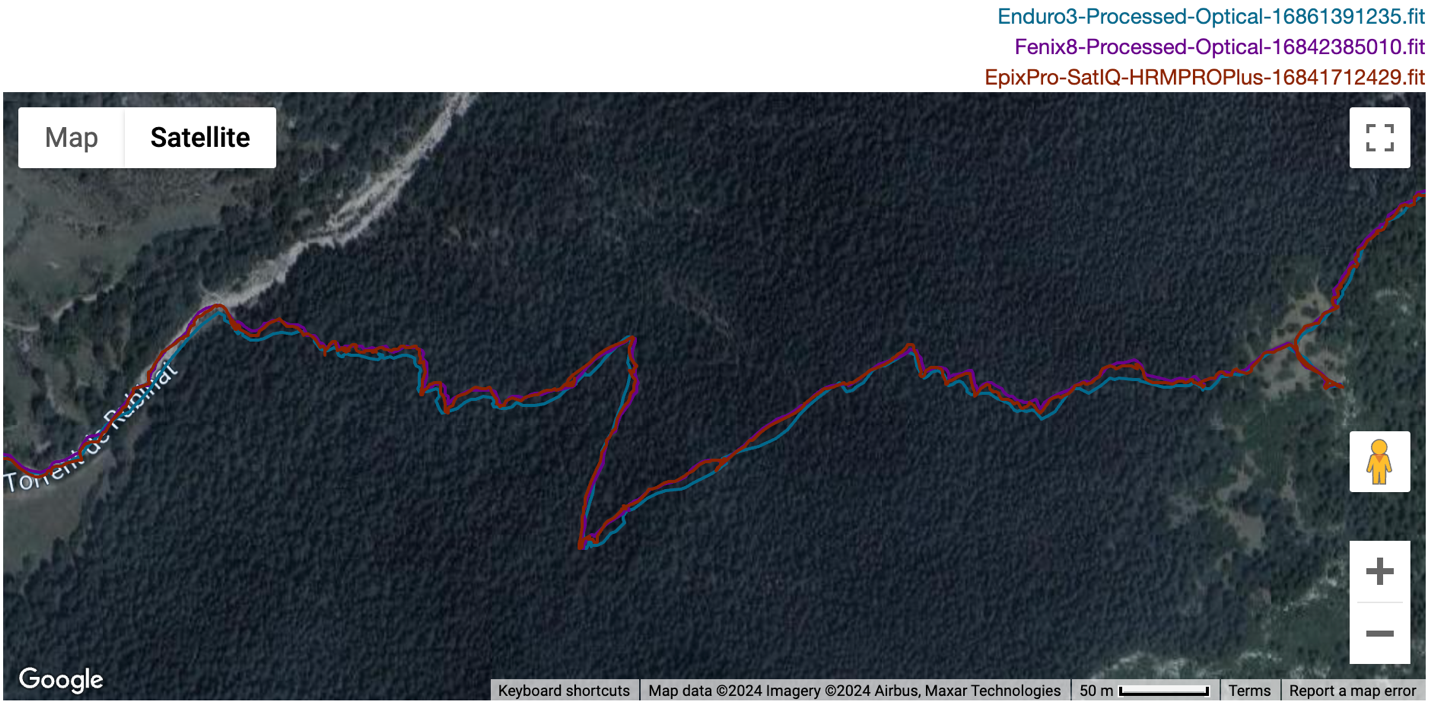
You can see the two more granular tracks of the Fenix 8 and Epix Pro in SatIQ mode, virtually identical, whereas the GPS-Only Enduro 3 was a bit more free-form (as expected in that mode).
As we move along the overhang of some vast cliffs, all three watches are surprisingly close, but you can see some slight differences on this very steep switchback section.
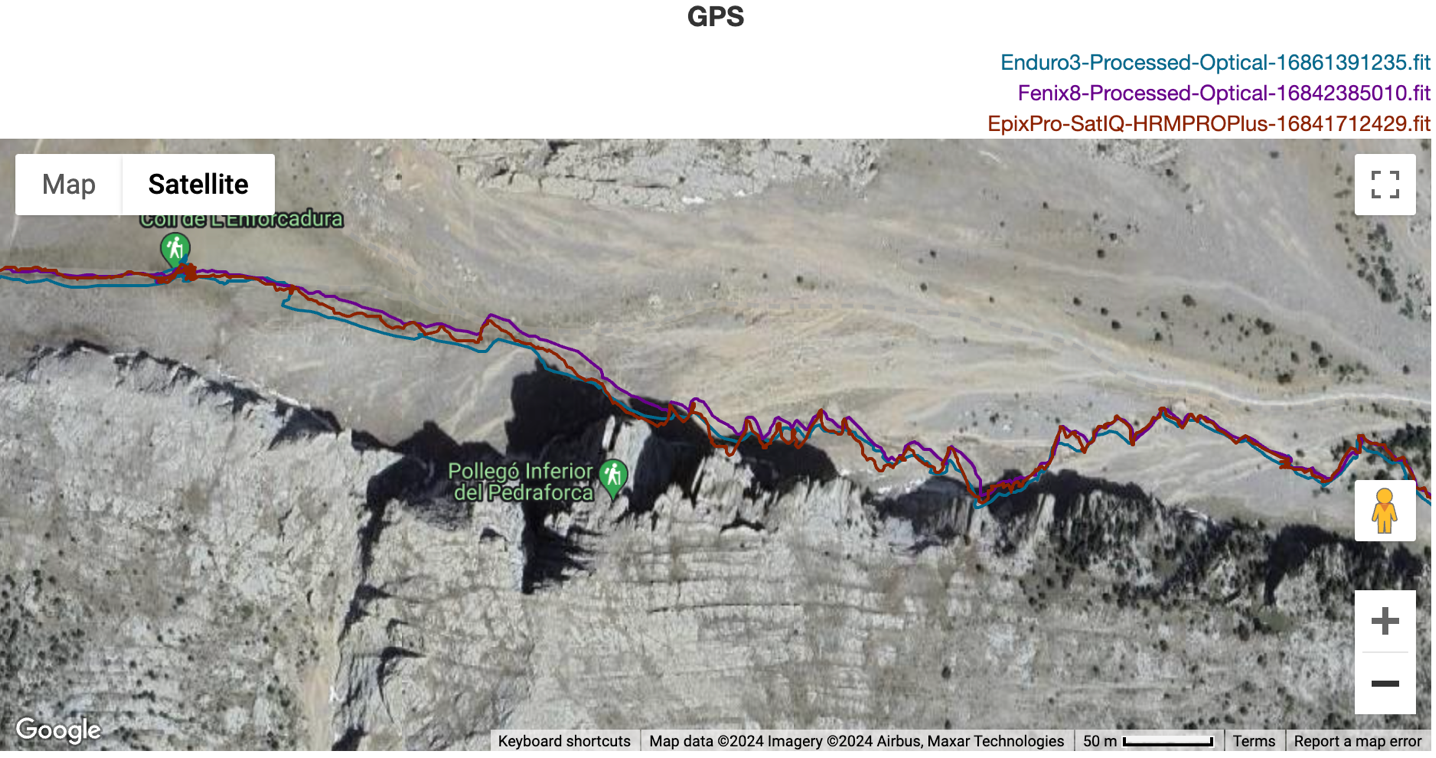
Whereas on some upper elevation meadows with open air, the three are far tighter together.
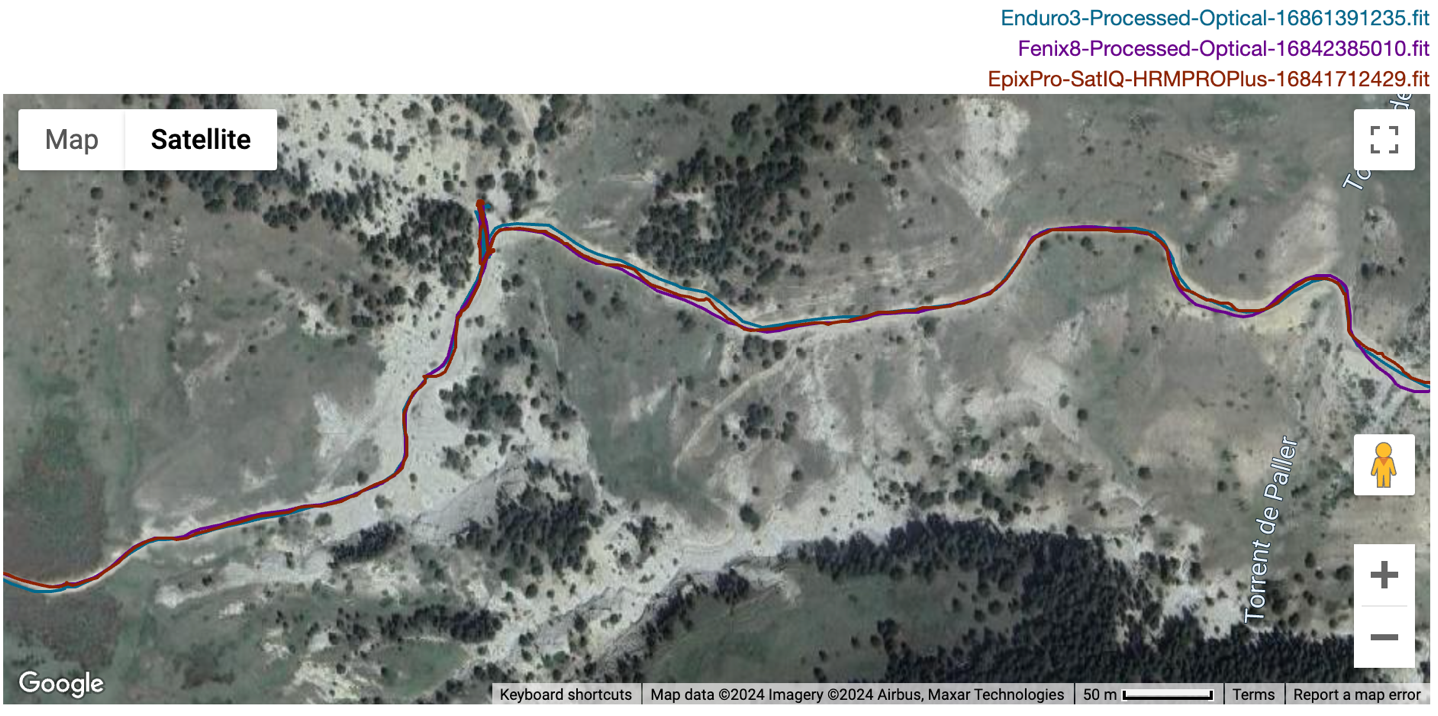
This despite the conditions at the time being dumping rain, hail, and wind. Along with never-ending thunderstorms:

Finally, a quick openwater swim (different from the photo above, which also felt like a swim). Or, it was quick until I ran into a flotilla of jellyfish. At least they were pretty:

In any event, as for the actual GPS tracks, those too were pretty, virtually spot-on with the swim buoy. That tiny blip you notice just north of the island is where I found the jellyfish flotilla, and got distracted going underwater taking photos of them. But even then, the GPS tracks were within a few meters of the reference. Here’s the data:
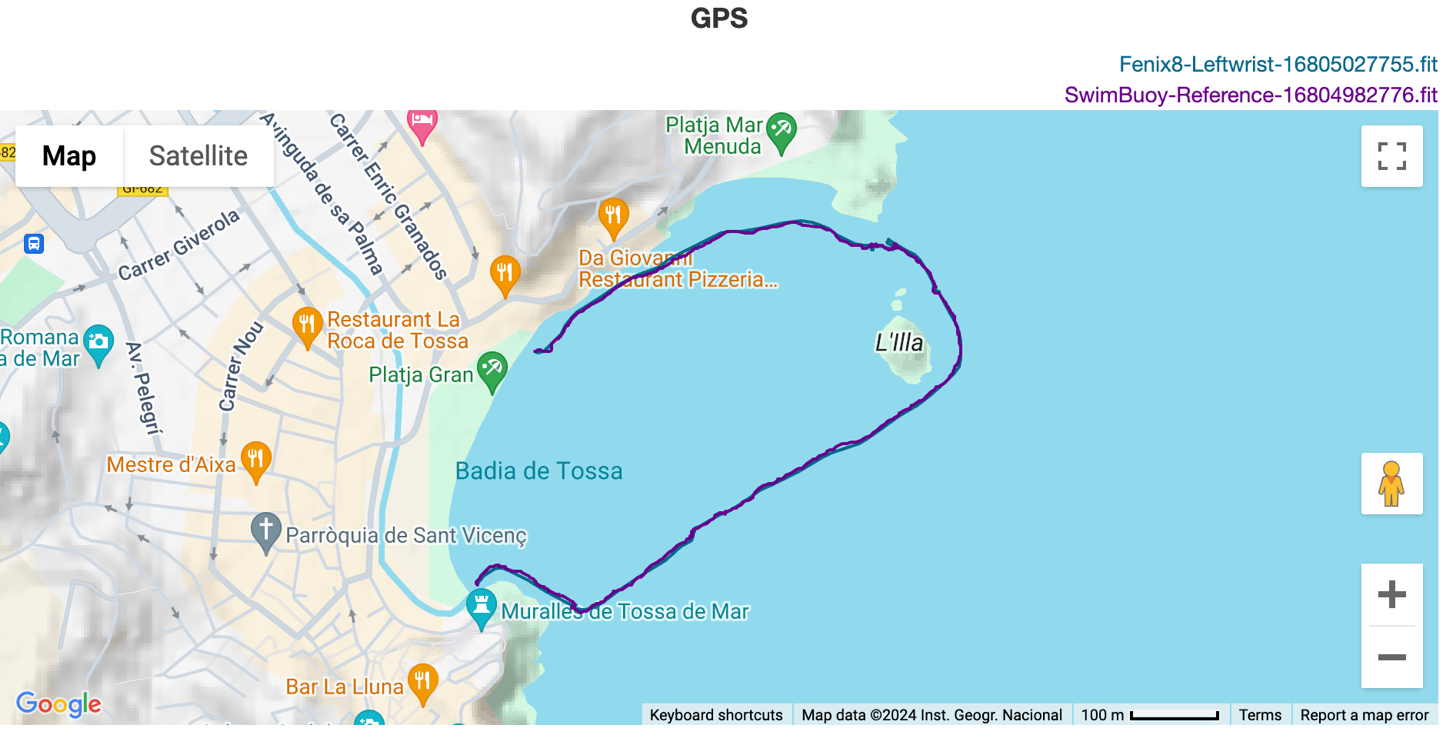
Ultimately, as I said at the beginning, the accuracy here for GPS continues to be among the best (if not the best) in the wearables world. And from a heart rate standpoint, it’s exactly what we saw with the Fenix 7 Pro and Epix Pro last summer, with generally very strong accuracy and only rare mistakes.
Now interestingly, one feature that’s somewhat hidden away, is a new option to automatically process GPS tracks for correction, using internal sensor data. Meaning, if the watch detects that the GPS accuracy was non-ideal during the workout, it’ll flag the file to be analyzed by Garmin Connect online, leveraging the sensor data inside the watch (e.g., accelerometers, compass, gyro, etc..) to try and correct for said bad GPS data. This is specifically for only pedestrian activity and openwater swims (since those are activities that can look at things like arm movement to try and normalize against). The concept sounds roughly akin to what Suunto has previously called ‘FusedGPS’, except it sounds like Garmin is leveraging cloud computing to likely run more variables. Note that map data isn’t part of the correction set (whereas Apple, for example, does use map data for the corrections).
In all of the examples above, I used the end-state files that a consumer would ultimately see. Meaning, the corrected files, and all using the Garmin SatIQ (Autoselect) setting. Note that it *only* will correct non-ideal files. Perfectly fine GPS conditions don’t get corrected.
However, for funsies, through a somewhat convoluted process, I can show you before/after examples. This gets most interesting when you start to look at using the GPS-only setting (the lowest level of GPS accuracy, but the least battery burn), and then letting the corrections sort things out afterwards. I’m going to do a totally separate post with all that data later this week. But it includes plenty of interesting data sets, including extra Fenix 8 watches on my hike in different configuration settings.
(Note: All of the charts in these accuracy sections were created using the DCR Analyzer tool. It allows you to compare power meters/trainers, heart rate, cadence, speed/pace, GPS tracks, and plenty more. You can use it as well for your own gadget comparisons, more details here.)
Battery Testing:
When it comes to battery testing, the unit appears to easily meet the specifications laid out for it, in both smartwatch mode as well as sports/GPS modes. In the case of smartwatch mode, I used the 47mm (medium) sized AMOLED unit in an always-on display configuration. In doing so, I was getting a strong 6 days of battery life despite 1-2 hours of GPS time per day (SatIQ mode). I’ll be spending more time with the other sized models (including the Solar variants) in the coming weeks to plot that battery life, but I only had so many wrists available, and the other wrist had the Enduro 3 on it.
Meanwhile, for GPS battery life, I focused on two longer tests of hikes in the 8.5 to 10-hour range, into the mountains with challenging GPS conditions. For this first hike, the unit was on SatIQ with navigation enabled, and left on the map page *the entire time*. Seriously. Always-on display as well, thus, the biggest battery-burning possibility. Here, you can see the results (the Enduro 3 was also left in map always-on mode, but in GPS-only mode):

The next day, I changed things up. I left the Fenix 8 AMOLED in mostly ClimbPro mode (data fields, which burn less battery than the map page), and did the same for the Enduro 3. However, I also added a GPS-only Fenix 8 as well (connected to a HR strap), to see how that might differ. As you can see, the Fenix 8 in SatIQ mode easily beat the claimed specs for battery burn, and that’s ignoring the fact that the battery specs don’t account for navigation (which burns more battery):
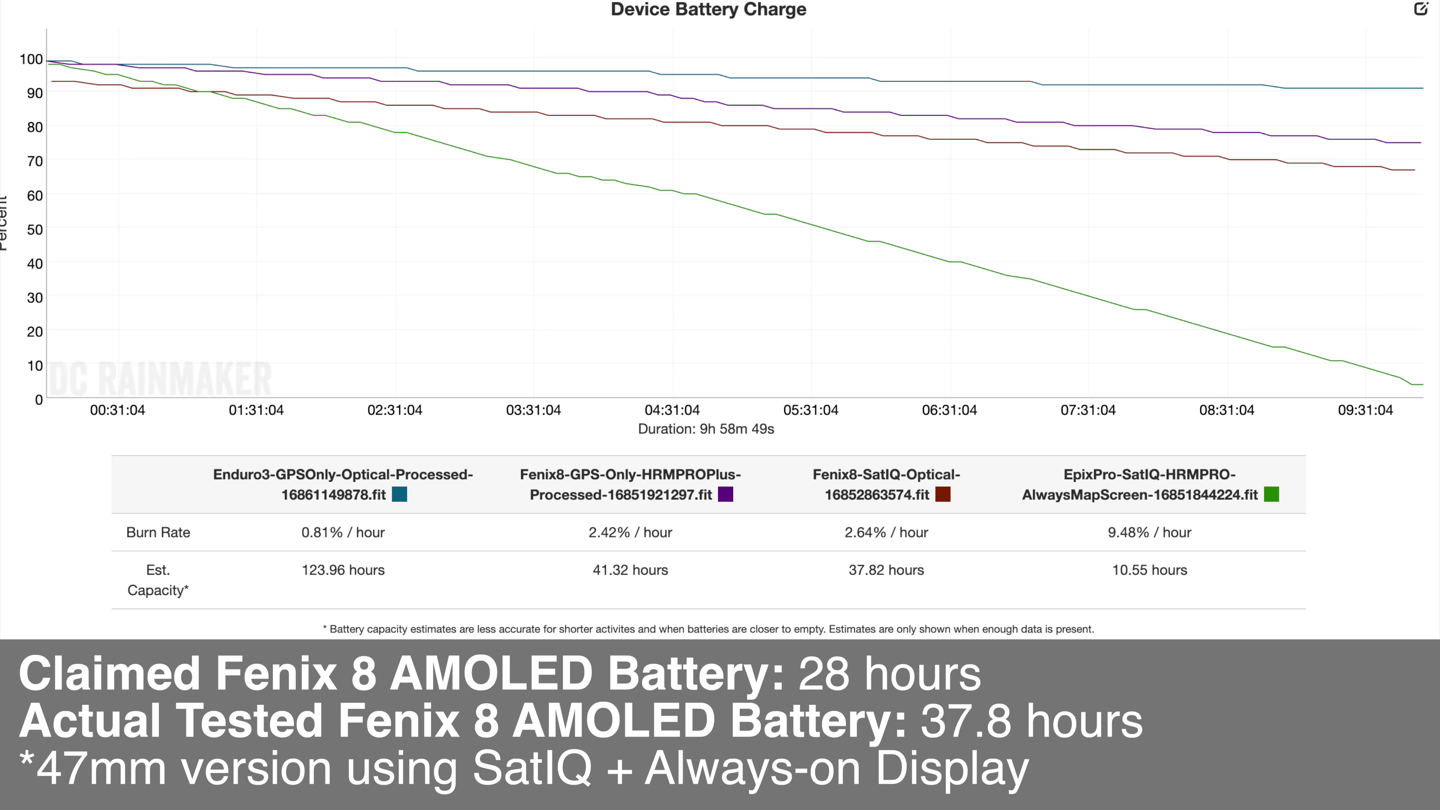
Again, more testing to come on the various models, but everything is looking very solid in this realm.
Wrap-Up:
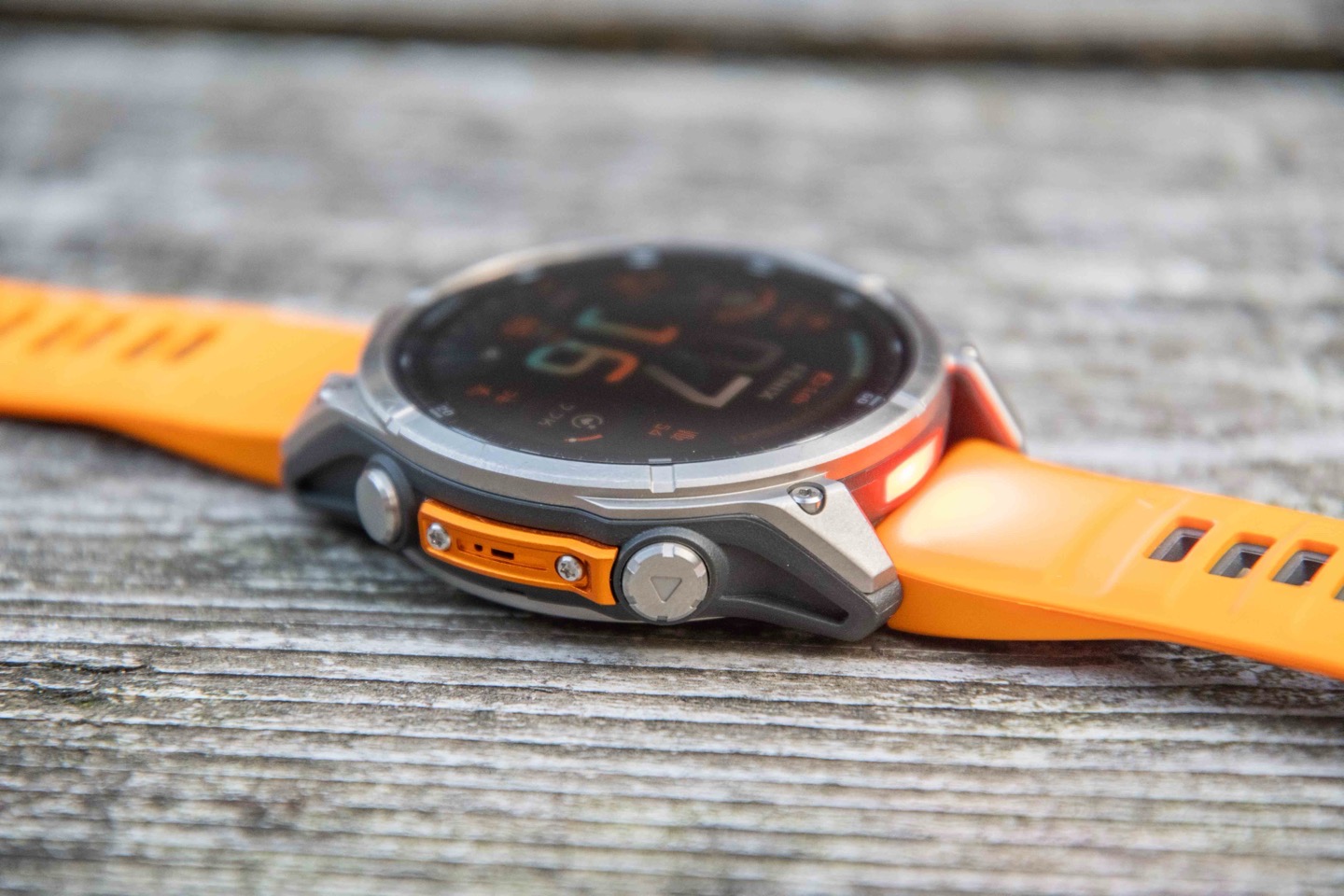
As a company, Garmin hasn’t gotten to the level of recent success it’s enjoyed without producing great watch products. And from an engineering and technical standpoint, the Fenix 8 is a great watch. I don’t have any substantive issues there, aside from some minor gripes about the new user interface changes seeming a bit unnecessary at times. But like most things, I’ll get used to it. But in terms of features like the new dive functionality, it’s well-executed and importantly, doesn’t feel like a play to make you go out and buy a Descent MK3 instead. For the vast majority of divers, it’ll be exactly what they wanted.
Thus, I suspect people will find themselves in one of two camps when it comes to their opinions of the Fenix 8:
A) Feel that the pricing jump of $200-$300 for MIP-based owners, and $100 for AMOLED owners are unjustified given the lack of non-dive/non-speaker features
B) Are thrilled with the new speaker and dive features, and don’t mind the additional cost.
For me, I largely fall in the first camp. I love the new dive features and appreciate Garmin kept most of the features from the Descent lineup. Yet at the same time, I personally just don’t care much for the microphone/speaker features. I rarely use them, and features like audible trail/hiking turn-by-turn notifications that I might actually use, aren’t there (they still rely on your phone). Instead, the much desired cellular/LTE connectivity (for at least safety features), is still missing. That’s hard to reconcile when my kids $149 Garmin Bounce watches have had it for nearly two years, and the Forerunner 945 LTE for three years. I’d have had no problems paying the extra $100-$200 for that.
I get there’s tremendous demand within Garmin for an annual Fenix release cycle. But the key to making an annual release cycle work (à la Apple, Google, or Samsung), is they keep pricing basically the same each year, and bringing in modest hardware improvements, alongside other software/feature improvements. Yes, Garmin does an exceptionally good job the rest of the year in delivering Fenix software features to existing watches (far more than Apple/Google/Samsung) under their quarterly firmware update program. And perhaps the ‘problem’ is they’ve delivered so many of those ‘gifts’ recently, that there just wasn’t much left to give here on Fenix 8 by itself. And, unfortunately for Fenix 7 owners, none of the new UI pieces/features are going back to previous watches.
Point being, while the Fenix 8 is very much the best Fenix (or Epix) that Garmin’s ever made, I think it missed the mark in terms of balancing new outdoor-focused sports features with the new pricing scheme. Especially when you consider the price of the existing Fenix 7 units that are constantly on sale.
With that – thanks for reading!
Found This Post Useful? Support The Site!
Hopefully you found this review/post useful. At the end of the day, I’m an athlete just like you looking for the most detail possible on a new purchase – so my review is written from the standpoint of how I used the device. The reviews generally take a lot of hours to put together, so it’s a fair bit of work (and labor of love). As you probably noticed by looking below, I also take time to answer all the questions posted in the comments – and there’s quite a bit of detail in there as well.
If you're shopping for the Garmin Fenix 8 Series or any other accessory items, please consider using the affiliate links below! As an Amazon Associate I earn from qualifying purchases. It doesn’t cost you anything extra, but your purchases help support this website a lot.
Here's a few other variants or sibling products that are worth considering:
And finally, here’s a handy list of accessories that work well with this unit (and some that I showed in the review). Given the unit pairs with ANT+ & Bluetooth Smart sensors, you can use just about anything though.
And of course – you can always sign-up to be a DCR Supporter! That gets you an ad-free DCR, access to the DCR Shed Talkin' video series packed with behind the scenes tidbits...and it also makes you awesome. And being awesome is what it’s all about!
Thanks for reading! And as always, feel free to post comments or questions in the comments section below, I’ll be happy to try and answer them as quickly as possible. And lastly, if you felt this review was useful – I always appreciate feedback in the comments below. Thanks!




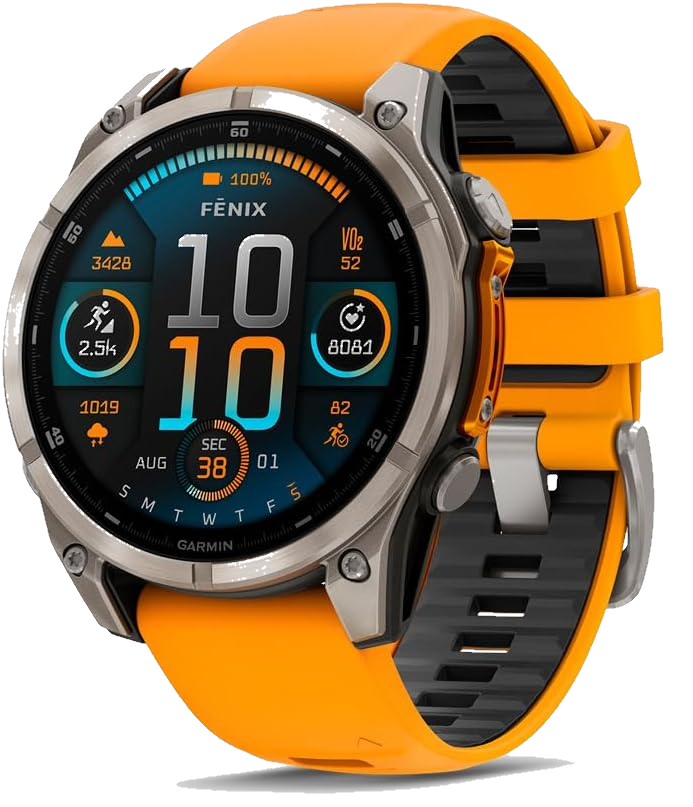
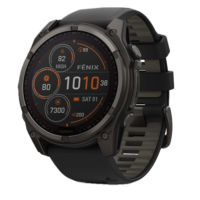
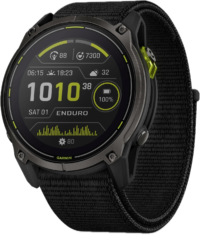
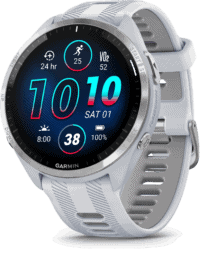
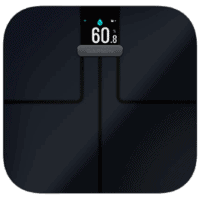
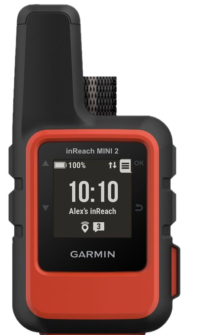
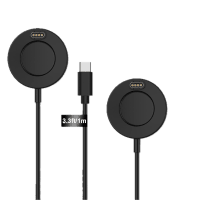

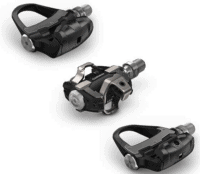
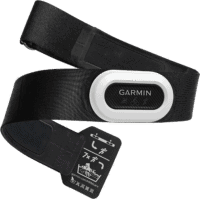





















These prices are crazy…
Yep, just crazy ….And this charging port.
Will Garmin ever bury this stupid charging port and bring something like Apple, Polar or Suunto?
This is my feeling. I’ve had Garmins since the Forerunner 301. I have only ever hated any of them because of the stupid charging/usb connection recently. It is horrible! Fix it. For 1000 dollars I expect to be able to charge without wiggling the connection for hours and then gingerly setting it down like it’s a bomb, hoping it will charge! :)
Haha so accurate… I hate this thing, fricking get rid of it already
It’s the same like with cellular: they have wireless charging in another watch: garmin marq.
I don’t get it why they don’t give us a fenix update where they bring all this stuff together…
I was all set to buy the small one for my wife and the big one for me… and then saw the charger hasn’t changed. I’m out. I’ll just wait, possibly forever, to upgrade our Fenix 5s until they
Fix the worst feature of any watch ever made.
@lexusburn The Marq charger is different (and IMHO much better), but it’s not wireless.
Hmmm. The lack of 43mm MIP model and the price hikes makes me think I’ll wait for a sale on the 7S Pro. My Fenix 7S Solar Sapphire does everything I need and I don’t want AMOLED. Garmin abandoning the small wrist/battery life loving humans feels like a bad choice. I don’t want a backlight always on display.
I absolutely agree, I cannot justify £950 for the fenix 8 when it doesn’t have solar on the 43mm version. You can get a 7s Pro Solar for a fraction of the price and it has features I actually want (longer battery life) rather than diving functionality I won’t use.
Agreed. The lack of a 42/43mm MIP model is disappointing. On the other hand, the 7S Pro is still a great watch and should become much cheaper now.
Agreed. And even as a diver, the lockout when going deeper than 40m is a safety deal breaker. I’ll stick with a dedicated dive computer that will continue to record dives under all conditions.
I reckon the answer can be read between the lines but is there any point upgrading from an Epix 2 if the microphone/diving are not essential to the user? Will the UI uplift be ported over to Epix 2 in some foreseeable future?
It most likely won’t be but upgrading just for the UI alone is kinda goofy. There’s not enough upgrades to justify upgrading it – in my opinion.
No porting of the UI to previous-gen units.
I won’t make you read between the lines: I’ll be very clear about it – if I’m recommending a Fenix watch to friends, if they don’t care about mic/diving, then I’ll tell them to go buy a Epix or Epix Pro on sale. There’s been some absolutely incredible deals lately, and I suspect those will only continue more strongly into the fall.
I think, for me, the only reason to upgrade my Epix2 to a Fenix 8 would be an improved battery.
Not sure if this really improved that much from fir Epix2 releases to Fenix 8 AMOLED.
There is one problem with getting the old devices. Sure if you only look at the functionality of the devices right now getting the previous generation makes lots of sense. But that previous generation will get no new functionality while the current watch will get new functionality down the line
I have the epix2 (not pro) and the only things I wished were better:
1. The buttons are AWFUL. I’ve owned a bunch of Garmin watches, including a couple Fenix, but I’ve had to have my Epix 2 replaced twice due to the buttons failing over time.
2. Battery life has degraded a bit over time. I do miss the MIP display for battery life. It doesn’t seem the Fenix 8 OLED improved all that much.
3. The optical HRM doesn’t work for me. I’m not sure why the Epix 2 doesn’t like my arm, but it simply doesn’t.
The flashlight would be super nice to have, but not at $1100. If we got LTE in this version, I would probably have made the jump.
Hmm. I have the EPiX 2, as well (the non-Pro one), and haven’t had any of these problems.
Got it immediately after release, so it’s had some time for the wrinkles to show, and there have been none so far.
I wish it had the flashlight (could upgrade to the Pro, I suppose), and I’m intrigued by the new Fenix 8 voice and mic features, but not at that price.
The dive stuff would’ve been a nice add for me, when I was closer to dive opportunities.
Thanks Ray for another superb and up to the minute review.
I was looking forward to this launch, maybe a 51mm AMOLED as an upgrade for my Epix 2 (non-pro), but I can’t understand the display on the 51 being the same as on the 47. They haven’t added any other features that appeal, so it’s a pass for me.
And it all depends if that is functionality you are heavily missing, for the sports activities and other use cases you are aiming for.
While having check out the video a couple of times, I don’t see a lot that I cannot do with the current Fenix 7 (non-pro) when it comes to multiple sports and tracking my health (metrics).
// Remo
How much new functionality do we need though, there’s plenty with Fenix 7. It’s more than one would ever need – i’d be cautious of succumbing to FOMO, it’s a bad circle. If you think fancy stuff will make you train and race better, many pros use Fenix just for the navigation, they don’t even care about the HR stuff.
Which is a legitimate comment. But at the same time, I look at what the Fenix 4, 5, 6, and 7 all can do, and the simple fact of the matter is, there’s not much in the later watches that is genuinely an improvement for my use case over the older watches. Some nice to have stuff, yes, but nothing that I would go out of my way to get.
So the short of it is, if the things you need the watch to do are covered, don’t worry about what might come down the road. Just get the watch that covers your needs right now. If more stuff comes that you find useful, great. If not, well, it still covers your needs, right?
All IMO, of course. That said, I have the 7s, and I’m feeling no need to go out and get an 8. Maybe the Fenix 9, if they bring back the smaller size MIP models.
Apologies – my “legitimate comment” remark was with respect to Eli’s comment. The joy of opening a tab and coming back to it hours later.
Mine is RMA, as well.
First Garmin product in 15y to go RMA.
And I’m a tester for them. Clear manufacturing issue should have been recalled.
I’m on F6 Sapphire 47mm currently. I think I choose F8Amoled over Epix2Pro bacause:
– larger screen!
– thinner 13,8 vs 14,5
– little more battery life
these three are main reasons. Other new features on F8 are just bonus
I miss a larger screen on the 51mm amoled models, strange! Same case and screen as the old Epix
Like the look of the sleeker 47mm amoled watch.
Is there any info on when the new Foreunner will launch ? I want to upgrade from the 945 but not sure If I should go for the Fenix 8 or wait for the new forerunner ?
I’d imagine we’ll see Forerunner maintain the same 2-year cycle.
Perfect Thanks so March 2025 it is (we hope)
I’m running with a 955 at the moment, and its a great watch. But I’m getting twitchy! The Fenix 8 looks over priced, too heavy and overkill for what I need…. instead, I’m hitting refresh until the Enduro 3 review pops up! I have another 100 miler to train for, and that extra battery and larger screen is starting to look very atttractive!
March feels like a ways off, but I think I’ll probably be waiting for the Forerunner 975.
I expect it to lose the flashlight and dive features. I do wonder if they’ll include ECG and voice, but I got a Venu 2 Plus partly for those and I hardly ever use them (although the on-device voice sounds more useful than connecting to the phone’s voice assistant).
On the upside, lower price and lower weight. Battery life should be in the same ballpark, and I wonder if they’ll be able to get a better screen size to bezel ratio. If they really are trying to streamline their interfaces. almost everything else should be pretty close between the two lines, right?
I am hoping that somehow, they will add the flashlight to the 975, but not holding my breath. that’s the only thing that would cause me to jump from my 955 Solar. I don’t need the dive capabilities nor voice/mic. but a flashlight is a coveted feature for nighttime bathroom use and my early morning runs before sunrise.
Where is march coming from? 955 (the 9×5 version of the fenix 7(Jan 2022 release)) came out on April 30, 2022. Seems like its an ofset from the release of the more premium fenix which would place the 975 before March
Considering how slow Garmin were at rolling out updates for their dedicated dive watches (given the ‘mission critical’ aspects, the same as their aviation watches), I wonder how they’ve come to terms with incorporating the feature into a mainstream device, given the precedent and expectation around regular updates? Has competition from Apple made Garmin less risk-averse, or have they so heavily sandboxed the dive functionality from the rest of the watch that they’re confident that a rogue update isn’t going to affect it?
They already treat medical stuff as an app for compliance purposes so it makes sense they can do the same for dive. Let’s also not forget that Suunto had all this engineering in place and their dive computers had a quite serious safety critical bug for many years without detection so lengthy release processes aren’t a panacea
Sorry, meant to include that somewhere in here, but got distracted.
In short, just like Dave guessed, it’s going to be exactly the same. The dive functionality will be disabled for public beta, but available in the RC and production.
I actually pressed them on this a bit. Their answer was that they’ve been working over the last year or so, to setup for this scenario, so it doesn’t slow them down. The noted that they’ll still prioritize safety though over getting the FW update out, so if push comes to shove, the date will slip (for everyone) as a result.
Been waiting for dive inclusion for years so I’m in camp 2 for sure and have already ordered the F8.
Might want to feed back about the embargo, it was maddening that I could order in the UK for an hour before your review and video dropped
I’m hoping that they’ll offer the same dive functionality on an Instinct 3, though whether that’ll still give enough differentiation from the Descent G1 to make both viable I’m not sure. I know the G1 supports multi-gas to 100m, but I’d imagine the majority of G1 buyers are only doing <40m on air or Nitrox.
Hi, thanks for the deep dive :)
One question regarding the ne dive feature, does garmin also added the nautic map to the fenix 8, as they added this feature? Or maybe a reduced version the nautic maps?
Thanks,
Ralph
No, it’s not there. That said, it does support Outdoor Maps+, and some additional water-related maps are there, but I’m not seeing an obvious underwater depth one (akin to what they have in the Garmin Dive app): link to garmin.com
Thanks – maybe I missed it, but where is the Fenix E coming in?
Will it come with ECG and Flashlight?
Thanks
No ECG or flashlight on the Fenix E. I’ll have a separate post on that, once I finish a stern discussion with DHL.
Thank you.
How is DHL going? ;)
I won a few hours ago….
Doesn’t feel like there’s much point choosing Fenix 8 over 7 at this specific moment.
Looks like they removed the gaming support except for the enduro 3. While I don’t really care about gaming I was kind of hoping they would add more functionality for work purposes and use the gameon app on my work computer. Say a notification on the computer that I should move, support for standing desks and treadmill desk
Where did you read that only Enduro keeps it? I’ve used it with my F7x regularly (but it’s also been a bit broken for a few firmwares now, it seems it has no focus from devs at all)
List of compatible devices:
link to garmin.com
I just want something to make it easier to use the watch to help keep more active during the work day. (not true active, obviously)
Can you comment on how you use the gaming features?
My kids game, but I honestly never considered that the gaming features were a fully-fleshed out thing.
I was thinking they were just some cosmetic add-ons.
“Are thrills with thew new speaker and dive features, and don’t mind the additional cost.”
should be
Are thrilled with the new …
Thanks!
“Are thrilled with thew new”
should be
Are thrilled with the new …
Thanks a lot for the review. I have an Epix and am torn if the update is worth it. I really like the microphone but am debating if I like it €1100,- much.
How is the lag in map drawing compared to the Epix? Especially when looking for a peak during ski touring, the slow map rendering is cumbersome.
Most of the time, it was the same lag compared to Epix Pro. Every once in a while, there’d be slightly more lag, and occasionally faster. It seems like there’s still some optimizations to be had though.
Ultimately, it wasn’t really a blocker as I tried to bushwhack and keep figuring out where I was going.
This makes it sound as though this is the first time a new generation of watch comes out without an increase in processing power. Not that I have any issues with my Fenix 7 but having not having extra headroom in performance limits what kind of functionality can be added down the line
Any word on how many of the software features will be making their way back to the 7Pro line-up>
None.
Exact quote: “The new features and interface improvements will not be rolled back to previous devices. They are on an entirely new code base that isn’t compatible with past devices.”
That’s a shame. Understandable for the menu structure, but what about other features, like the Strength training plans? Map related updates would be nice too..
If this is the end of new features adde to the F7 Pro through software updates, that’s big change in Garmin’s policy. Previously Fenix saw some substantial features added even 2-3 years after intial introduction, The 7 Pro is barely a year old model.
That’s a shame. Understandable with the new interface structure, but even the strength training plan is incompatible with older watches?
That’s rather large deviation from the past policy. With previous Fenixes you got 2-3 years of added features through software updates. The Fenix 7 Pro is barely a year old.
Interested if this is something structural? The Edge platform is now seemingly being co developed with simultaneous updates and seemingly a much more shared codebase which is the obvious way to go. Are they heading that way with the watches too?
The fenix 6 got bug fixes but not much else added after the Fenix 7 came out so don’t see how much changed
@Eli: Release dates:
* Fenix 6 / Pro: Aug 2019
* Fenix 7: Jan 2022
* Fenix 7 Pro: May 2023
Following the F7 release, in 2022 and 2023 the F6 gained at least these features:
* Improved Training Status (major update)
* HRV Status (major update)
* Support for Connect IQ 5 & 6
* Device settings backup and restore
* Enhanced strength functionality
* Improved race time predictions
* Resting heart rate TrueUp feature
* Physio TrueUp – Training Status enhancements
* Reference point
* Full eBike support
* Horseback activity
* Fishing activity
* Backcountry Snowboard activity
* Obstacle racing acitivity
And plenty of smaller refinements.
The Aug 2022 addition of improved Training Status and HRV Status were major updates that significantly improved the watch for many users, contributing to its longevity. That was three years after the initial release of the Fenix 6/Pro.
Going from 3+ years of major updates to ~15 months (in case of F7 Pro) devalues the Fenix series quite a bit in my eye. Particularly with how expensive these models are nowadays.
Agreed there. I have a 1 year old Epic Pro Gen 2, and I bought it on the reasonable assumption based on past history that there would be ongoing updates for at least 3 years, very disappointed.
Hey Ray, does this mean that we would expect Fenix 9 features to be able to rolled back to the 8?
The 6 features never got rolled back to the 5, the 7 features never got rolled back to the 6, Ray just said the 8 features wouldn’t get rolled back to the 6.
Why would you think the 9 features would roll back to the 8?
Maybe if itstead of the 2+ years between releases it moved to 1 year if the 9 came out next year
The F6 did get major features even after the F7 release.
HRV Status and greatly improved Training Status were added in Aug 2022 – three years after the intial release, and over half a year after F7.
Those two features alone added lots of longevity to the watch.
The F6 also got support for Connect IQ 5 & 6, lots of smaller improvements like device backup & restore, and at least five new activites in 2022 and 2023.
Historically, long support has been big reason to go for Fenix. It adds value. Thus no new features 15 months after F7 Pro release is pretty disappointing, particularly with how expensive these watches are.
Ray, this comment is super interesting.
I don’t purport to know the inside workings of Garmin, but it did seem to me that historically they’ve had different software teams working on different watches – even when the software was extremely similar (eg Fenix and Forerunner).
Does the new codebase mean they’ve finally standardise the software which means faster feature rolls outs across the different lines and consistent UI for the same features? If that’s the case, I think it’s an absolutely massive point and win for Garmin going forward and I wouldn’t even be mad for them not back porting features to the Fenix 7.
It’s still separate teams, however, they do have more aligned UI standards/teams though, than in the past.
So much so that we had an entirely separate call, just focused on the UI pieces with the UI team. I get the impression (both from that call, and just using the device), that this entire codebase re-write, may be a case where they bit off a bit more than they could chew by UTMB, and some things had to be left off the table. Or, partially finished (e.g. voice notes not transferring to phone, focus modes not being all that finished yet, etc…)
Hopefully though, through subsequent updates, they’ll stick that landing and it’ll carry over to other devices. Thus, pain now, will manifest itself as wins later. Or at least, that’s what my various sport coaches used to say….
Do you think there’s a chance Garmin can do a software upgrade to have air integration in dive mode on that Fenix 8?
I’d be very surprised if they’d built-in the necessary transceiver without advertising it as a key feature, even if it was with a ‘coming soon’ caveat. Plus, I imagine it would cannibalise a few Descent Mk3i sales.
I think this maybe the biggest problem with Garmin because they have too many platforms to update. Especially if one has more than on Garmin device they all behave differently and have different features etc.
That said, do you have any idea if Garmin will lift the CIQ data screen limit from their watches any time soon? It’s super annoying that I can use multiple sensors with my Edge but only two with my Epix Pro.
Thanks for the good work!
But what could be the main reason that the code base is different, is it due to the AMOLED display in this case? If it’s just codes, why is this not possible to roll back to the older versions? The F8 Solar is still MIP. So you would think there isn’t that much difference between the F7X Pro.
I own a 51mm Epix Pro Titanium Sapphire and happy to stay with it. I believe the most interesting upgrade this cycle is the screen of the 47mm being the same size as the 51mm – could be interesting for who prefers smaller watches. I am honestly very happy with the sturdy 51mm even if I don’t have a big wrist.
Itching for an upgrade to the 945LTE here.
AMOLED, decent battery, touchscreen (at times), improved UI and dual band GPS. Minor desires for flashlight and EKG. Clearly not yet…
Bummer, had high hopes for this one but am left pretty disappointed wondering if I ditch LTE and go for a 965/Epix Pro 2 or (more likely) just keep using the old one.
Hi !
Thanks for the awesome review !
Now that Garmin Connect has an option to save the settings on my Epix 2 51mm, I am wondering if setting up a Fenix 8 will be easier than before ?
So can I save my Epix settings, and copy/paste them into a Fenix 8 using the backup feature of connect ?
Because there are so many settings, that getting a new watch setup is a serious PITA, and getting already 90% of the old settings correct would be a huge thing for me.
In theory, though, it’s a bit fuzzy.
As of this weekend, the ability to migrate settings from an old watch to a new watch wasn’t there yet. Garmin said by launch it would be. I’ll try it later today and reset one of the units.
Thanks, Ray !
Copy / Pasting setting from the old watch would be great. Although I now feel that early adopters may be more guinea pigs than usual on this feature…
It’s actually been around a year or so now, and generally works great. It’s just that it wasn’t available this weekend to port to the Fenix 8/Enduro yet, due to new changes.
Hi Ray, any news on this topic? I’m a bit concerned as well :-)
Great review as usual, Ray
Do you happen to know if the new UI will be introduced with a FW upgrade on the previous gen devices (at least let’s say fenix 7 pro / epix 2 pro)?
No previous gen devices will get any new features, or the new UI. :(
Garmin is definitely attempting to use UI as an up-charge and to encourage upgrade sales. Given the price-point for these watches… making the last generation feel obsolete is may hurt the brand loyalty, but only just a little. In saying that… most will complain, still pony up just to have the latest greatest and then complain more over the next 8 – 12 months about buggy software. LOL
If Fenix 8 came with LTE, I would have rushed to the store to buy. For now, I stick to my Fenix 6 even though it is quite bruised now after a cobblestone encounter 4 month ago.
Thanks for your review!
Mostly interested in “Strength programs” – will these programs be locked to the Fenix 8 or added to epix and fenix 7?
Since garmin has been actively blocking any improvements in this area it will hardly improve their image if they continue by locking features away from current owners.
Hi Ray!
Garmin is litle bit cheating with battery life in All System + Multiband mode. Just look again in specs. In new models, the battery life for this mode is with SatIQ function! Not just 100% Multiband. So we can´t compare this spec between old/new models.
Sorry, my fault. It´s only meant for solar mode…
The claims are actually the same in terms of configurations (SatIQ or not, using Solar or not, etc…). Albeit, the extensive use of *** can be confusing in the chart. :)
They started doing SatIQ claims on the Fenix 7 Pro/Epix Pro ones, coming out of the FR965 adding it.
I’m right now in the market for either a Fenix8 47mm or an Epix (2) Pro 47mm.
Is there a comparison for the main UI differences by chance? Some of the Fenix 8 stuff looks really very easy on the eyes.
For music support has there been any movement on BLE headphones? Wasn’t that supposed to help use less battery so allow music mode to last longer?
Any knowledge of the CPU/memory of the watch changing? i.e. for adding features down the line and maybe new connect iq apps that wouldn’t really work well on slower current devices?
Are they using the body temp sensor for more stuff than on the 7 pro? (i.e. using that data to influence metrics like sleep, body battery, etc)
Adding to your wrap up comparison of Garmin updates to yearly IOS and Android updates. The latter seem to roll back UI updates to existing devices for at least one or two major updates. Now Garmin updates the UI and it doesn’t roll back to my 1000 euro’s 7X pro? Unbelievable. I am missing out this time, but my next device will not automatically be a Garmin. That’s for sure.
They may not roll updates back to previous devices, but since they don’t upgrade every yeareach garmin device gets lots of new functionality added since release. (My Fenix 7 has way more functionality then it did at release)
The mid cycle releases like the fenix 7 pro do sort of lose out in that they only seem to get new features as long as their main cycle products
What about Fenix E? 799E (Garmin Italy)
A separate post coming up shortly on that!
In short though, 1.3″ AMOLED in a 47mm case
– Old Gen4 HR sensor instead of Gen5 (thus, no ECG or skin temp)
– No speaker/Mic
– No Flashlight
– No Leak-proof buttons
– 16GB instead of 32GB
The ‘E’ stands for Essential. But it does have all the new software features/UI.
Outside of the obvious features that need the gen5 sensor, has the fenix 8 been updated to make more use of the gen 5 sensor? i.e. using skin temp to influence sleep tracking, body battery and other metrics that existed before body temp measurement was added
The fenix E looks almost identical spec to a fenix 7. It seems like a fenix “SE” to use the Apple terminology.
It’s basically an Epix Gen 2 non-Pro… Same v4 sensor, same dimensions, same battery life, and so on…
Only the case design and the UI change.
E could just as well stand for Epix gen2 – they must have some parts to use up :)
Hard pass on this one.
Question I have with these is when is it worth the upgrade: Still using a …
Fenix 3 – definitely!
Fenix 7 – probably not (unless you dive).
Where’s the tipping point where the decision starts to become about more niche features being added, plus the nicer display/battery instead of generally impactful changes like generational change for HR technology or GPS technology.
That’s very subjective, but here’s my data point:
Still using a Fenix 5 – no chance I’m upgrading at $1000+ cost
All the additional features are nice, but none essential and no “killer feature” for me. Hard pass.
The Fenix 9 wait starts now
Interestingly this is exactly where I find myself, wondering whether to upgrade my Fenix 3 to either:
A) Fenix 8 AMOLED
B) Epix Pro (Gen 2)
The 51mm Fenix 8 not getting an increased screen size certainly makes the difference between the two less than the difference between the two on the 47mm size.
I’m in the same boat, didn’t know there was still so many Fenix 3s in the wild.
For giggles I threw the watches into a comparison: link to garmin.com
With the price of the saphire epix pro and fenix 8 being so close I think at retail price I’d just go with the Fenix, but I’ll watch how things unfold in the fall and likely go with the Epix pro on sale. I’ve seen the non-pro going for $400 off, with the new line up I suspect the same will happen with the pro.
RRP is moot in some respects, since it’ll be heavily discounted in the not too distant future.
Not in the US, where Garmin controls pricing.
Thanks for the reply. Sounds a tough gig for US consumers.
Epix 2 is £325 in the UK right now – bargain!
Yes I picked one up yesterday. Bargain price indeed. However I am a recreational diver so am wondering about my wisdom. I have a dedicated dive computer but its just one more thing to pack. However the Suunto Ocean is £950 including a tank pod for air integration which I just found out about today. I used to use a Suunto 5 and was quite happy with it. I would very much miss Morning Report and Training Readiness with Garmin though. So…. F8 with the training features but no air integration and no advanced gas modes for £949 or Suunto Ocean with AI, CCR and trimix but without training readiness for £950. Or just get a Descent Mk3i plus AI for £1900. Or stick with my Epix 2? Agggghhh!
Except Ocean doesn’t have Trimix, nor CCR, and it’s free-diving mode is barely different from snorkeling you get on the likes of Race and Vertical.
For Pete’s sake, it doesn’t even have dive planner or compass. And no data screens customizations of any kind unless you count continuous pressing of a lower button to cycle through dozen and a half data fields as customization. For all intents and purposes, Ocean is a Vertical with an AMOLED screen and rec diving function that’s actually a firmware behind Vertical in terms on non-diving functionality.
Why Enduro 3 has cheap back? This look tragedy…
Probably to make it lighter? (7g less than the Enduro 2)
Laughs in Enduro 2 :P
Enduro 2 is very light watch with nylon strap but this 7g not make different for titan back :-)
Any retailers have stock today? Can’t really find any yet except Garmin direct in the US.
I mean, yesterday every Bass Pro shop had them available to walk in and pick right up…
What about the E version?
Post coming, once me and DHL can sort out our differences.
Great review as always!
Were you able to test any of the MIP versions?
Thanks for the very detailed acticle and YT video…I neither FEEL ASLEEP nor fell asleep!!!
I think this is the first time in many years that I won’t jump on the bandwaggon. I own a Epix Pro and none of the features are exciting enough to sell the one I own and buy a new one…..so thanks Garmin for saving me money…I guess?? Maybe the F9 or F9 Pro will have enough new features to justify and upgarde and the substantial costs. So while disappointed on one hand and clearly reliefed on the other that both my Epix and my Marq will stay with me for a few more years.
After introducing 32GB and pre installed maps for all with the 7Pro they went back to 16GB and no preinstalled maps for the Fenix 8 Non-Sapphire versions?
I show 32GB across the board for all of them. Fenix E is 16GB though.
So just a typo at the Garmin Website?
link to garmin.com
Hmm, interesting, different than what the product team sent me. I’ll confirm/clarify.
The German version has different specs from the US version? Only the E version on the en-US site is 16GB
Thanks for a great review Ray!
Really interested in how the fitness updates will be implemented. Do you know if Garmin at some point also will update on Garmin connect how you search and set up your own workouts (strength training), and include visualization of the workout there?
Thanks Ray! Interested in more details on the strength programs as well.
What a disappointment. Wow, practicly nothing new, just old watch for 200 bucks more. I am so disappointed on this. Apple and Samsung and other constantly deliver new functions. Garmin can not even provide ECG for all markets. What a waste.
Scuba is new compared to Epix. Maybe not your thing but new nonetheless. With the Gen5 sensor Garmin can provide ECG with the hardware. Probably sorting out medical regulations takes longer. Remember Apple can’t provide blood saturations for all markets (US) on the AW9 and AWU2 even thought the hardware is there on the device. And in my experience Apple have only ever played catch up to Garmin for sports related features – and it’s not even close. WatchOS11 has only just added training load and from my experience with the AWU its not even very good.
No, Apple delivered not much with WatchOS 11 what’s interesting for me (using as a bike computer and not so much dendent to a running iPhone as a “server” – getting mail via IMAP need a running iPhone…)
Now I need to wait another year or better sell AWU, buy F8…
Ray, any word on differences between sapphire and non-sapphire units besides the obvious (glass vs sapphire and the price difference)? For example, the default watch face seems to differ between the units. Is the sapphire watch face also available on the non-sapphire?
Yeah, from non-dive perspective new features seem lacklustre. There’s one big “but” – the slightly bigger display on 43mm is actually a selling point for me to upgrade my wife’s 6s Pro to f8 instead of epix 2 pro.
I’ll stick with my Epix Pro Sapphire (bought for £447) and my Venu 2 Plus (in case I ever need the voice features). I can’t see anything here to tempt me – and I can’t see a path to future ‘must have’ updates either.
Hi Ray, great review as always. I hope the leak-proof buttons will become Garmin’s new norm. I’ve had more than one watch fail with normal pool usage. Aside from this I see little reason to upgrade from fenix 7 pro / epix pro. Any idea if the UI changes for the 8 amoled willbe pushed to the epix line?
I’ve got a 945 and was eagerly waiting for the Fenix 8 to finally enter this line. Reading the review I’m debating just picking up a 7 on sale.
If I go with the 8, I’ll have to decide if I want AMOLED or Solar. I wonder if there are stats somewhere on which screen has sold better (between the Epix and Fenix)
I’m big sucker for mic/speaker & Siri/iPhone voice integration…
But requirement that I’m must push a button to activate voice assistant in 2024 is hilarious.
There should be gesture activation for detecting ‘Hey Garmin’ / ‘Hey Siri’ voice phrases.
As all the competition has been doing for years… in 3-5x cheaper watches or bluetooth headphones..
They have this already in their Dash cams i.e. “Hey Garmin….. Take a picture” etc so not sure why not in the new F8? Presumably to much of a battery drain 🤷
Bummed about no LTE features. I have the 945 LTE, but not having text support and free music streaming was a downer. I ended up just getting an Apple Watch and pay $10/month for a plan and run with both watches. Garmin for tracking, Apple Watch for music and safety.
Same. I ended up switching from a 945 LTE to an Apple Watch Ultra for the LTE stuff. Obviously, the smartwatch stuff is great, and the fitness functionality is adequate, but I keep checking on Garmin in the hopes that they’re going to do more with LTE.
I current have an epix pro gen 2 is there any significant upgrade you see in the 8? Trying to see if I should upgrade or not
I think it’s great that they added the leakproof buttons. So as far as I understand I can press these buttons underwater without worrying. My brand new Epix Pro 47mm Sapphire’s BACK button died because I was swimming in a salt water pool and pressed the buttons everytime I touched the wall to stop. Oh and the fact that MultiBand GPS battery life increased from 20 to 35 hours for 47mm AMOLED is also great. But yeah regarding pricing don’t know what they were thinking..
I’m not aware of a single leaking button on any previous Fenix even when worn during diving. The previous watches were not to be used for diving (meaning it’s not a dive watch) but they were waterproof to 100m and could be worn while diving with no problems at all.
My old Suunto Stinger is rated to 80m use on dives, with a depth gauge good to 150m and 200m rating and has similar buttons to the old Fenix so this is very much a solution to a problem marketing invented.
Amongst my own group of friends, I know of multiple previous fenix 3 and 5 and 6 series models dying that were not even used much or at all for swimming due to the gasket on the start button breaking and allowing ingress of sweat and moisture. Gasket failure is definitely a thing after 2-3 years of daily use.
That’s not the same thing as failure at depth though, that’s general hardware failure.
Yes that’s true it is not at depth but the failure mode is broken gasket seals. Once the seal is broken, moisture and salt ingress destroys the electronics. The gaskets eventually fail if you press the button enough times. The new mechanism doesn’t have a physical piercing of the case so should not fail in the same way.
Thank you for the review.
Same optical and GPS sensors, no comments made on processing speed improvements. Seems like the highlights are the new dive features, speaker/microphone and UI improvements.
Hard pass for me this year…
If we’re thinking ahead a few iterations, Geotagged notes integrating directly with Strava would make for interesting use cases.
I currently have the fenix 5X and was waiting for the 8 to upgrade.
Now I don’t need the microphone or dive functionality, so I’m thinking about buying the 7XPro instead now.
Which cost way less.
The only reason I would buy the fenix 8 is because it will get longer updates ?
47mm and 51mm variants have the same 1.4″ display size, so the difference is that the 51mm has a larger case with longer battery life?
Correct.
Hi Ray!
Will there be a kind of comparison between the Enduro 3 vs 2?
Or is there any difference except of battery capacity?
I hoped there will be an Enduro containing a silver lunette, as it is quite easy to scratch the black one.
Thank for that deep dive so far!
Kindly regards
Tom
Yup, working on that now!
As usual, fast and accurate. Thank you. ray, tell me if the display is really better than in the last Epx, or is it just me?
It’s the same display tech as the Epix Pro. It’s just the UI looks better (at least in my opinion).
And bigger (for the 47mm version), which I suppose helps.
Really appreciate the lightly thinner housing of the 47mm Amoled (13,8mm vs 14,5mm) and the bigger screen with smaller bezel. But the 47mm looks huge on your wrist! Just like the old 51mm…
Ist the 47mm Fenix 8 bigger (overall size including lugs) as the 47mm Fenix 7?
Or does the watch just look so huge because of the bigger screen and thinner bezel?
The fenix 8 47mm is in no way actually 47mm. Garmins sizing is usually a complete hoax. Example: The Fenix 6 47mm actually had around 46.5 diameter, which is why btw, it looks smaller than the Fenix 7. It’s not just appearing smaller. The Fenix 7 47mm on the other hand, was bigger than 47mm. More around 47.2-3mm. And as this looks to me, the Fenix 8 could be close to 47.5 + like you said the smaller bezel to display ratio, whcih makes it look bigger. But im pretty sure even the pure diameter is bigger.
Thanks for yet another great review. It looks to me like it’s a step back in battery life for those looking to go long when compared to the 7X. I’ve used my 7X for 42 hours with navigation on and finished with 15% battery life (not turning much off and with strap HR). It sounds like the 8 won’t get anywhere near that without charging along the way.
Do we have the same brightness level as epix 2 regarding nits?
On the other hand do you recommend moving from epix 2 to fenix 8 not diving or rarely using mic or speaker?
Thanks a lot
Yes, same.
I’d say Epix 2 (non-Pro) to Fenix 8 is a nice pump if you want ECG. Else, it’s really just for the UI tweaks at that point.
Well, and the flashlight you said you would never buy a watch without ;) (and multiband which probably doesn’t matter as much)
Epix 2 (non-pro) already has multi-band.
Great review, thanks as always and I’m looking forward to the dive watch “showdown.”
I’ve been waiting for the Fenix 8 to release as I’m on the fence between the F8 and Descent MK3i. Probably 98% of my activities are running, hiking, cycling, etc., but I love the air integration of my current dive computer and am loathe to give it up. Anyone else making the same decision? F8 or MK3i?
Note that Garmin has its own (superior) air integration technology. You would need to get a transmitter as well. (I personally enjoy my Mk3, but continue to use my Teric with air integration, while Garmin is the backup.)
same, really poor planning to make us have to choose one or the other
I have a Suunto Eon Core with AI and an Epix 2. I also have an SPG as backup. I’m 55 with hypermetropia and found that I could no longer see the numbers on MIPS/LCD display watches (experience with Suunto D4i, Descent G1, Descent Mk1) at arms length hence the Eon Core with its big AMOLED display. Stuff far away is no problem so I still enjoy the fauna and flora!! I strongly suspect the AMOLED display on the F8 will be much easier to see underwater compared to the Mk3i MIPS display. Ray any comment on this? So for me I’m actually leaning towards the Suunto Ocean – AMOLED plus air integration for about the same price as a F8 and way less than a Mk3i with sonar pod. Even less – £700 – if you already own a Suunto Tank Pod like I do. And it does multisport – which is what I mostly do – diving is occasional.
All Mk3i have OLED displays. That’s one of the main changes from Mk2i gen.
To answer the original question, if you require air integration, you have to go Mk3i route. Just keep in mind we are talking about 16.4mm thick and 78g body only watch. Yes, it’s a super premium, very well designed watch that can hold its own easily against MARQ, but you will feel the heft. Yes, you can run with it, and even put down some 200m intervals on track, but in no way it’s gonna be as comfortable as slimmer watches, Fenix 8 or Ocean.
(I’m aware there’s a smaller AI-capable Mk3i model, but I don’t have it, so can’t attest to how it would work.)
Hi Ray,
you talked about the mic on the watch for calls and for voice assistants, but I don´t have clear if you could answer whatsapp through the microphone on reply a customized one directly on the watch using a T9 Keybord. Thanks!
As others have already mentioned: Missing 43mm MIP is really a problem. No option anymore for small wrists plus really long battery life
Thanks for the review! Do the amoled versions still turn off the display when not on your wrist (mounted on the handlebar of your bike or on a kayak), even in always on mode?
It did not, at least just now on my ~50min long ride. Never once turned off. Mostly it was in the lower display state (what’s seen in the photo attached), though every once in a while it would briefly increase in brightness (maybe once every 2-3 mins) for a few seconds. Didn’t seem tied to any bump in the road, just, sorta, whenever. Was paired to a HR chest strap, always-on mode.
Fwiw, the Venu 3 actually worked the same way, while other earlier AMOLED Garmin screens did turn off.
(You can click to see the image in full res, as the compressed one here in the comments section isn’t awesome compression)
This is excellent news, the epix 2 was useless in this scenario 👍
That’s great, even dimmed it seems quite readable. Do you know if they updated older watches like the FR265 and FR965 to keep the screen on as well?
Your pic must be early in the evening in the shadow. Here is a pic with dimmed (left) and bright (top right) on about 2:30 pm afternoon. And I have set overall brightness to high…
link to imgur.com
Question for you on optical heart rate vs. chest strap heart rate.
Have you ever done a video dep dive on the differences/accuracy?
I can see your video on the Garmin HRM-PRO plus you have a brief discussion.
link to youtu.be
In your opinion, is a chest strap a nice to have? but optical heart rate is as accurate?
Hi Ray,
Do they finally support more than two Connect IQ fields per activity?
Thank you in advance.
I have the same question.
Me too. 2 fields is very limiting when I need one for my Stryd
It would be great with a thorough comparison of the screens.
Readability and aesthetics/colors when using indoors / sun / shadow / dusk.
Hey Ray.
Quick question: what is the max brightness of the AMOLED screen? Is it still 1000 nits? Do you feel the screen is the same as the Epix Pro?
Same as Epix Pro. Still totally fine in bright sunny conditions on top of mountains, or the beach (both of which I tested well).
If you are an older person, metrics in all default watch faces are unreadable in direct sunlight, because fonts are a lot too small.
On the German Fenix 8 web site, it shows ECG, whereas Epix does not.
So is ECG now coming to Europe on the F8 (and never on the Epix) ? From what I understand, on the Epix, ECG was USA only.
Good spot! I’d assumed the same US-only limitation for ECG, and as Ray stated above “at present ECG is only approved/authorized for people in the US”. But the UK Garmin sales website, product specs, does indeed show a tick next to “Garmin ECG App” for the AMOLED Fenix 8 (and no such tick for Solar Fenix 8).
@Ray, any idea if this is a mistake or for real?
If it is a mistake, I’m guessing (reading between the “or, those that travel at least once to the US” lines) that a US registered Garmin account, and US VPN, is still not enough to turn this on? You have to be GPS-located in the US at least once to enable it? I’m on an Epix Gen 2, ECG would be enough to persuade me to buy. And I do have a couple of American friends…
Guess it was a mistake. Refresh the page now, even the German version, and the tick has gone from the AMOLED Fenix 8 :-(
link to garmin.com
On Epix pro I enabled ECG by both using a VPN and a fake GPS on my android phone
I find it quite interesting that Garmin haven’t gone as deep on the various ECG functions as the AW has. As someone with Atrial Fibrillation (which is seems to more common in athletes) the A Fib alerts and more recently the atrial burden of the AW as well as an “instant” ECG I find incredibly useful. The maps and battery life of this look superb but without that ECG and associated functions I’m sticking with the AW.
I was going to pose this same question to Ray. Any chance Garmin will enable background Afib detection the same as Apple and Fitbit? However, as I say that, I have a Fitbit and it either can’t or won’t detect a premature atrial contraction anyway, which is my primary concern. I’m not sure Apple does either. I guess if you have Afib, the background checking is great. But, if you have other heart arrhythmias, there just isn’t much help. Nonetheless, I’m with you in that it would seem this an easy fix to enable this on the Fenix 8’s considering their sensor is equally as capable as Apples.
Hee Ray,
Hoe is the titanium holding up on your watch, I see you already had some scratches?? I’m worried about buying the natural titanium, but I like the look of it.
Most of what people are seeing as scratches, is actually just sweat/dirt from when I shot most of the shots mid-hike.
That said, there are at present two tiny hairline scratches in the lower right corner. Likely from slipping/falls/etc. Des and I fell a number of times on the Day 1 and Day 2 hikes, especially with some 40% gradient sections, as well as the thunderstorms and dumping rain. I never baby watches.
At the same price poiny, what really worries me about the AMOLED version is the screen burn in. My wife had the original Venu and the screen got heavily burned. I would like to keep a 1.100€ watch for more than a year or two (currently owning a Fenix 6 Pro). If the MIP version had been cheaper than the AMOLED, it would be a no brainer for me, but at the same price…
Does anyone have experience with burned AMOLED dispkays (or lack of it) in watches newer than the original Venu?
Ray,
Is there any difference in a new Fenix 8 solar in screen readability comparing to older MIP’s garmins?
Better contrast? better backlight? anything?
Haven’t seen pics but they have said they aren’t using solar through the screen, only with the ring solar panel so it should be better but don’t really know
It’s slightly better. I’ll include some pictures tomorrow, slightly more clear, given lack of over-the-display solar panel.
Thanks for the review Ray!
I’m very keen for an upgrade from an ageing Fenix 5 Plus and have been waiting for the 8 to cross compare with 7 Pro, Epix Pro 2, and the 965… Thought the 8 would be slam dunk considering the device I’m coming from, but not so sure now based on the price!
Does the 8 have improved battery life in real world usage vs its AMOLED counterparts from that list?
The Fenix 8 AMOLED vs Epix Pro should get essentially the same battery life in the same conditions. I’ll dig through some of my test files and see if I can find a scenario where I had one on each wrist setup identically, most of my testing has been Fenix 8 AMOLED on one wrist, Enduro 3 on the other, and then a Epix Pro alongside the Fenix 8, but paired to a chest strap.
Appreciate the insight! 👌🏼
The biggest issue here for someone like my spouse is the lack of options for people with small wrists. The AMOLED 43mm has a battery life of 4 days when always on. The lack of a MIP Fenix 8S rankles when you have gotten used to more than a week of battery life.
I still have an Epix gen2….didn’t see much point in upgrading to the Pro version. Have to say I’m in the same place with the F8. I think I’ve owned a product from every year prior to the Epix Gen 2 and also have Edge purchases (have an 840). There’s really nothing in the F8 that would make me want it. Add on the price increases and it firmly kicks me into previous gen only.
I am almost in the same boat. Epix 2 since shortly after launch and skipped the Pro in anticipation of the F8. No single killer feature but several nice-to-have points:
1. Bigger display (possibly biggest plus for me)
2. Dive functionality (have gone from frequent to occasional diver, so not having to keep a separate computer is nice)
3. ECG and Elevate V5 sensor
4. Mic and speaker
5. Flashlight (so many people love it but I just don’t see myself using it much)
6. New UI
In totality that is probably enough for me to make the jump, but the price increase is making me think twice.
Possibly the new grey/raw titanium color will push me over the edge – I dislike the scratches on the black DLC of my Epix 2…
As follow-up to my previous post, I have finally made the jump from my Epix Gen 2 Sapphire (non-pro) to the F8 AMOLED 47mm.
Catalyst was that Garmin now appears to allow (or at least tolerate) discounts for the F8. Between that and selling my Epix 2 the net total cost of upgrading was around $550. I found this justifiable in light of the above improvements.*
Specifically:
1. As expected the increased screen size has been the most noticeable upgrade so far – the new UI helps, I think.
2. An unexpected improvement was the more ‘polished’ and premium physical feel of the watch – much narrower bezel, thinner case, more flush OHRM, better buttons, etc.
3. Dive functionality will get used occasionally, so is a meaningful plus.
4. Other upgrades like ECG, Elevate V5 OHRM, flashlight, mic & speaker, etc. are nice but not huge collectively (and certainly not individually)
5. Will see how much better battery life is in practice.
* Like many people I had hoped for more upgrades (cellular connection being the big one). But given the (now reasonable) net cost I figured upgrading was worth it: If the watch lasts me ~2 years (by then Apple might have come up with something compelling) and assuming 3-4 workouts/week, the implied cost per day and workout is less than 50 cents (even ignoring resale value). And that does not take into account the value of the dive functionality (almost certainly meaningful to me).
Honestly, I think I would rather get an Apple Watch for smartwatch features and use a coros pace 3 for longer activities. Still cheaper than a F8 series and you would gain LTE with the AW, better smartwatch features, and more robust aFib detection and safety features. And I really do not like the AW (especially design), but Garmin is reaching deep into the pockets for flashy whizbangs with very little substance.
The Ultras battery life is pretty decent for long days out….not sure how long you’d need to be outside for to need a Coros!! I’ve done 5-8 hour hikes on the AW Ultra 1 using workoutdoors for mapping and using GPS without issue.
Good point… I’ll see what Apple delivers in the Sept. keynote. But the design of the AW Ultra is a meh for me. Additionally, for outdoor activities I prefer a MIP display.
Yes, I think Garmin has left the door open for Apple – maybe not in this iteration but in the near future.
Battery life for tracking activities on the AWU is mostly fine already (and I will take an AMOLED screen over MIP for that any day).
The gap is for proper health and fitness tracking and sports use (structured workouts, load tracking, VO2max/ftp, training readiness, external sensors, etc.) where the AWU is rudimentary. But those aspects can, over time, be addressed through software upgrades and/or third party apps – maybe not to the satisfaction of hardcore users, but for many people it will be good enough.
Conversely, Garmin will have a much harder time adding or improving smartphone features (LTE, messaging, everyday apps, etc.) given its proprietary OS, so is stuck in the corner of coming up with hardware improvements (few on the radar) or more ‘hardcore’ features.
I think the time has come were it is unacceptable for a watch of this price and launching in 2024 not to include LTE connectivity and more robust smartphone capabilities. I understand that Garmin is not entirely to blame given Apple restrictive ecosystem, but it just no longer makes sense, in my opinion, to stick with Garmin instead of an Apple Watch Ultra unless you really value or need battery life (ultra-runners or guys like Ray who basically live in the mountains and jungle and out of the grid for days).
As someone who has an Ultra on my wrist and an Epix 2 downstairs, there’s no way that an Ultra can do all of the things a Garmin watch does and vice versa. The Ultra is a lousy sports watch. It’s a great smart watch, and that’s why I’ve been wearing an Apple Watch since series 0. But when I want to go out skiing or hiking, the AW stays at home and the Garmin watch is on my wrist. Maybe the Ultra 3 will improve things (I doubt it very much), but Apple hasn’t even delivered on last year’s promise of topo maps yet. You need 3rd party apps to make the AW even remotely similar to a Garmin watch for most activities. Maybe it does OK with running, but I’m not a runner.
Interesting I use an AW for hiking and skiing, the Workoutdoors app does everything I need, maps inc ski lifts, contour lines, routes etc and costs $7.99 for a one off purchase! I had a Fenix 6 (& numerous other Garmins) which I sold to get the Ultra and zero issues with it for skiing and hiking.
Lots of the Garmin stats on fitness, tiredness etc do look interesting….
Yeah, I have Workoutdoors on my Ultra. It’s decent, but not nearly as good as an Epix 2 (or for that matter, the Fenix 5+ I used to use). By skiing I mean cross country skiing, so no lifts, no runs. And you need 3rd party apps; the Apple native app is just useless.
yeah I used Workoutdoors for touring in Norway, no lifts :) I had a period where I wore a Fenix on one wrist and a AW on the other which seemed daft!!
You make good points and speak with knowledge since you own both watches!
I just feel that in the Fenix / AWU comparison, the downside for the Fenix of not having LTE is far greater than the upsides the Fenix may have in certain areas / sports / niches (I do not ski but I do golf and Garmin there is a clear winner, although AWU makes up with third party apps).
I will be switching my Epix 2 for a AWU. Had the hope for an LTE Fenix, but reading Ray’s review makes me feel this will not come any time soon.
There are a load of watches with no LTE above this price point. Rolex, Tag, Omega, Patek Phillipe, Breitling. And they don’t even have GPS either. Shame on them.
For me LTE just isn’t that important, because whatever it is (cycling, skiing, hiking) I’ll always have my iPhone with me. My Apple Watch journey went 0->3->5LTE->7->Ultra, and the 7 didn’t have LTE because I just didn’t use it on the 5LTE at all. The Ultra has LTE and it is activated, but I don’t think I’ve ever used it. I’d actually be much more interested in a Garmin watch with built in inReach, since I frequently find myself in areas with no cell service (like today).
Im wondering if the new model has wrist detection? (so I can sit my watch on the bedside table without it vibrating and waking me up, without turning it off or DND)
It does have wrist detection in terms of using for the optical HR sensors.
But as one who leaves a gazillion watches on tables, I can assure you, it doesn’t silence them when off-wrist.
Hmm – pricing is an issue – but then again – i dont care about diving and speaker/mic – so suddenly the enduro seems like a good choice.. Does it lack in features other than those things?
Hi!
LOVED your Fenix 8 review! Got my answer that Fenix 8 Solar and Fenix 8 AMOLED HW and SW are the same, only difference is the display.
But there is no mention of the Fenix E version. What’s the difference (downgrades?) to the upper models?
Kind regards,
Iztok
Well that settles it. Epix Gen 2 it is. £324 at the moment. I don’t care about diving / calling or multiband gps. I’m actually very happy with my Fenix 5 Plus but the battery is struggling to last ultras these days.
You can get the battery replaced. I had mine done on my Fenix 5 last year, battery life is as good as new
Good to know, thanks!, will give Garmin a shout and see what they say
I bought a replacement battery for mine on ebay and ended up with a worn out old backplate from a different watch. Do you know where you can purchase a brand new battery for a 5S plus?
Epix 2 (even non-pro) _has_ multi-band.
Thanks Ray!
The voice memo feature, will that work without a phone?
If yes, is there a (time) length limit – I suppose only limited by the amount of free storage?
Just want to make sure it is not just 1-2 minutes as it used to be (a long time ago) on, I think, Samsung watches.
Just read again the review…and found the answer – sorry – please disregard my question….
>> This lets you take voice notes entirely offline
Any chance the barometer will not die after 18 months because I used it in the pool?
Did they make any changes to the AMOLED ‘always-on’ functionality? On the other garmin AMOLD versions when using the watch with a bike mount and enabling the always-on feature there is a dimming timeout interval that I wish I could disable to make the screen easier to see in bright daylight.
I doubt so, since forced dimming is a measure to prevent Amoled burn-in. Which is why I’m sticking with MIP and praying microLED is a thing before my current watch dies :P
This. It was the most frustrating feature of the Epix. I wanted to ditch my bike computer but couldn’t because the Epix screen would dim while being used on the bike mount. If they’ve added an option to force it to stay bright during an activity then it might be worth the upgrade.
I responded to a comment above with a picture showing it from tonight’s ride. TLDR, worked fine on handlebars, screen never once turned off in 50 minutes.
Garmin changed that behavior roughly a year ago with the Venu 3.
I am in – already ordered. Thanks for the review.
I have been dragging my feet on upgrading from a 6 year old Forerunner 645 for the last couple years as i was curious what was around the corner from an amoled and case design standpoint. This release, as ray put it, seems underwhelming and there are ups and downs for the small wrist folk. Ups: display size vs case size on the 43mm version is the best Garmin has ever done at 33mm, current best in class HR sensor and charging port, UI does look quite nice. But i am stuck in a position very similar to the girl: I have dainty wrists and the 42/43mm cases fit my wrist best, the MIP display is more appealing to me than amoled, and the price bump is a bit much.
Ray, what is your advice to people like me/your wife? Is the Fenix 7S Pro still viable, or seeing that it has been cut out of the UI improvements does that make it a non-starter? Is jumping over to amoled fine and i shouldn’t worry about it? Should i just wait for the next round of forerunner updates and hope that the form factor of the 43mm Fenix 8 trickles down to that watch?
I share the same thoughts about a 42/43mm MIP watch. I need a small watch (small wrist) with long battery life, and the Fenix S series have been perfect so far. I don’t care for a fancier screen with more colors, a microphone, voice assistants or dive features. All I need is for the battery to last as long as possible in a small package. So the 7S Pro is probably what I will upgrade to now that my 6S is reaching end of life. Plus, the Fenix 8 prices are outrageous compared to the 7 Pro prices.
Thanks for the review.
I want to upgrade from my Fenix 5 and was waiting for this.
Obviously since Garmin released so many options of the Fenix 8 and bumped the price, it isn’t easy to choose.
And then there is the Fenix E and Enduro, which are more reasonably priced.
I’m looking forward to a comparison of all of them.
Hi Ray,
Thank you for the review! Really great work, as always. The very best review(s) out there.
I totally share your and your wife’s viewpoint – it’s such a big shame they killed off the 42/43mm MIP Fenix. I’d rather have a 43mm MIP Fenix without dive features, rather than none (i.e. them not being able to fit it into the case). Then maybe in a year or two they’ll figure out how to cramp everything in.
One small mistake, and one comment / mistake in the review:
The screen size of the MIP models did not actually increase as far as I am aware, the 47mm stayed at 1.3″. The correct thing to say would be that the AMOLED is 0.1″ bigger than the MIP (for same size watch), and/or perhaps the AMOLED Fenix 8 screen grew compared to the Epix (I’m not familiar with Epix specs).
Second, the 47mm Fenix grew from 14.5mm (Fenix 7 Pro) to 15.2mm (Fenix 8 Solar MIP). This is a very significant 5% increase in thickness. Weight also increased by 7g (10%). Some people with thin wrists who previously were just about able to wear a 47mm model are now less able or willing to do so.
While they might need a lot of this extra space for speaker, mic, dive features, it would be interesting to know how much better the solar panel/tech really is compared to the Fenix 7 Pro, or if they just added a slightly bigger battery to the 15.2mm case. 15mm has always been a sort of a magical limit for me for watch thickness – below is still comfy (though 14.5mm was already thick), but above 15mm is a no-go.
Can you confirm whether the battery is the same in mAh?
Lastly it would have been nice if you had commented on the supposed increased readability of the Fenix 8 Solar display compared to the 7 Pro Sapphire Solar.
Thanks!
totally agree here. The watches get fatter and fatter and now they even killed the small version (MIP).
Thanks for the review!
You wrote: “Added new online processing of troubled GPS tracks, using internal watch sensor data to correct them”.
What does it mean???
Guess: Using accelerometer and barometer to verify wether the user did actually jump around or went in a straight line (and just GPS was off).
Let’s see if i was right…
Heiko is correct.
I’ve got a separate post diving into it all, how it works, whether it works well, etc… But, had to finish one thing at a time.
+1 for all I want is an LTE fenix. The only thing i wanted in an upgrade. I saw rumors of speakers and was about to turn over my money but no reason. To upgrade for me. Just want a better way for my wife to track me on long runs without bringing my phone. Actually thinking of going backwards from fenix 7x to 945LTE to have this feature. Who wants to run with a bulky phone for communication?!
Great review as always Ray.
I feel a bit mean as but there are a couple of typos in the final line of the grey box in the wrap up section
Must say I’m underwhelmed by the Fenix 8, I was hoping for so much more, can’t believe that 32gb of memory doesn’t come as standard as without it it makes using the multiple maps types impossible, and the price increase is just crazy!
Disappointing that Garmin have dropped the smaller size in the MIPS version, also not all us guys have wrist big enough for the larger models so it would be nice to have colour combos that are more suitable and aren’t just available in the high end models.
> can’t believe that 32gb of memory doesn’t come as standard
Where are you seeing that it doesn’t? Looking at the Specs and I’m seeing 32Gb
link to garmin.com
Some of the standard models only come with16Gb according to the specs on the UK website.
Interestingly the US site says something different.
Confirmed as incorrect on the non-US website, I believe. Should all be 32GB.
Is it possible to have an always-on display with Fenix 8 AMOLED version on the bike mount adapter? Does it support switching data pages via DI2?
Does the “autorun diving/depth app” display the temperature as well as the depth? If so, is the correct temperature as fast as with the AWU?
Since the microphone need to be activated via buttion, I guess there is no noise app with notifications like with AWU?
Thank you
Watch face with 7 days acute load field ?
I KNOW! Why is this watch face exclusive to the FR745,255,265,955,965? My GF has it on her 255 Music. I don’t have it on my Epix 2. And it’s my favourite and most motivating for my training.
Ray, any word on these UI making their way to the descent or epix pro 51?
No features are going back to previous gen watches. :(
Hi Ray, thanks for the review.
Do you know why they didn’t increase the 51mm amoled screen too?
thanks.
Dissappointing update in terms of features and very cheap looking user interface.
Is there difference betweenn light output in flashlight between 47mm and 51mm? Is the flashlight same than Epix Pro(gen 2)?
I rarely dive, but I do snorkel frequently. Which kind of data logs in snorkel mode?
No LTE. No buy. If apples next AWU is somewhat decent, ill ditch my 945LTE. Too bad.
I started my Fenix journey with the 3. I’ve had the 5X+ for the last 4-5years since it came out, and until recently it’s been great. However recently the bluetooth is having major hiccups, so today I ordered the Fenix 8 Sapphire :D Can’t wait for it to arrive. I think this will be a worthy upgrade.
I’m curious to know what happens when you dive below 40m. Does Garmin stop showing depth? I’d seriously consider it if it wasn’t limited to 40m.
The following occurs (40m = 131ft):
Approaching limit, at 37-40m:
You’ll receive a yellow warning approaching the limit, “Near 40m Depth Limit”
Beyond 40m:
You’ll receive a red warning stating “Beyond 40M Depth Limit”, but will show current depth until 45m.
Beyond 45m:
A slate of red messages, including “DEPTH LIMIT EXCEEDED” and a rotating set of messages: “NO GUIDANCE”, “USE BACKUP”, and “MAX DEPTH EXCEEDED”
If you exceed 45m, it will not calculate NDL/Deco, or Tissue Loading, and the Scuba Dive activity will be locked for 24 hours.
Sooooo it’s good to 45m then…asking for a friend ;)
Thanks for the clarification. I imagine most will be well clear of 40, probably more like 20-30 for holiday diving
Nothing to see below 40m anyway unless you are wreck diving – and that should need specific training and tech qualifications anyway. MOD for nitrox 28% (which is the highest you’re likely to encounter recreationally) is 40m if you use a pO2 of 1.4 so probably one reason they chose this. Or it was entirely arbitrary. Advanced Open Water max depth is 30m anyway.
Thanks, Ray! I’m asking for freediving. Guess I’ll stay away from it for now, don’t want the alerts to freak me out haha
Thanks…this answers question I posed in a separate comment. So it looks like its good to go for reef diving 40m…accidents happen, and still need to record depth and deco data.
Correction (prior reply didn’t post correctly)
Thanks…this answers a question I posed in a separate comment. So it looks like its good to go for casual reef diving less than 40m…but not safe for blue water diving or wall dives where seabed is greater than 40m depth. Accidents happen sometimes, and still need the ability to record depth and deco data for safety.
it’s unclear to me, on if I have an android phone and a fenix 8, can i compose a text message, or reply to a text message just using the mic? or am I still limited to the preset replies?
You lost me at $1200. ha ha ha
Tante novità che non verranno utilizzate per far sport e un prezzo folle oltre alle dimensioni troppo grandi nel complesso pare un bel orologio
Very nice – maybe if I got under the water more, but for mtn biking and road cycling, I dont see $1000.00 upgrade here over my Fenix 6.
I’m wondering if something like this would be possible.
One of the biggest drawbacks of sports watches (in my opinion) is their “cheap look.” Garmin released the Marq2 series, which eliminates this drawback. I use the Captain myself, which I consider to be one of the better-looking watches.
Now, if I bought a new F8 and asked a watchmaker to swap only the mechanisms while keeping the case, would that work?
I seem to remember somebody looking into this with an earlier Fenix and the original Marq a few years ago, and there was no way you could fit the Fenix internals into the Marq case. It might be a different story now, but remember that the Fenix has electrical connectivity with the back of the case for ECG reading, whereas there’s no accommodation for this on the Marq 2 (which also has a different Elevate sensor).
To my opinion, this is a service Garmin should offer to Marq owners. Don’t think it will work though considering the new buttons…
I’m Sure Garmin will release a new Marq for the people who have too much money to spend.
Fitting new electronics into an old case especially when the sensor is different isn’t going to work unless Garmin wants to limit the design of their watches to work with the same case. No reason they would limit themselves like that
Nope. The case will be completely different if only to accommodate the inductive buttons.
This will probably be the first Fenix since the 3 that I don’t buy. Just can’t see myself ever using a microphone or speaker (absent an LTE connection), and like the overwhelming majority of endurance athletes, I don’t dive.
Also, I can’t say I like the thinner bezels. The F7 and its predecessors had the proportions of a classic sports watch like a Rolex Sub or something. These just look a little off to me.
Same here. As an Epix Pro 51mm owner, this product refresh ticks zero boxes for me…
Well, I think given the price jump I’ll be either getting a Fenix 7 pro on sale or waiting a year or so to see if they drop Fenix 8 prices… Still dailying a Fenix 5…
Tsss, still no LTE and no ECG in EU? Looking forward to the Apple event in September. I predict AWU (3) will be the big winner…
Great review as always Ray… you still at the top of my list for accurate/ honest tech reviewers. Being coming here for more than 10 years… your posts never disappoint… as is the case with this new Fenix 8 series. Nothing really dramatic for me to upgrade now.
I will probably wait for the Fenix 8 Pro version which I guess will be here in the next 6 months or so… hopefully with the cellular connectivity.
I am just not confident that is coming. I said the same thing about the 7. Having used the 945 LTE, the entire setup is clunky and was not very reliable. I could understand why they would not want to put this “experience” on the Fenix. I had hoped they were working on something better (again, it is pretty complicated unless they full on partnered with a cell provider or something like that).
I find myself unfortunately using my Apple Watch Ultra 2 as my daily driver, run, and cycling watch so I do not have to have my phone with me. I lost confidence in the 945 LTE service when it was not always activating the live track. Now, it always activated the race live track, so I found myself setting that up every time. But, the clunkiness of it just got exhausting compared to just going ourt with my cell-enabled Apple Watch.
When I want structured runs, the Garmin is still so much better. The Apple Watch is great for just going out and running.
My 945 is my swim only device now because Apple is still unbelievably behind on the swim interface. Almost comically behind.
Yeah, the 945 LTE just didn’t work as advertised. I was never able to get live tracking to work or to receive messages.
the 43mm amoled watch’s battery life is just abysmal. Especially coming from the downgrade from mips to start.
Interesting perspective. I was wondering how much improvement there would be over the Epix pro 2 and the Fenix 8. There is some, but looks thin. Here in Canada, the Epix pro 2 sapphire is 1350$ CAD, VS 1480$ for the Fenix 8 Amoled (both in 47mm).
I really appreciate the transparency of this review.
As a triathlete (sometimes I play American flag football and race go karts with friends ) who does not run with his phone, what does this really offer to me from the Fenix 7, not a big jump really is it this year is it? I don’t need flash light or the speaker so what else is new that is worth updating for please?
Yikes.
The Fenix was always a no-compromises sportswatch for dedicated outdoor people and athletes, that is exactly why i wear them.
speaker and microphone compromised this concept.
what i seek is cutting edge sensors and battery technology for mountain biking, long hikes and running.
what i don´t seek is useless features for the convenience folk who angrily post on reddit about bezel scratches.
How does the speaker and microphone compromise the concept?
What sensors does this lack that exist anywhere in the real world?
Are you not pleased with the improved battery performance over the existing F7?
They need (we need) to find a real competitor and i think prices will be more stable. Something like Gopro story…the hero 9 first price was 449€ like hero 12 and it s not enough
I wonder if the consolidated UI will come to connect IQ. By that I mean if the more complex UI elements like charts will become like a user control that connect iq apps can use. Both making it simpler for connect iq apps to do graphical charts and graphical data fields and if using the built in feature was simpler than rolling your own graphics it could make the look and feel more consistent.
For the HRV part of the review, thanks ;) (even if I may wish the watch could do alpha 1 during workouts….)
For voice assistant not being able to control the garmin, why not?
link to developer.android.com
As long as the garmin is paired to the phone the voice assistant could send the request to the connect app which in turn could control the watch.
Can voice be used as voice to text input for things that needed to be typed before? For example searching for points of interest on the map or when replying to messages allow you to use voice to text to respond instead of the few pre canned messages. Could make Garmin messenger much more useful
I’m surprised there is no watch version of groupride that’s on the edge units. Could be useful for group hikes and runs to track where people are and share the route
Ray, are you interpreting the lack of LTE as indicative of a move away from LTE for Garmin, especially considering the 945 LTE is no longer available? Or do you think something else is in the pipeline?
Considering getting an Apple Watch that I keep in my pocket for LTE stuff and just buying a non-LTE Garmin. Oy.
An interesting aspect of this release is its possible implication for the Forerunner series. If ‘Solar’ remains as a way for Garmin to market MIP displays, might we see future ‘Solar’/MIP-based Forerunners after all (something both DC Rainmaker and DesFit had questioned)? As someone who has recently swapped from the FR965 to the 955 and is delighted with the change – and who has no intention to return to an Amoled display – that would be excellent news.
That’s an excellent observation. It would be an excellent way to “resurrect” MIP and keep us old timers happy. Fingers crossed.
I wouldn’t expect any future MIP-based Forerunners.
In fact, I’d even wager at this point, the Fenix 8 Solar will be the last MIP Fenix. Instead, I’d expect the Enduro lineup to simply carry that MIP torch in the Enduro 4 realm. That’d be the most logical way to complete the transition.
If a future FR 975 will get the same battery life as the 47mm Fenix 8 OLED (37h in always on and GPS only) i would consider to finally make the jump away from MIP. The Fenix is just too heavy for my taste. Let’s see.
The numbering scheme were the 965 was basically a OLED version of the 955 makes it hard to have a 975 thats MIPS unless it came out at the same time as a 985 that was OLED.
Wouldn’t the FR 55 replamcemnt likely use MIPs to keep the price down?
Agreed, that looks like the trajectory. I think MIP will be confined to niche/specialized Garmin lines. Almost everything else, including from competitors (maybe except Coros, who have kind of missed the bus on the display technology transition) will be OLED/AMOLED.
I know there are fervent MIP supporters, but the marketplace has spoken on this. Works for me – I made the switch (from F6X Solar to Epix 2 when the new AMOLED watches mostly matched the old MIP ones in battery life) and do not see myself ever going back…
Thats a real shame if it pans out that way. I’m a big proponent of MIP screen tech. Amoled seems gimmicky on a watch. I just want something reliable to check time, run alarms and timers (haptic feedback is great), track activities and health, navigate with maps and compass/gps (MIP screen has plenty of detail for that), environmental sensors for outdoors, and maybe play some music (haven’t used this feature yet tbh). I don’t need a high res screen, I have other devices for that. I don’t need it lighting up every time I want to check the time, which is distracting to myself and others. I prefer a reflective screen, which is closer to an analog experience of mechanical watches. And it seems more durable. The enduro is unfortunately too big for everyday wear.
“Wouldn’t the FR 55 replamcemnt likely use MIPs to keep the price down?”
According to one company I talked to, for the quality level of screens that Garmin is using, AMOLED screens are actually cheaper than MIP screens. I can’t verify that myself, but given every other company is making inexpensive fitness tracking sub-$200 watches with AMOLED screens…would seem to track just fine.
Agree. For a company that makes a gazillion watches it would be extremely disappointing if they can’t keep a few MIP Forerunners in the line-up.
Look, I can understand Amoled in these pricey, fancy smartwatch wannabes but for the life of me I don’t get what Amoled is buying me in a running watch.
A running watch fundamentally has to show the time and a bunch of data fields while I run. That’s pretty much it. Amoled can’t even do that without dimming and murdering the battery.
Thanks for sharing this insight – it seems a logical conclusion to the forced marriage between MIP and better batter life. It is unfortunate, as I believe the benefits of MIP in a (sports) watch stand on their own, quite apart from any battery gain (genuine always-on, no light emission, durability etc.) – but apparently too many reviewers (and the Apple-shaped market more generally?) disagree. Tying MIP to battery benefits has other implications already, e.g. the lack of a thinner watch – something that would be great with MIP as its “true” always-on nature makes it more everyday-friendly.
If your wager is right, I hope they will at least offer a smaller Enduro 4…
As display, sensor and GPS systems have evolved it would be super interesting to chart battery life through all the Fenix generations. Maybe limit it to the mainstream 47mm size to keep it simple.
I already thought the prices for the 7-series were completely absurd, and it’s getting worse. But hey, people will buy again anyway. I’ve had my Instinct 2 for 2.5 years and I don’t miss anything.
Just realised 40m is probably more limiting to free-diving/apnea divers. Does the same limit apply to Apnea and guage modes? Presumably the sensor is accurate to well beyond this depth, and those modes don’t calculate any safety info so worth asking the question.
It’s applicable to all modes (the 40m), as their en13319 certification was done against a 40m limit.
Ray, what happen, if you go deeper than 40m? Can you do a dive chamber test, please?
Great review as always, but I’m super disappointed that that the F8 didn’t come with scuba air integration NOR is there an MK variant with the new F8 features such as solar, better HRM, etc.
This is a deal breaker for me. I’m on a MK2i (and formally on a F5) and air integration is what makes this dive computer worth the extra cost. I always viewed the Fenix series as the ‘grand poobah’ of “it does it all”. They fail here in that I’d need two different watches to support activities and they refuse to bundle them into one platform.
Poor product planning IMHO.
I won’t be upgrading until I can get solar and other new F8 features with air integration. *thumbs down*
Folks at Coros and Apple are celebrating Garmin’s pricing structure and I’ll be hanging on to my Epix 2 for another few years.
First Garmin destroyed the Garmin Connect app and now this huge price jump… I don’t scuba dive, I don’t play golf, I don’t need a microphone and speaker, I don’t skydive, nor do I need tactical options. Personally I don’t know people who do this sports. But all the people I know walk, run, hike, bike, go to the gym. Garmin don’t deliver basic sport usage, but they want half average German salary for the watch. No thanks.
Not even with the 45% employee discount am I willing to upgrade at that price point. Having the cheapest model $200 above the Apple Watch Ultra seems absolutely crazy to me.
Did Garmin give a reason for that huge jump? I already knew they would raise prices but expected $50-100 more for the cheapest models.
I just wish that little cover wasn’t ORANGE. Keeping the whole case in neutral colors really opens up the possibilities for band swaps.
The hardware looks the business though, and the timing is great as the battery on my Epix isn’t what it once was.
Same here. Ray, is the sensor guard replaceable? So that we perhaps order a grey replacement part for the sensor guard from Garmin?
Garmin sells a version of the 47mm with neutral grey / titanium sensor guard, but that one comes with the titanium strap, and that means a €200 price bump as well.
Still no LTE….no reason for me to upgrade. Can’t even buy the forerunner LTE. I would buy a second watch (fenix as the daily driver) LTE watch for runs/adventures etc. give me the same functionality as the inreach communication/livetrack. Think that will ever come?
Ray,
weights in the spec spreadsheet don’t look the same as on garmin website. For example, for small version: Stainless Steel: 66 g (case only: 50 g)
Titanium: 60 g (case only: 44 g)
Will the strength workout feature be available on Epix pro?
Ray,
Any comments on outdoor legibility between the AMOLED and MIP screens in direct sunlight? Has the screens changed since the last generation of (Epix vs Fenix)?
Hi, thanks for the perfect review :-)
Just a quick question, do you know how they measure the water temperature while swimming or diving? Like the Apple Watch Ultra with a second sensor behind the glass -> much faster measuring of the water temperature, or like before in the Fenix 7. I am asking because I like to swim in cold water and wanted to know how long it takes to read the correct temperature :-) Thanks
I absolutely love your page. Have been reading your reviews since I bought my first multi-sport watch after finishing my first ironman in 2011, and always refer people to your page if they have questions about equipment – “the only review you need to read, to understand whether to buy or not”.
Don’t have an EU bank account to support (it says $20)? You are based in EU now, right? It’s just always troublesome moving money from EU outside EU :-)
Was waiting for this before getting a new watch but I hope I can get the last model of the Epix, because these prices are crazy!
I usually buy a new flagship Garmin every product cycle (Fenix 6X, 7X, then Epix 51mm Pro), and like most people I had been eagerly awaiting what Fenix 8 brings, but I have to admit I feel a bit letdown. There’s just not really anything new in the Fenix 8 51mm that I want. I don’t dive, and I don’t really think I’d use the mic or speaker. The leak-proof buttons are neat but, I don’t think my buttons have ever leaked before? And honestly I’m not really a big fan of most of the UI changes. Add to all that, Garmin forgot about the 51mm watch when it was giving all the other sizes upgraded screens. And still the same 32GB we’ve had for the better part of a decade now? Good lordy. Sad to say, I think this is the first product cycle I’ll be sitting out. On a happier note, though, I feel $1200 richer today ;)
Anyways, thank you again as always for a fantastic and very in depth review!
Yeah, so… as the owner of a very small wrist who bumps their 7S ss against pretty much everything because it’s too big this is a big nope for me. If Garmin somehow had managed to stuff more battery power into the small model… just about maybe. Though I don’t need an amoled screen. I just want a watch that works well, is not bumping into furniture and door frames, and has good battery time and gps for sports. And given the massive price hike and the re-design of the app which doesn’t really work on a small phone, this is just a nope on so many fronts. Sorry Garmin.
The only thing that even remotely justifies this price is that these watches last so darn long. I’m still running my Fenix 6 Sapphire that I bought in 2021, and I’m only now feeling the beginnings of temptation to upgrade (mostly just for the flashlight lol). Personally, I’ll probably start keeping an eye on sales for the Fenix 7 Pro series.
Thanks, as ever, for the detailed review.
I like it a lot, and I will probably buy it to upgrade my Epix 2, but it is annoying that air integration has not been included from the Descent Mk3, as that is something which I already have on my present Suunto dive computer.
When do we think the next version of the Descent will be out, with the Elevate V5 sensor, so it has ECG functionality?
I may be misinterpreting Ray’s comments, but I agree with his thoughts in the wrap up. These watches are just too expensive and annual refreshes are nice but only if the price point stays the same or similar. Having said that, Garmin appears to be dominating the market so I guess they know what they’re doing. It seems like they must be trying to reach extremely wealthy people who might buy this as an everyday watch.
Does the built in voice assistant support multiple named timers? It actually affects my purchasing decision… on the weekends I often have 3-4 going at a time for catching up on laundry or cooking or whatever on my AWU2.
@Ray
What is the Garmin Fenix E, it looks like the Garmin Epix (non pro)?
link to garmin.com
As far as I can tell, it’s a base Epix Gen 2 (16GB storage, no flashlight, no multi-band GPS). Which is interesting, as that suggests that the new UI would work on the old hardware.
When you compare the specs on the Garmin site, they are identical. Same dimensions, weight, battery life – everything is exactly the same.
link to garmin.com
If you go to the ‘All Smartwatches’ page on Garmin, and select ‘Compare’, you can get a table comparing the E to the regular Fenix 8.
Appears both are AMOLED, but E is (implied to be ) missing flashlight, ECG, speaker/mic, leakproof inductive buttons, depth sensor, SATIQ technology, all of the scuba features, muti-band GPS (though the features page for the E says it has it),
The E also has a slightly smaller screen and slightly lower res display, has less battery life, 16GB memory (vs 32), is missing SATIQ technology, doesn’t come with preloaded road and trail maps (but they can be downloaded),
When you see the disparity in the ATM standards between what water pressure a watch is certified to withstand and what real-world activity that actually relates to (e.g. link to garmin.com), I think it’s understandable how misconceptions about excessive depth/static pressure certifications for dive watches come about. Of course EN13319 makes that a moot point, but many people still seem unaware of this and get bogged down arguing ATM certification.
I’m interested to see that you have your dive algorithm conservatism set to high – how do you find that? I quickly had to reduce mine on my Descent G1 a couple of years ago when I pretty much instantly went into deco on the watch at 28m diving a popular wreck (SS Thistlegorm) on what’s well established as a no-deco dive.
Anyone news on a Tactix version coming out please Ray
I have many thoughts on this device, but will stick with one on this comment:
The location of the flashlight (for all Garmin watches) will work better on the front/hand-side of the watch.
Much more natural position to shine light – like when you’re holding a flashlight between thumb and fingers/palm.
Current positioning is more like reverse palming/tactical flashlight holding, and forces you to bring your hand close to your chest to use.
Likewise the microphone and speaker would work better/equally well, if swapped to the top of the watch, where the flashlight currently is.
As for the barometer, i’m not sure – I’m guess it need airflow into it, so likely needs to stay on the front.
Hi Ray,
Since a few months after an softwareupdate of my epix 2, I’m experiencing a lot of cadence locks and other heartrate inaccuracies. After trying all Garmin supports proposed solutions, they even replaced my watch, where after updating the software to 16.x+ it again is highly inaccurate. Do you think the new software of the fenix 8 will also be flown down partly to the previous epix and fenix models and solve the problems we currently experience? And are you able to compare one of the previous models with latest software to the fenix 8?
Here you can find the latest updates on these heartrate issues: link to forums.garmin.com
Will you, and if yes, when will you teat the MIP Solar version? I’m more interested into that one and I’m bit disappointed it hasn’t been released today in shops.
Is the alarm in the clock app configurable on the Connected App now? It was only configurable on Watch for EPIX Pro.
Ray, do I get it right, according to Garmin website, looks like new Fenix is a little thinner? It says 47 x 47 x 13.8 mm for Fenix 8 47mm, and 47 x 47 x 14.6 mm for Gen 2 Pro Sapphire. Does it feel/look thinner or it’s unnoticeable?
Since a few months after an softwareupdate of my epix 2, I’m experiencing a lot of cadence locks and other heartrate inaccuracies. After trying all Garmin supports proposed solutions, they even replaced my watch, where after updating the software to 16.x+ it again is highly inaccurate. Do you think the new software of the fenix 8 will also be flown down partly to the previous epix and fenix models and solve the problems we currently experience? And are you able to compare one of the previous models with latest software to the fenix 8?
Here you can find the latest updates on these heartrate issues: link to forums.garmin.com
Looking at the E3 spec sheet, I’m glad I went to a Suunto Race from an E2 – there’s virtually no reason to get an E3 if you have an E2
Two things.
1) Did they really make the sapphire solar version’s case that much thicker than last generation? Why? What did I do to deserve this?
2) Can someone comment on HRM comfort from gen 4 to gen 5? My Fenix 7 sapphire solar is more irritating on the skin than previous garmins I’ve had, and I don’t know if it’s from the metal back or something specific about the way they designed the bump. So curious if that is improved in Gen 5.
This here is another great honest review, and despite the massive LTE-shaped-hole in Fenix 8, my order has been dutifully placed.
“Instead, the much desired cellular/LTE connectivity (for at least safety features), is still missing. That’s hard to reconcile when my kids $149 Garmin Bounce watches have had it for nearly two years, and the Forerunner 945 LTE for three years.”
Agree 100%!!!! 2 years ago, I posted the following (dramatic) statement on your now-3-year-old-BLOG “explaining Garmin’s LTE strategy”. And I will again (dramatically) assert this even louder now in Fall 2024:
“Maybe you could update (or even fully retract) this article and just concede that Garmin has no actual LTE strategy?”
Thanks for yet another great review. I already received a mailing from Garmin about the Fenix 8 and Enduro 3.
F8 is definitely not worth the upgrade IMHO. Maybe the E3. I look forward to reading your next review with an extensive comparison of both models 😀
Does any one knows if there will be a updates for the D2 Mach 1 / pro, I like the wether information and pressure cabin, a Fenix whit this will be my perfect watch.
Do you expect some of the features in the new UI to also trickle down towards e.g. the FR965?
Garmin needs to focus on a few hardware platforms and sell each with a basic set of software features. Additional features should be add-ons. Why pay for diving etc if you just want maps and bike? It’s particularly frustrating when some features are limited on certain models (pool swimming for example). It’s hard to know which features on which watches are partly disabled. I want full pool swimming but don’t want to buy a $1000 watch just for that. It seems standard hardware platforms with fully functional add-ons would be much easier to support. This is a step in the right direction, but more needed.
For those wanting a sneak preview of the Fenix E/to compare it to the regular Fenix, you can at least compare the spec sheet.
I summarized the results below:
If you go to the ‘All Smartwatches’ page on Garmin, and select ‘Compare’, you can get a table comparing the E to the regular Fenix 8.
Appears both are AMOLED, but E is (implied to be ) missing flashlight, ECG, speaker/mic, leakproof inductive buttons, depth sensor, SATIQ technology, all of the scuba features, muti-band GPS (though the features page for the E says it has it),
The E also has a slightly smaller screen and slightly lower res display, has less battery life, 16GB memory (vs 32), is missing SATIQ technology, doesn’t come with preloaded road and trail maps (but they can be downloaded),
As someone butthurt about the poor visibility of the Epix Pro (Sapphire) how does the screen on the Fenix 8 compare? Can you actually see the distance in the pool? Your speed while running and wearing sunnies?
Thank you for the detailed review. What is your wrist size? The circumference of my wrist is 165mm and I wonder if 51mm version of Fenix 8 would be a good choice for me.
1100$ for a watch, they must be smoking:))
They really should of called it the Fenix 7 Pro Dive Edition.
Just wondering if the new Fenix 8 models have the ability to call emergency services (911 in USA) if you fall or have a hard crash. Now that you can make calls if your phone is nearby, will the Watch call emergency services instead of just texting your emergency contacts? Great review and keep up the fabulous work.
A bit dissapointed they did not include the aviation features. That would be an instant sell for me, but alas… as it is now, I cannot see a single feature I’d like and my Epix doesn’t have.
Just found this site today.
EXCELLENT review! In-depth and detailed.
I’ll be keeping my Fenix 7X Pro for sure. No longer a diver and, like you Ray, not interested in talking to my wrist. Also, disappointing to see such price increases. I’ve had three Fenix models (5 Sapphire, 6 PRO, and now the 7X Pro). I think the 7 may be my last Garmin Fenix.
Thank you!
8 is compatible with Garmin dive?
Question about “voice notes recorder”.
During sport activities (e.g. bike rides, hiking, …) I often have some thoughts I would like to record to not forget.
Does the watch offer something like “shortcuts” to record a “voice note” and sent it afterwards to my email.
Else I may forgot that I recorded something.
Headline: Garmin Fenix 8 In-Depth Review: Worth the Upgrade?
Answer: No
s a Fenix 6 pro owner I am some what disappointed with the Fenix 8. I expected more new features both in terms of software and hardware. Although I haven’t seen any details on the internals, maybe Garmin are holding back on some software features until the bugs have been ironed out.
Most of the new features seem to be smart watch features. Fenix is supposed to be the ultimate sports/adventure watch. In the Apple ecosystem they cannot compete since its so locked down. Why didn’t Garmin advance to the strengths they have?
As it stands I’ll be holding out for the Fenix 9 instead of splashing my cash on the 8.
Sigh… I have been considering upgrading my Fenix 6 Pro Sapphire, which still works well, but man those prices! It just doesn’t seem worth it to me. Maybe I should look for good sales on the 7 series, as I would like to get solar at some point. Also not 100% convinced on the AMOLED display over the MIPS. The MIPS has been great on the 6 series.
Great review ones again, Ray!
I am curious where Garmin stands in a half year from now, competing with Apple. Today, they have a big advantage over Apple Watches but they are closing in and if Garmin introduces a flagship watch with this pricing they make it too easy for Apple to eat away there market share. I agree with you that they gave away a lot of features the last years to Fenix 7/Epix owners like me. We are happy with it, but to keep the distance I think they have to zoom out and do something about the way the system works. One mayor thing I mean by that is I find it incomprehensible that you have an outdoor watch which must have a data connection to process a lot of its statistics. Make it less dependable of a data connection or at least make a mode for that. If they do that, then they can compete again with Apple.
Thanks for the review. I have to agree with what a lot of others have said, that unless you are diving or really, really need voice and a new UI the Fenix 8 really does not offer much over the 7 Pro and Epix Gen 2 Pro. I noticed the weird 50% drop in battery life in Battery Saver mode for the 51mm MIP (from the 7X Pro) and was wondering if that was due to a change in Battery Saver settings? Battery life in Expedition Mode is also significantly worse. Also, the specs refer to a “metal” rear cover. This appears to be a step down from the previous Fenix 7 Sapphire models that had a titanium rear cover. So far this is a pass for me. Now waiting on the Enduro 3 review which appears to have vastly improved battery life which is on my “most wanted” list. (Yes, I do realize that Fenix 7/8 have fantastic battery life as is, but … :-) )
I was looking forward to this release. And, despite some negativity mostly around price, Garmin appears to deliver. I think Garmin can easily justify the price increase with the additional hardware and most importantly the dive certification and legal exposure that comes with it. I’m a diver and I think this is a great addition. That said, if I weren’t, I wouldn’t be too thrilled. Then again, you have the Fenix E if you don’t want that. Along the complaints of high price, one could point out that the Descent G1 costs about half of what the Fenix 8 does with the same functionality for diving. I guess, the one nagging thing on price for me as that these watches remain and always will be disposable. At $1,200 for a device that lasts 3 to 4 years that is getting absurd. Although I want it, I have two diving watches, one that is solar only and one that takes batteries. Both of those will likely be still functioning 20 years from now. The Fenix 8 will not be, regardless of what you do. Ebay is stuffed full of 20 year old dive computers that still function fine and run on batteries for cheap. But, I still want it as I am fully aware that Garmin nearly owns the high end recreational diving market at this point. If you go to most dive areas, the majority of guides use Garmin now. It’s an interesting quandary in our now disposable world. At what price is new technology too much. Maybe Garmin will find out, maybe not. I’m guessing they sell a crapton and it’s still better than Apple’s disposable dive watch with a monthly fee, talk about getting it from both ends, $799 for the watch and $120 a year for the app X 4 yrs life = $1,279. Well, at least you can dive with the most expensive Garmin Fenix and still say your saved $79 over Apple for 4 years.
I’m not sure I agree with Garmin’s hardware being disposable. I have a Forerunner 301 (from 2003) that still works exactly the same as when I bought it (minus some battery degradation, of course), the only problem being that the rubber buttons have become hard to push, but none of the current stuff uses rubber buttons. My Fenix watches are holding up great (with one exception, my 6X had a memory problem). And keep in mind that you use your dive watches, if you are lucky, a few dozen times a year for a few hours, vs every single day and night with the Garmin. I think the main reason they seem disposable is that once the new model comes out, no one wants the old one anymore, not that it got worse or stopped working. At least that’s been my experience. (Same applies to nicer digital cameras)
I’m looking to upgrade from fenix 6, but there’s no way I’m willing to pay this much!
Such a let down, I’ve been looking forward to fenix 8 for so long.
However, since I don’t care about diving and microphone, I might instead look for good epix gen 2 pro deals.
Thanks for the in-depth review, much appreciated!
I have a theory about Garmin and LTE. If I understand correctly part of the challenge for Garmin is on the carrier side where the carriers really do not want to add new device types. Garmin might want to intentionally hold out on LTE until the last possible moment if they start to see market share erode. Apple has had the LTE and has had to play catch up for years on the fitness side and they have a long way to go on the battery side. I’d say once Apple gets closer and closer on the fitness side and battery (just give me a week on a single charge!!) then I’d say Garmin will feel serious pressure to add LTE. Put another way…if the Fenix 8 had LTE Garmin would have my cash. Until then I’ll rock the Apple Ultra since I am ok sacrificing some of the features I really like from Garmin for the benefit of leaving the house and go on a run without my phone.
There was a lot of fuss about Polar hiking their prices for the new Grit X2 Pro and now Garmin doing even worse from price stand point. Crazy. Bought the Polar Grit X2 Pro on discount, super happy.
Do the capacitive buttons on the Fenix 8 work with regular gloves or do they need touch screen gloves to activate reliably?
The buttons are not capacitative. They are still physically actuated buttons. Only inside the case the button does not actuate a physical switch any longer but works through a conductive circuit.
Wow, so relieved I don’t need to upgrade from my “ancient” Epix 2. Aside from the pricing there’s just nothing in terms of features that will make a substantial difference.
Great review Ray! Amazing detail and calling it like it is. 👍
Thank you for your reviews you make buying product much easier
I had a Fenix 6 and went to a Fenix 7 after 3 years, love the Fenix 7 Pro Solar. I was able to grab it on sale for around $600 on sale. Great watch. When I read that the Fenix 8 was coming out, I said great, sign me up!
Then I saw the price point. OUCH. To charge that much more for a watch with basically the same features?
Hard pass from me…
Thanks DC – fully agreed on conclusion – price increase of 200$ for essentially nothing and the LTE is still missing. I will skip and stay on my Fenix 6 Pro until they add real benefits
The price!
are the focus modes coming to other watches like the 965?
No plans to bring any of these features to any previous gen watches, according to Garmin. Albeit, that was mostly in the context of ‘Outdoor’ watches (e.g. Fenix/Epix).
Thanks, hope it comes to the 965 in the future, definitely one of my favorite Apple Watch features. Thanks as always for the detailed reviews!
What is the limit on number of CIQ data fields in an activity? Still two or have they increased it? 🙏
Great article as always! I would love to see some testing on the Bluetooth connection while running. My current garmin cuts out quite a lot when I run and play music on my headphones. Been hoping a new garmin would have better antennas. Or if you used it, how was the quality?
Which Garmin model, and which headphone model?
Generally speaking, with major headphones and recent Garmin watches in the last 2-3 years, it’s been a solved problem.
I have the garmin D2 delta (2018) and the Sony wh-1000xm5 earbuds (2023). Been hesitant to upgrade for a while (mostly because of the lack of software updates I got on the D2 delta) but one of my biggest complaints is the Bluetooth issues. I love the dive features and basically everything about the Fenix 8 and am most likely going to buy it but I would hate to have the same issues I’m having now.
An annoying omission is in Pool Swimming it seems…
There is no “Stroke Rate” field. ie strokes (cycles) per minute.
“Strokes per length” is in there, but not “stroke rate”, which was on my Epix and I valued it.
Looking at new features vs new pricing, I think that there will be some hefty Black Friday discounts on the Fenix 8. I mean, a Fenix 7 Pro is almost identical to a Fenix 8 Solar, same as Epix Pro vs Fenix 8, there are no new meaningful features on the new model.
Hello, I can’t really find the display comparison between the Fenix 7X pro Sapphire Solar and the Fenix 8 Solar. Is there a huge difference in brightness between these two? There both MIP displays.
The Garmin Dive mobile app and map have rather limited coverage of dive sites depending on where you are. Like in Northern California, some of the most popular dive sites around the Monterey Peninsula area such as Del Monte Beach and Eric’s Pinnacle are missing. But then they show several obscure sites around the Farallon Islands that are barely ever dived. And there’s no way for users to manually add their own dive sites.
Hi Ray, another great review. Do you know if they have changed the DLC Colour? The Sapphire, Carbon grey DLC with Chestnut leather band looks like a much brighter bezel than the Sapphire, Carbon grey DLC with black strap?
TL;DR how well does the combo of horizontal and vertical scrolling work when only using buttons? (e.g. How would you “switch lanes” during an activity only using the buttons.)
> To access the rest of the sports, I move sideways to those four dots, which opens up the bigger list. Here’s where I can see all the other favorited sports that aren’t in the top three, as well as other ones I haven’t even used. This sounds like a minor gripe, but I don’t like having to go sideways, then confirm, then down, through the list. It just ends up being unnecessary.
> loading up that course, you’ll see it added to the start screen before I press the start button. Think of this as ‘Lane 1’ (including the settings bits down below), and now you can swipe sideways through three distinct lanes: Navigation/Settings, Your Normal Data Fields, Music Controls.
It seems that with the use of both horizontal and vertical scrolling in the same contexts (selecting an activity/app and during an activity), Garmin is trying to take full advantage of the touch screen (which isn’t necessarily a bad thing), although I agree that swiping to sideways and selecting the 4 dots to access more sports seems super annoying. (Seems like a mix of a very old UI circa Garmin 630 where you had a horizontal list of activities which had a separate item to open a menu of CIQ apps, and the more recent UI where you’d just vertical scroll through a flat list of activities and apps.)
What I’m really curious is how well this works (if at all) when the touchscreen is disabled, especially during an activity. For very short vertical menus, I see the “cursor” moving over from one lane to the next when you press DOWN at the very bottom item, for example. But it seems like that would be a huge pain if you had 10 data pages.
Ironically, looking at your screenshot of the music player controls page, it seems like the music player is still optimized for button usage (which is fine), and provides no additional features that only work with touch (which sucks imo.) I realize how hard it must be to straddle the line between a button-first interface (which can supposedly be used without any touches) and providing optional features for touch, but it’s not hard to imagine a scenario for the music player where additional touch-only controls are on the main page (such as the back button and the volume button), while still supporting the existing button-based functionality.
In recent watches such as Forerunner 955 and Forerunner 965, the touchscreen is disabled by default during activities. Is this still the case?
> There are some other nice tweaks though; for example, you can tap and swipe a little icon to then unlock touch, otherwise, it remains locked. This makes it much easier to use the touch on a map page but otherwise have it disabled.
This seems like a really nice feature in general, but current gen 5-button Garmin watches happen to have 3 modes for touch during activities: Off, On, Map Only. So it’s already possible to use touch only for the map page.
> For very short vertical menus, I see the “cursor” moving over from one lane to the next when you press DOWN at the very bottom item, for example
Sorry, meant to say I *can* see (meaning I can imagine that might be how it could work). But obviously I have no idea.
Specifically on the map page, this prevents a scenario where you had left it on the map page, but then it gets all wonky because something else touched it. Having to swipe within that lane is effectively an unlock key.
Thanks for the reply! Any insight on the usability of the new UI with only buttons (especially during an activity)?
Especially considering this:
> Essentially [the UI] blends the Epix Pro & Forerunner 965 together, with touches of Venu 3
To me, the big difference between 5-button Garmins (e.g. Forerunner/Fenix) and Garmins with less than 5-buttons (e.g. Venu/Vivoactive) is that the vast majority of functionality on 5-button watches is usable (*) with the touchscreen disabled, and the same can’t be said for less-than-5-button watches (important features like scrolling are impossible without the touchscreen.)
(*) On my FR955, just about the only features that can’t be used without the touchscreen are the fairly new T9-ish keyboard, and the ability to pan through some of the glance graphs to see more data and display numerical values (some graphs let you use buttons to do this, others don’t)
For the Fenix 8, I’m having a lot of trouble imagining how the UIs for activity selection and activities — which apparently now have horizontal and vertical scrolling — work without the touchscreen, given that you only have UP and DOWN buttons to navigate pages and lanes. (START and BACK both do other things during an activity.)
I’m just curious because it seems that this UI will probably end up in future Forerunner models as well.
I do think that the unique ability of 5-button touchscreen Garmin watches to do (pretty much) everything with the buttons sometimes leads to a worst of both worlds situation, where usability via touch is hampered by the need to support button-only usage (e.g. the music controls page.) Like I said, I wish the music controls page had a more of a hybrid approach, where everything can be done with buttons (as is the case now), but there’s also additional touch-only controls on the page convenience (so touch users aren’t forced to use the secondary music controls page with the wheel menu.)
But when it comes to the activity screens, I really prefer being able to do everything with only the buttons (with the exception of using the map page.)
Ray,
For all the complaining about price, aren’t I correct that the Fenix 8 is essentially an upgraded Descent Mk2 which had an original price of $1,299.99. So, the Fenix 8 has upgraded hardware (not only diving but the mic and new heart rate sensor) and in similar configuration is $200.00 cheaper than the Descent Mk2 when released in October 2020. Garmin can validly argue they are beating prices set nearly 4 years ago. Next, the Enduro 3 is $899.00 and the Enduro 2 was $1,099.00 when released on August 9, 2022 making the Enduro 3 with upgraded sensors and hardware also $200.00 cheaper. Again, Garmin can argue with the Enduro 3 that they are beating prices from over 2 years ago. So, in some respects, Garmin actually lowered prices. I think this is completely lost but nearly hundreds of posts already on here. Sure the 8 is more expensive than the 7 but that’s not the entire story. Also, can’t one argue that the Fenix E at $799 is essentially an upgraded base Epix that came out out in January 2022 at a price of $899. Again, Garmin can validly say they lowered the price of the same watch by $100. So, I certainly don’t agree with all the price bashing against Garmin. Yeah, I’m not prepared to spend $1,200 on watch but Garmin has some very valid arguments that they’ve actually lowered prices.
P.S. We’ve all been complaining that Garmin had too many watches. This appears to be some effort to consolidate Epix, Fenix, Descent, and the prices for some of these are lower than they were 2 and 4 years ago. You have choices, buy the E or the Enduro 3 if you don’t want diving or a mic and it’s cheaper than you could have gotten it 4 years ago.
The first valid comment on pricing in this entire thread.
@Ray maybe just add some Fenix E specs and prices on the review since it is grouped on their site. Along with Garmin only releasing 15 variants instead of the 27 or so variants for the last Fenix/Epix releases. 😎
I think the Fenix E is an apples to apples comparison to the stock Fenix 7 with better specs.
Then the Fenix 8 is an Epix Gen 2 pro sapphire comparison at the same prices so nothing sinister from them. Will be getting the E anyway just want I need.
Not sure the facts really support that line of argument. Some counterpoints:
1. The Descent Mk2 is vastly superior to the F8 in terms of dive functionality (air integration, trimix, etc.). Of course it is inferior as a sports watch. So it is not a great comparison. It is a dive computer first and is/was priced accordingly.
2. Looking at the Fenix E vs. the base Epix also does not really make sense because of the screen (AMOLED vs. MIP) – F7 would be the better comparison. But more importantly the relevant price point for that model (F7 or base Epix) is the below USD500 now, not the launch price. What are the upgrades that justify the price increase?
Sorry, brain farther on 2. – the Fenix E obviously has AMOLED. But the price point argument still stands.
SG – The Descent Mk2 did not have air integration when released at $1,299.99. The Descent Mk2i did have air integration at a price of $1,499.99 when released on 12/1/21, so my argument is more than valid and supported by facts.
Next, The Fenix E is a great comparison to the Epix as I stated above as they both have AMOLED screens. You are obviously confused. And further, launch prices are exactly what is relevant and what we are talking about.
I already addressed the Fenix E point.
You are correct that air integration came with the Mki but even without it the Descent has vastly superior dive functionality – because it is a dive computer first.
So my argument still stands.
Great review as always! Planning to upgrade from my 6pro and now 7pro is looking super appealing. Just cannot justify the price delta vs new features. Granted new stuff will be added to 8 later via FW updates but have to be honest, for my use case, I have better ways to spend USD300+!
Having tried the flashlight on a borrowed Instinct 2x for 1wk, that’s my must have feature for a new watch & 7pro looks like the one.
Here in Australia, the pricing for the Epix Pro Sapphire 51mm is $1499, the new Fenix 8, with Sapphire at 51mm is $1999, which I make as roughly a 35% price increase.
Other than the mic/speaker/dive functions, the hardware is the same. Not even a bump in screen size for the 51!
Thanks Garmin, making the jump to the AW Ultra looking more and more likely.
Two things:
Those watch faces are ugly and cheap looking (just like the ones on the 965)
The prices are INSANE. There is such a price jump that Coros, Suunto and Polar can drive a truck through the gap.
Coros flagship models are very expensive too.
Great review! I’m currently running a Fenix 5 and have been wanting to upgrade for a while.
Here in Aus, there’s some great deals on the 7 Pro Sapphire Solar – $1100, but I’ve been waiting for the 8 to arrive. The 8 is $1850 here.
With no backwards UI, I’m leaning more to getting the latest model, I mostly use mine for mountain biking/road cycling.
Any opinions?
When you do further dive testing, would be great to see how the dive computer app responds to depths that exceed the 40m rating. This is particularly important for blue water diving where the seabed is deeper than device operating parameters. If a dive incident were to occur that forced a diver below that depth, it’s still vital to track and record the dive. Not sure if Apple fixed this, but Ultra would stop recording below 40m depth. A better way to handle this would be to continue recording dive, but switch screen to show depth only and a warning to ascend back to safe operating depths.
Hi Ray,
Thanks for the report. I’m an upgrader from a Fenix 5 and am torn between the 7 Pro and the 8. I’m not a messager or a diver, but I’m mostly considering the nicer solar panel in the MIP version and also the interface upgrade which I assume won’t ever be given to the 7 Pro people.
With regards to sleep tracking, have you ever done a comparison between Fitbit and Garmin? About 5 years ago I had a Fenix 5 (which I still have) and a Versa, I wore one on each wrist over 2 weeks. The Fitbit was amazingly accurate in terms of light and deep sleep as well as awake times, whereas the Fenix 5 recorded me as deep sleeping when I was laying on my bed scrolling my phone. Just wondering if Garmin made big strides between the Fenix 5 and now, or is it pretty similar.
Thanks!
Albert
Also, what are your thoughts on the solar charging capability between the 7 Pro and the 8? Are either just a gimmick or do they actually make a difference, based on the activities that you do?
I’m a paddler – I’m generally on the water every day for either surf ski or outrigger canoe, often on open water. But, a lot of my training happens early morning or even pre-dawn (depending on the time of year). So sometimes I get sun, but maybe half the time it’s weak sun or no sun.
The speech recognition takes me back a bit in Garmin history.
The Nuvi 800 – seems a little quicker than the watch :-)
link to youtu.be
I wonder if there will be a Solar AMOLED Fenix? My Epix Pro works well. I guess I will wait to see if there are Black Friday Fenix 8 sales. Or may I should just wait for the Fenix 9.
Is it me or did you totally miss the increase in sceeen size? A big deal imho. Espacially for maps and navigation.
Agree, that to me is the most interesting update. Have been smarting that the FR965 had a bigger screen than the (much) larger Epix/Epix Pro. Extra 16% is quite significant.
Also, I would like to know more about the dimensions. Garmin lists the 47mm F8 (both AMOLED and MIP) as 47mm x 47mm, the same as the 47mm Epix Pro/F8. Are they really (near) identical? In the past there have been fluctuations in case size between generations…
And very interesting that the F8 AMOLED (13.8mm) is not only significantly thinner than the F8 MIP (15.2 mm – understandable, solar and touscreen increase thickness) but also thinner than the Epix Pro (14.5mm).
OlfertCo (german watch store, see youtube) takes measurements of the relevant dimensions in their videos (at the end):
I’ll save you the trouble of watching and pausing the videos:
The 47mm Fenix 8 (AMOLED) is slightly smaller in all fysical dimensions than the 47mm Epix Pro:
47mm Epix Pro: 47.5mm width, 15.7mm thick (incl OHR sensor), 55.0mm lug to lug
47mm Fenix 8 (AMOLED): 47.3mm width, 14.8mm thick (incl OHR sensor), 54.4mm lug to lug
51mm Epix Pro: 51.3mm width, 16.1mm thick, 58.2mm lug to lug
51mm Fenix 8 (AMOLED): ??mm width, ??mm thick (incl OHR sensor), 57.6mm lug to lug (only lug to lug covered in video, he forgot to do the width and thickness)
As always: great review. Thanks for your work on this!
The section about the correction of GPS data based on internal sensors is interesting. Garmin is already correcting that a bit on older models, but without actually mentioning it anywhere. My Fenix 7s Solar distance and speed is consistently shorter/slower on hikes than actual (calculated and/or compared to other devices) due to this correction. Somehow it flags all tracks as less-than-ideal and corrects everything with info from internal sensors. Since my speed and cadence is maybe a bit abnormal (7.5-8.5 km/h, 130-ish steps per minute), the correction results in faulty data. Wearing the watch on the inside of my wrist results in perfect data. My guess is that the reception is better when the top of the screen ‘sees’ more sky, preventing ‘correction’.
Is this new functionality a better version of the correction model or just a way to clarify what they do (and perhaps an option to turn it off)?
Still running with an epix 2. They are great value for money these days. LTE may have encouraged an upgrade but not sure there is enough there.
Am I the only one who wants an edge to edge display? You have a metal bezel and a screen bezel. I know battery life is key but at that price I think they can do better.
Looking at the specifications, it seems like the new Fenix 8 does not have the skin temperature sensor anymore.
As far as I was understanding, it was “part” of the Elevate 5 heart rate monitor…
Is it really the case that it’s been removed?
While not really clear (yet) what it would have been useful for, having it removed would remove any possibility to introduce any related function in the future, which would be a pity!
Nah, just a Garmin.com spec bug.
Data shows just fine for me with Fenix 8.
At the moment I’m using the Forerunner 955 and would like to get the Fenix 8 – 51 mm, AMOLED Sapphire.
Unfortunately, the ECG function is probably not activated in Germany at the moment. And that’s why I’m going to postpone the purchase until Garmin has made improvements.
Let’s see how many updates are needed from Garmin.
Ray never disappoints, is never feature short, and is never slow on release.
Garmin is getting hugely expensive, always was feature-short by design, but omitting LTE is just a safety issue.
I’d pay for LTE, I have inreach.
Bring both together, like yesterday, ehh no last year.
I hate my Apple Iphone 15 pro max whatever with a passion, I am not taking it on trail runs.
Garmin has a strategy that is releasing much-wanted features two! update cycles too late.
Just before loyal customers jump ship.
Very profitable.